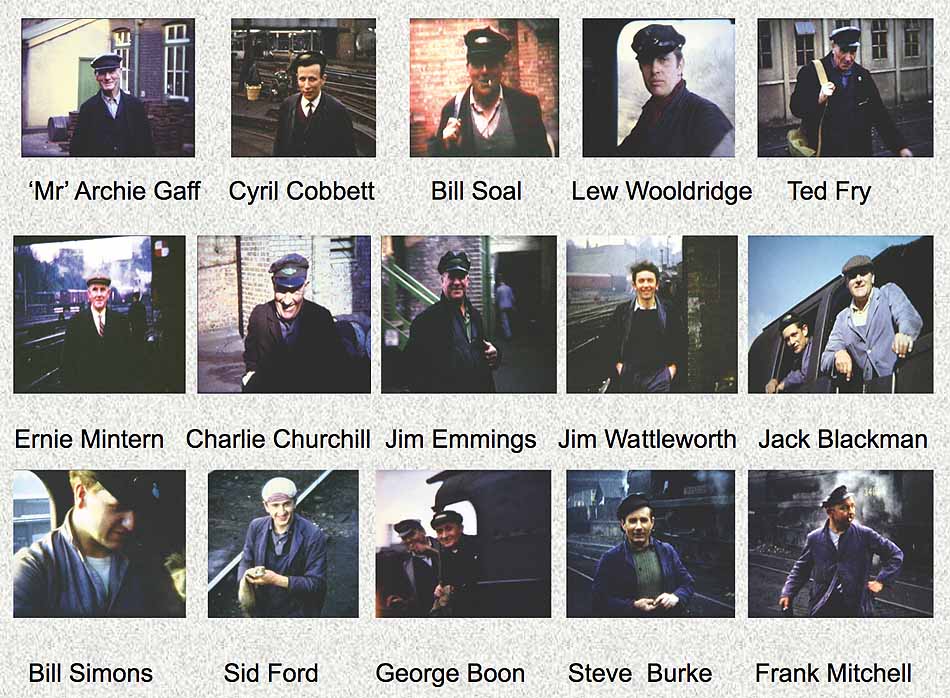(Below) The 50th Anniversary of the closure of Guildford Motive Power Depot and the end of steam on the Southern Region.
Retired railwaymen and steam fans gathered at Guildford railway station on Farnham Road bridge on Sunday July 9 2017 for the unveiling of a plaque to commemorate Guildford's engine shed that closed exactly 50 years ago.
In his speech to around 40 people who gathered at the pedestrian entrance to the car park, Geoff Burch said - 'It doesn't seem that long ago when Pat Kinsella and I departed from here aboard our respective locomotives BR Standard Class 5 Nos 73118 and 73155 to go light-engines to Salisbury, not forgetting the other drivers and firemen who left here that day. They were; the late Dave Elston, Bill Brain, Dave Bunce and Charlie Hampshire, all of whom have transferred to that great engine-shed in the sky.
This occasion was originally an idea of another old steam colleague, Bill Moore, who thought it would be a good idea for a few of us to meet up here and go for a drink afterwards. However, Bill Bunce, Pat Kinsella and I put our heads together and came up with an idea which has ended up a full-blown plaque unveiling ceremony!
This of course could not have been achieved without the help of Guildford Borough Councillor, Bob McShee. I must also thank the late Dave Salmon and Richard Greenwood MBE for providing the photographs that are etched on this plaque.
Also I must thank the following people who have generously made donations towards the costs of the plaque; without them, it wouldn't have been possible: They are - Don Ottignon (who is probably the oldest hand here today) - Pat Kinsella - Bill Moore - Ben Darnton (of Ben's Collectors Records) - Guildford Historian David Rose - Mick Stone - Charlotte, Emma and Ann Hampshire (in memory of Charlie Hampshire) - Barry Brockman (in memory of his father Arthur Brockman) - Terry Kerslake - Justin White - Malcolm (Mac) McCabe - Alan Newman - Dave Jackson (in memory of John Butt who was Shedmaster here when I graduated to become a fireman in 1962) - John McIvor - Ian Simpson - Geoff Ball - Guildford Rotary Club - Alan Nichols - Dave Bryce - Peter Blanthorn - an Anonymous Nine Elms Driver - Lew Wooldridge - George Michie - Neville Hodges - Jim Lester - Alan Cobbett - an Anonymous OSA Member - David Brown - Ian Barnett - Mick Rowswell and John Rowswell - Donald Baldwin - David Newbery - Allen Mansbridge - Brian Sessions - Tim Crowley (Traction Inspector from my firing days) - Ray Bartlett - Eddie Wells - Pat Evans - Tom Andrews - Bill Tickner - Derek Hayter - Bob Hunt - Alex McClymont - Bernie Knibbs - John 'Prof' Nicholson from the Keighley & Worth Valley Railway - and finally, there is Barry Slater ex-55G Huddersfield Driver and member of the Bahamas Locomotive Society.
Fortunately, we were still able to raise most of the funds as a result of the kind generosity of persons completely unconnected with the railway industry who genuinely believe that this place is still part of Guildford's heritage.
Now a little bit about our invited guest Richard Greenwood. Rochdale-born and bred and with railways in his blood, Richard attended the Law College at Guildford during 1961-62 whilst I was working here as an engine cleaner and young fireman.
With a keen photographer's eye, he captured hundreds of superb images of locomotives and I'm therefore indebted to Richard for his kindness in allowing me use a number of them in various books that I've self-published.
During the 1960s Richard led local opposition to the Beeching Axe when, almost at a stroke, Britain lost thousands of miles of its rail network. Richard has also been a member of the Keighley and Worth Valley Railway since 1964, two years after the five-mile branch line was closed by British Railways.
Thanks to a lot of hard work by Richard and other volunteers, the line was re-opened in 1968 - and it continues to be run by volunteers of the K&WVR Preservation Society ever since.
Richard was a director of the railway for more than 30 years and chairman for more than half that time. It also gave Richard a glorious opportunity to do what he liked doing best; driving USA Class 30072 (the very last steam locomotive to leave Guildford depot 50 years ago) along the Worth Valley from Keighley to Oxenhope.
Also, not forgetting his present locomotive 'West Country' class No 34092 City of Wells which at this moment is working on loan at the Bluebell Railway.
For his services to steam railway preservation, Richard was recognised in the Queen's new-year honours list in the year 2000, being awarded an MBE.
Finally, more than £1000 was raised and it was agreed that any money over and above the cost of the plaque would be donated equally to Woking Homes and the Phyllis Tuckwell Hospice, Farnham. I am pleased to say that £153.13 was donated to both...'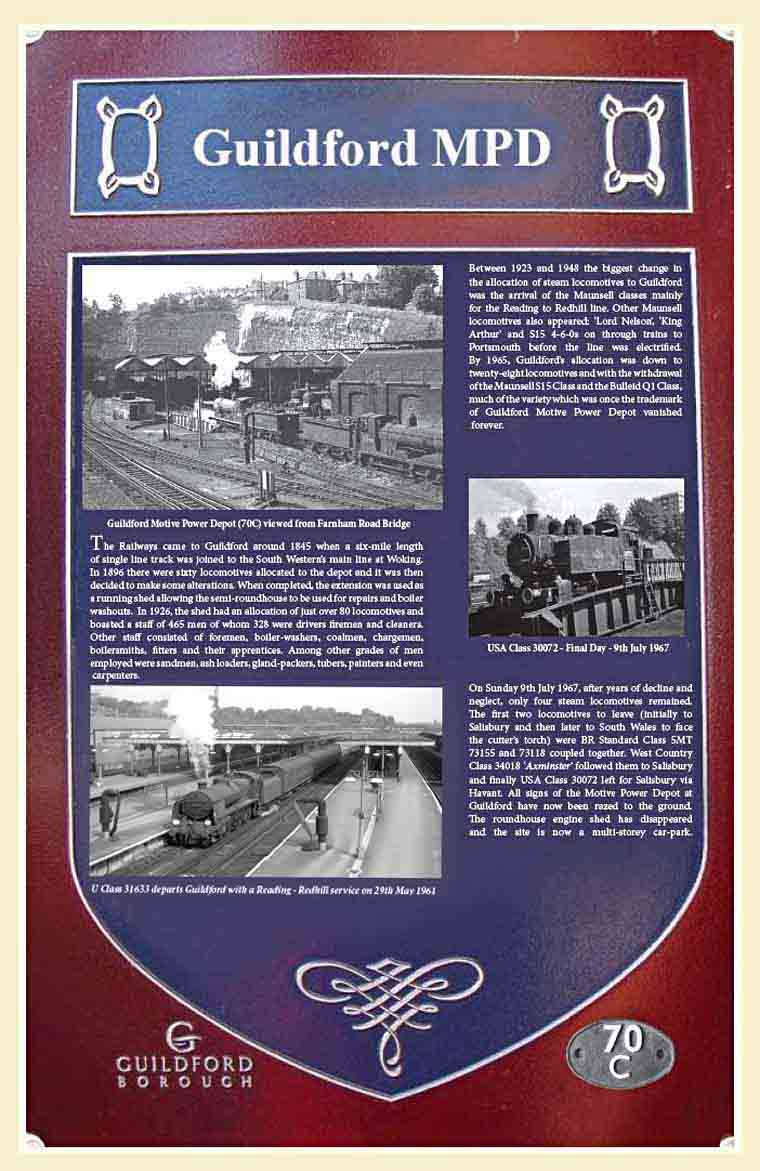
The last thing I want to do is to repeat everything that appears in my books otherwise you'll never buy them! Therefore I've added some extra photos on this page that were kindly contributed for publication but didn't quite manage to fit in. Since then, however, a large number of additional photos have been kindly contributed by such luminaries as David Rose, the Guildford Institute Archive, Pat Kinsella, Colour Rail, Jeffery Lloyd, Leigh Darnton, Malcolm Wyatt, Geoff Ball, Charlie Hampshire, Norman Hamshere, John Scrace, Ted Gamblin and Richard S Greenwood MBE.
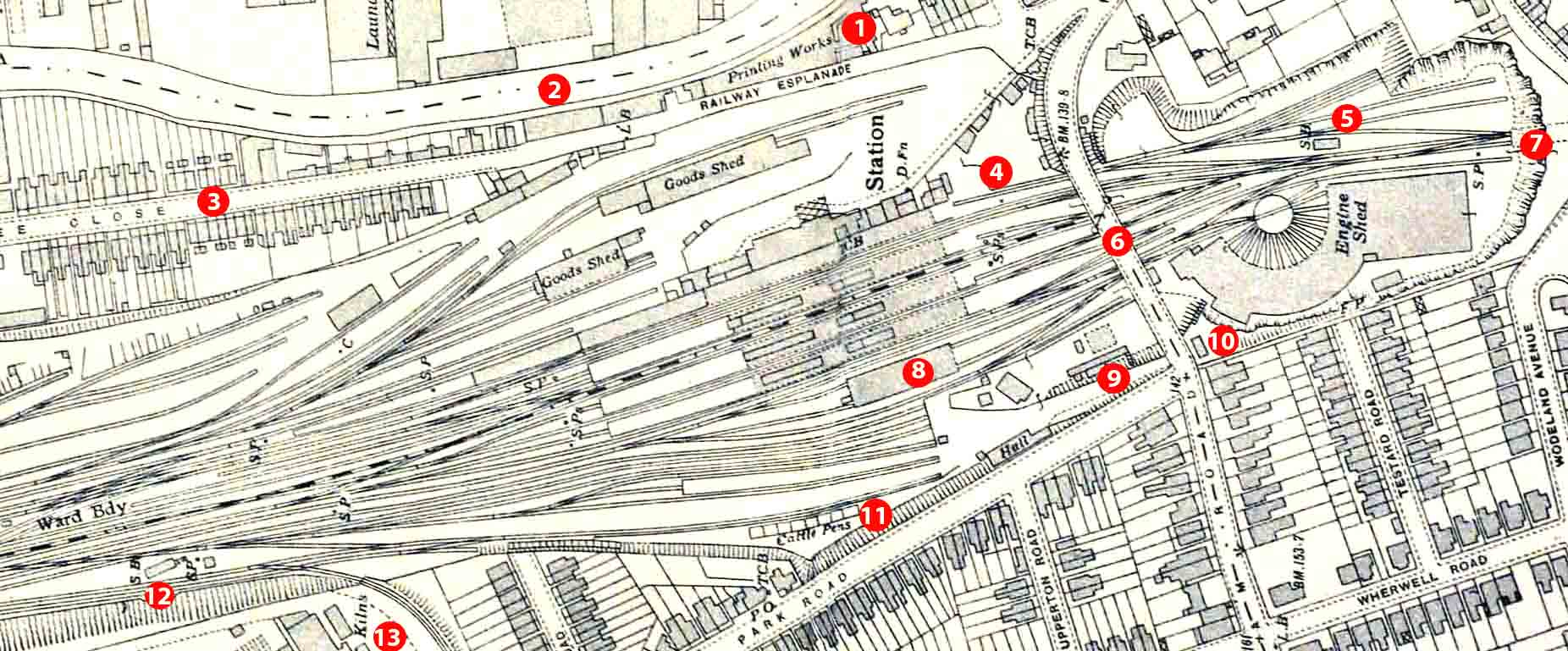
(Above) However we start the page with an interesting map of Guildford railway station and engine shed circa 1935; the map also shows the surrounding area which is scarcely recognizable today! Sadly there is a grubby fold running directly through the station area; I have digitally removed the worst of it and hope that it doesn't detract from what is an interesting historical document. The numbered circles are as followed: 1 Billing & Son Printing Works 2 River Wey 3 Walnut Tree Close 4 Site of 'Mobile' Canteen 5 Guildford South Signal Box 6 Farnham Road Bridge 7 Chalk Tunnel Portal 8 Coal Stage 9 Orphanage Hut 10 Canteen 11 Cattle Pens 12 Guildford North Signal Box 13 Brick Works. 
(Above-Below) What price nostalgia? From iconic railway posters to locomotive nameplates - all can found on the GWRA's excellent website HERE. For example, displaying good colour and shine, this BR Southern Region totem for Guildford station would grace anyone's collection; the lot went under the hammer for £460 at a GW Railwayana Auction in November 2014. (Below) Guildford station and town (looking in a Southerly direction) taken from a balloon in 1988. Notice all the trains shown are of EMU 'slam-door' 1963 stock. The passometer (walkway) across the station which also links Guildford Park Road is also receiving a facelift. 
THE HISTORY OF GUILDFORD STATION
One of the joys of producing a webpage is that it can be changed as you go along, and unlike the constraints of book publishing a webpage can be updated whenever any new material turns up thanks to the generous help of contributors. Therefore it seems appropriate to revamp this page with a number of  previously unpublished photos I have received and begin with a potted history of Guildford Railway Station and Guildford Motive Power Depot dating back almost 170 years…
previously unpublished photos I have received and begin with a potted history of Guildford Railway Station and Guildford Motive Power Depot dating back almost 170 years…
The original station at Guildford was opened by the London and South Western Railway (LSWR) on 5th May 1845 when a six-mile length of single line track was constructed to connect with the London & South Western's main line at Woking; this was followed by another line from Redhill and yet another line was built to join with Farnham and Alton. In 1849, a further branch to Farnham was opened at Ash Junction plus the 'through running' of trains commenced between Redhill, Guildford and Reading; indeed the single line from Ash Junction to Farnham played a big part in establishing Aldershot as the country's most important army camp.
In 1859, Godalming ceased to be the end of the short branch line when the Portsmouth Direct line was completed. This was followed by a 15½ mile single track branch from Horsham with a passing loop at Baynards (with additional loops installed later at other stations). This line ran from Stammerham Junction to Peasmarsh Junction where it joined the Portsmouth Direct line just south of Guildford. The last new route to be constructed to Guildford was the L&SWR's 'New Guildford Line', which is still called the 'New Line' to this day...continued below.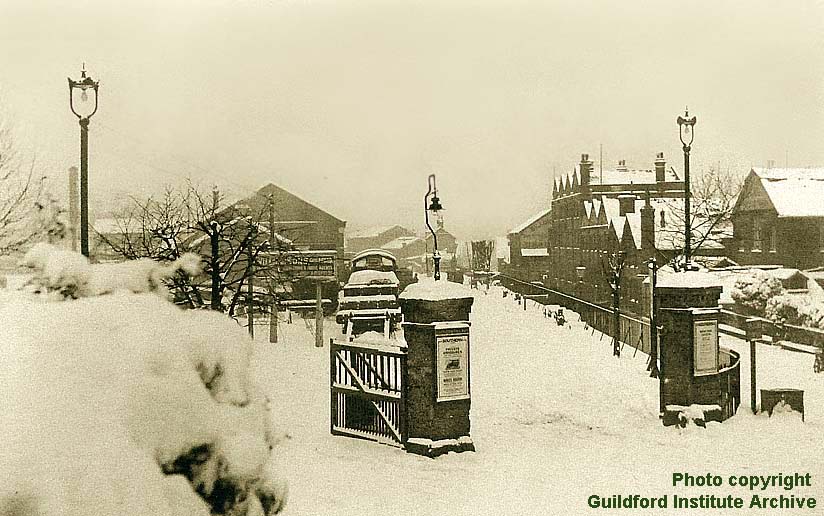
(Above-Below) This photograph from the Guildford Institute Archive shows the view through the main gates of Guildford station in the depths of winter (date unknown). The station is on the left, the goods shed in the middle and Walnut Tree Close on the right flanked by the Billing & Son Printing Works. Note the tracks with buffer stops running past the goods shed. A similar viewpoint in 1967 appears in Jeffrey Lloyds gallery - 'Memories of Guildford Station 3' - further down the page. (Below) Men and machines! Adams X2 Class 594 and enginemen stand proudly in the old shed at Guildford. I haven't been able to date this photograph, but the locomotive was built in March 1892 and withdrawn in 1930. 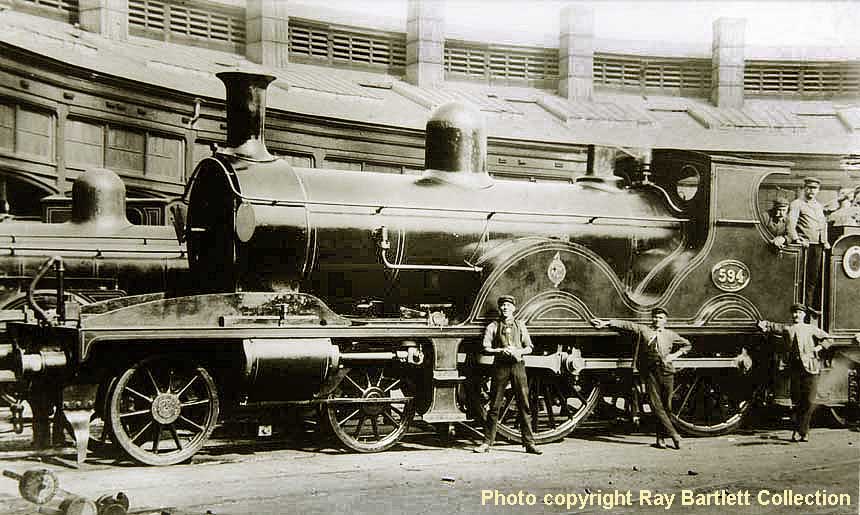
By the mid-1860s Guildford station had developed into an important junction of lines and appropriately named Guildford Junction. A twin-gabled train shed spanned the centre of the five platforms and a covered footbridge was erected along with a two-road engine shed. This was built on the eastern side of the station, with a turntable at the southern end. The majority of the goods workings were local in nature; pick up goods dominated but there was also a reasonable amount of cattle and sheep traffic (Guildford having its own cattle market nearby). The cattle pens were situated on the eastern side of the station beyond the coaling stage. The Downs bordering the lines were home to a number of horse racing stables and the movement of thoroughbred horses was commonplace, as was parcels traffic, much of which was conveyed in vehicles attached to passenger trains.
(Above) When the L&SWR lines first opened to Guildford the bulk of the motive power was made up of the company's early locomotives. A legacy of the LSWR is this 700 Class (Black Motor) 692 seen here on the Old Pit waiting to be placed in the shed. A shedman is busy cleaning out the ash from the pit below. This class of thirty 0-6-0 tender engines were designed for freight work by Dugald Drummond in 1897 for the London and South Western Railway and built by Dubs and Company at the company's Queen's Park works at Polmadie, Glasgow.
With the ever increasing traffic from the 'New Line' and Horsham Line in the mid-1880s, the original engine shed at Guildford was demolished to allow for rebuilding the station. The number of platforms was increased to seven, a subway was built and each platform was provided with a canopy. In order to provide sufficient space for a new engine shed, the chalk pit situated south of the Farnham Road bridge was enlarged to accommodate a semi-roundhouse with thirteen roads radiating from a 50ft turntable. The new brick built depot opened in 1887, however owing to the restricted space, the site of the coaling stage and ash pits had to be built opposite the station and the prevailing south west winds often blew smoke, ash and grit towards the station much to the annoyance of passengers. In 1896 sixty locomotives were allocated to the shed, hence a decision was made to build a seven straight road shed capable of housing three tender locomotives. When completed, the extension was used as a running shed allowing the semi-roundhouse to be used for repairs and boiler washouts.
In 1904, two new hydraulic cranes were provided for the coaling stage and a 55ft turntable was installed. The semi-roundhouse shed required a small locomotive as the shed pilot and several locomotives took their turn in performing this task. The motive power depot at Guildford continued to grow in importance following grouping in 1923 as the trains from Guildford to Havant, Horsham, Redhill and Reading remained steam hauled. In 1926, the shed had an allocation of just over 80 locomotives and boasted a staff of 465 men of whom 328 were Drivers and Firemen. Other staff consisted of foremen, boiler washers, coalmen, chargemen, boilersmiths, fitters and their apprentices. Among other grades of men employed were sandmen, ash loaders, gland-packers, tubers, painters and even carpenters - continued below...
(Below) This is Guildford Up Yard Dock showing the cattle pens and various types of rolling stock from different railway companies. The Passometer (footbridge) had recently been installed which gave access to the station from Guildford Park Road as well as the main entrance. Guildford's two gas towers can be seen in the background. 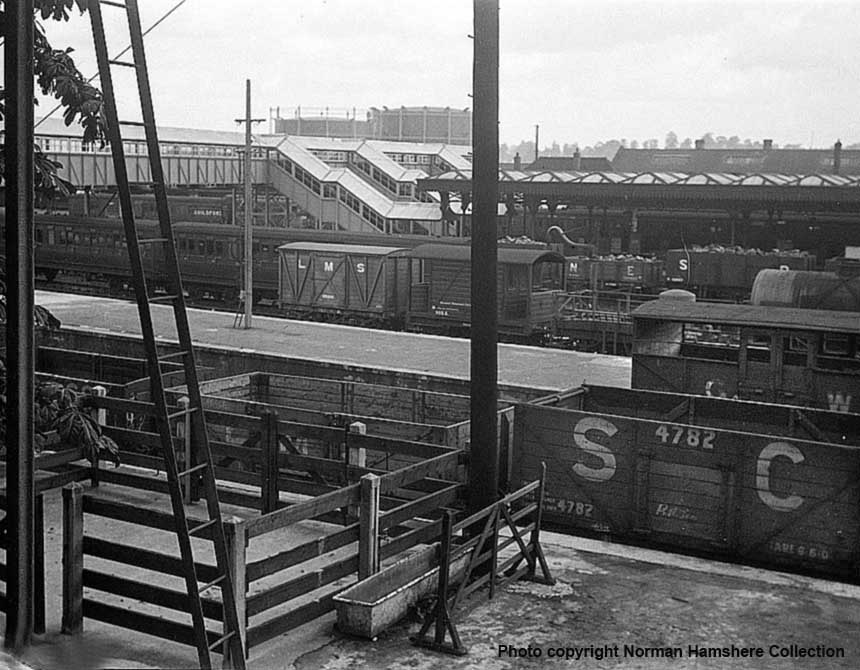
(Below) This photograph of Guildford Shed is an absolute classic! Since I haven't any idea what class of locomotive it was I contacted Mike Morant who replied - 'One has been fortunate. I won a set of the Bradley LSWR locomotive books in hardback at auction earlier this year and your enquiry typifies the reason why I've long wanted them. According to Bradley No 407 was a standard 'E' class Manning Wardle 0-4-0ST originally purchased by Relf of Okahampton in March 1876 and named 'Pioneer'. She was used with sister engines in the construction of the line from Meldon Junction to Holsworthy. 'Pioneer' was bought from Relf by the LSWR in 1881 and was based at Plymouth where she worked until December 1891 after which there followed a period in storage at Exmouth Junction. Then, late in 1892, she became the Guildford shed pilot until mid-1897 being replaced by a Beattie well tank. 407 then became the temporary shunter on the newly completed Waterloo & City. There's a bit more intermediate history but somewhat surprisingly 407 was again allocated to Guildford as shed and coal stage pilot. With a clapped out firebox she was eventually withdrawn from service in 1919 and scrapped at Eastleigh in 1921...' Thanks Mike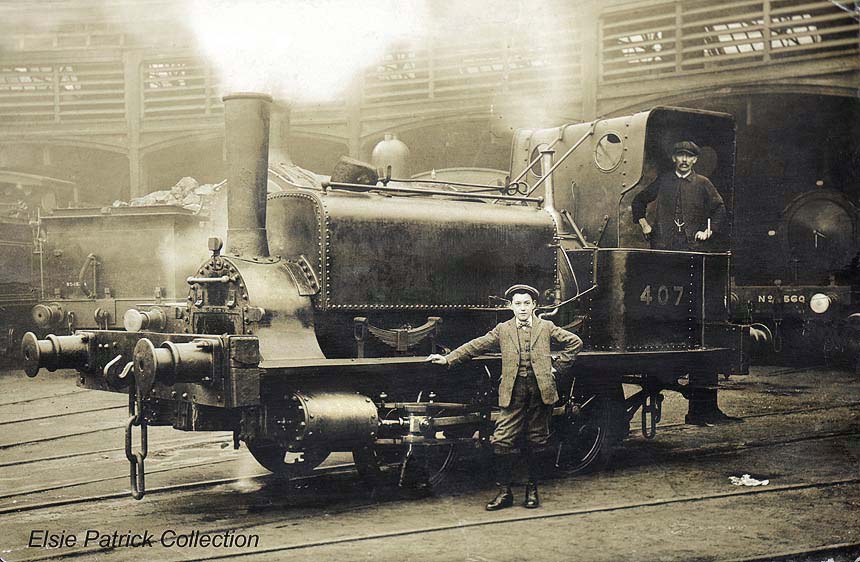
Following Maunsell's retirement in 1937, Bulleid took over the reign as Chief Mechanical Engineer of the Southern Railway, and his Class Q1 0-6-0 (coffee pot) became synonymous with Guildford. The infrastructure of the shed was again updated between 1933 and 1934; the coal stage was replaced and electric cranes were installed to ease the task of coaling locomotives. Improvements were also made to the approach roads and pits to rationalise movements in and around the shed. Between 1923 and 1948 the biggest change in the allocation of steam locomotives at Guildford was the arrival of the Maunsell classes - especially the 2-6-0s. By 1933, the shed boasted 25 U class Moguls, mainly for the Reading to Redhill line and 26 M7 0-4-4s. Other Maunsell locomotives appeared: 'Lord Nelson', 'King Arthur' and S15 4-6-0s on through trains to Portsmouth before the line was electrified.
I must mention the stunning images from the NMSI collection as it shows the superb artwork commissioned by the 'Big Four' railway companies and later British Railways for posters across the country. The NMSI family is comprised of four award-winning museums, each with their own diverse identity: the Science Museum, the National Media Museum and, of course, the National Railway Museum (NRM) at York which houses the world's pre-eminent railway collection. The Science Museum at Swindon is a massive site housing collections ranging from the iconic Lockheed Constellation airliner to super computers, bicycles and the last Fleet Street printing press, however the NMSI's full collection is so big that only 8% of the artefacts are on public view. The rest are hidden-away at an ex-WW2 airfield just off the M4, but enthusiasts are amply compensated with the NMSI Collections Online; a superb website displaying thousands of objects including a range of fabulous railway SR travel posters...click here...a visit is highly recommended.  (Inset Left) This Southern Railway poster - 'Electrification!' by T D Kerr was published in 1925 to advertise improvements to rolling stock and infrastructure. The image features several electric multiple unit trains, a signal gantry and viaduct. The text reads - '700 miles of Southern Railway will be electrified by spring next year. 3 new sections open this summer. 3 electric for every steam train now running. Total Cost £8,000,000, Southern. The World's Greatest Suburban Electric.' At the top and bottom of the poster six-car electrical multiple units are depicted.
(Inset Left) This Southern Railway poster - 'Electrification!' by T D Kerr was published in 1925 to advertise improvements to rolling stock and infrastructure. The image features several electric multiple unit trains, a signal gantry and viaduct. The text reads - '700 miles of Southern Railway will be electrified by spring next year. 3 new sections open this summer. 3 electric for every steam train now running. Total Cost £8,000,000, Southern. The World's Greatest Suburban Electric.' At the top and bottom of the poster six-car electrical multiple units are depicted.
(Below) Tar-rah! With bunting flying behind the gates to Guildford station and surrounded by a huge crowd of onlookers old and young alike, the Guildford Town Cryer, Albany Peters, reads a proclamation of the new electric train service on 9th July 1925. The new third-rail 660vdc electric multiple units (EMUs) were introduced on the Western Section from Waterloo to Dorking North and to Effingham Junction via Epsom, and to Guildford via Claygate and Effingham Junction; the first service arriving at Guildford on 9th July 1925. The Southern Railway adapted the design of the original LSWR EMUs as the basis for its own standard suburban sets, which like the LSWR were formed of three cars made up of two driving motors and a trailer composite in between. The first batch of 55 units was built in 1925 by two companies - the Birmingham Railway Carriage & Wagon Co Ltd and the Metropolitan Carriage, Wagon & Finance company. Twenty six of the units were for the western section with the remainder for the eastern section; the latter having 62 foot 6 inch underframes as opposed to the 57 foot underframes of the western section units. All electrical equipment was provided by Metropolitan Vickers.


(Above) With platform 1 crowded with spectators, the first electric passenger service arrives at Guildford on the 9th July 1925. The train headed by Unit No. 1295 has travelled from Waterloo to Guildford via the New  Guildford Line' via Cobham. The early Southern Railway EMU stock used an alpha route indicator which was mounted on a single width fret and clipped to the illuminated middle panel on the front of the motor or trailer driving car- in this case the letter 'H'. Unfortunately, because the braking system of these new electric trains (Westinghouse Air-brake) was different in operation to the Vacuum brake (which was fitted on steam engines); three separate incidents occurred at platform 1 at Guildford within the first month of operation - all due to Driver error. Luckily, these incidents were only minor and there were no injuries...my thanks to Pru Chambers of the Guildford Institute for allowing me to reproduce these photographs from their archive. Click here to visit the Institute's fascinating website.
Guildford Line' via Cobham. The early Southern Railway EMU stock used an alpha route indicator which was mounted on a single width fret and clipped to the illuminated middle panel on the front of the motor or trailer driving car- in this case the letter 'H'. Unfortunately, because the braking system of these new electric trains (Westinghouse Air-brake) was different in operation to the Vacuum brake (which was fitted on steam engines); three separate incidents occurred at platform 1 at Guildford within the first month of operation - all due to Driver error. Luckily, these incidents were only minor and there were no injuries...my thanks to Pru Chambers of the Guildford Institute for allowing me to reproduce these photographs from their archive. Click here to visit the Institute's fascinating website.
(Inset right) Twelve years after the arrival of the new EMUs at Guildford, this SR poster - 'New Extensions', by John Chater was published in 1937. The artwork features a permanent way gang lowering a rail into position. The text gives details of the electrification planned from July 1937 to 1940, including work on the London to Portsmouth lines via Guildford and Horsham, lines to Staines, Reading, Ascot to Aldershot & Guildford, Sevenoaks to Hastings and Bexhill, and lines to Kent. In the event the SR's electrification scheme was delayed by the Second World War. 
(Above) This Southern Railway poster from the NMSI Collection Online features a painting by D W Burley depicting fields, woods and hills at Worplesdon in Surrey, published in 1936. The poster promotes the sale of plots of building land near the railway station serving the village of Worplesdon. The scene is probably Burdenshot Hill, a strip of land to the west of the station. Today there are about ten house built there with an elevated view of Whitmore common - each costing at least £1m-£2m each. The foreground was once a factory that made artificial stone; the factory has long since gone but some stonework is still evident under the surrounding bushes. The Company went bust when they found that the crumbling stone they made for a bridge wasn't as strong as it was 'cracked' up to be! 
(Above) Following the death of her father, Roland Projetti, a devoted Southern Railway draughtsman for many years, Georgina McColl and her husband James began clearing out her late father's house and came across a set of wonderful Railway Gazette supplements highlighting the expansion of electrification by the Southern Railway in the 1930s and passed them onto me. The art-deco artwork depicted on the front covers are striking and I can see why Roland had kept them all these years.
Following WW2, Roland joined the Southern Railway as a draughtsman and was employed at Southern House, Croydon, where he was wholly dedicated to his job; his forte being the Southern Railway's signalling systems. During his career Roland was responsible for creating thousands of drawings and schematic blueprints for internal publication. Georgina and James also presented me with quite a number of signalling books and other railway paraphernalia that Roland had kept of that era.
This prompted me to reproduce extracts from the Railway Gazette's June 1937 electric traction supplement featuring the Southern Railway's London-Portsmouth electrification scheme, starting with a diagram (below) of the newly electrified tracks between Hampton Court Junction and Portsmouth, the Woking to Alton line and the Egham ans Staines branch. This excellent map also shows the positions of the substations and track paralleling huts.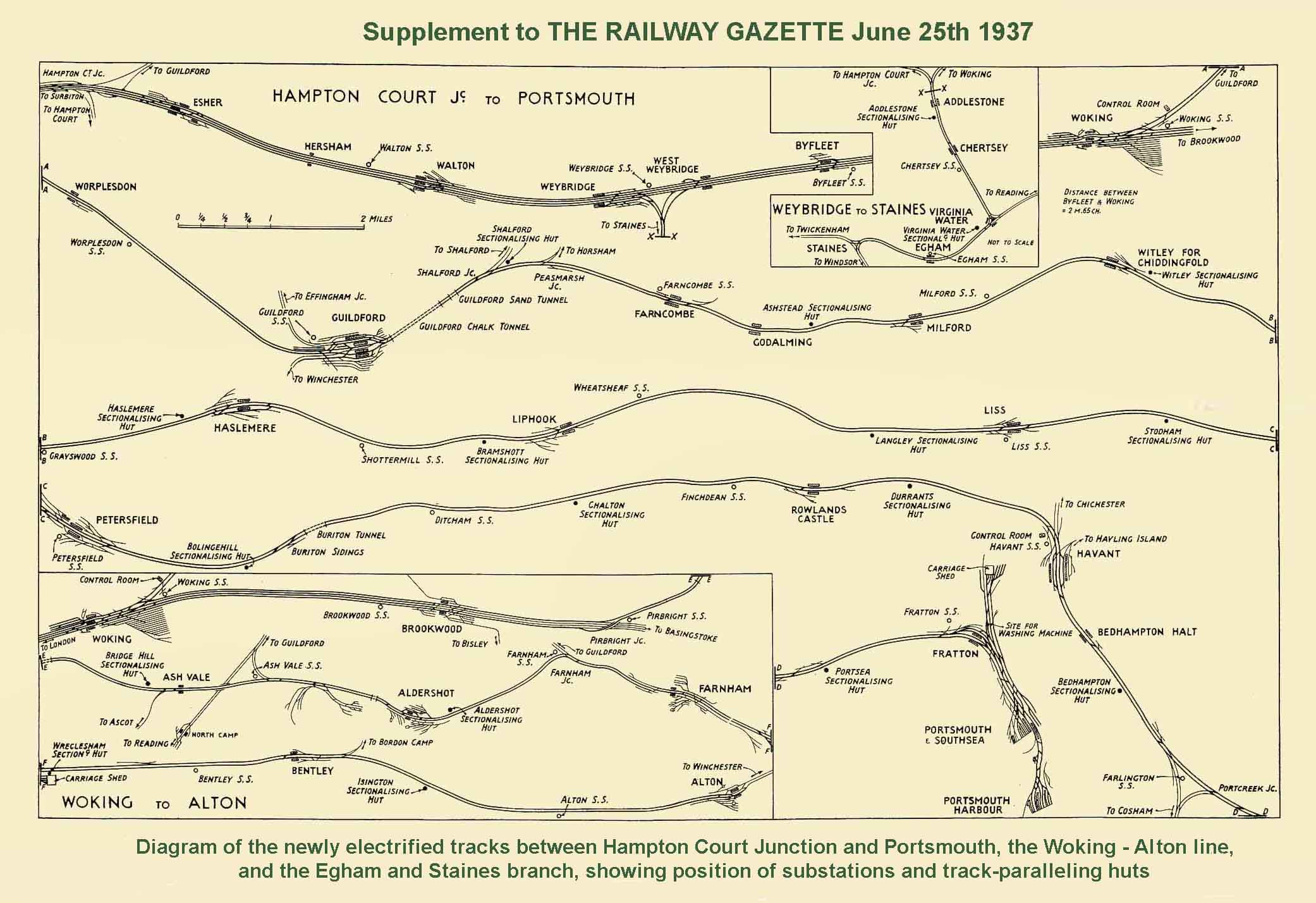
(Insets below left and right) The clarity of the map allows us to reproduce enlarged sections, starting with Hampton Court Junction which can be found in the top left-hand corner of the map and the triangular junction at Weybridge, located in the top centre on the route to Woking. This junction was quite often used  by Guildford footplate crews to turn locomotives that were too large to be turned on the turntable at Guildford MPD, eg Bulleid's West Country, Battle of Britain and Merchant Navy Pacific class locomotives. The Salisbury based engines would work stone trains from Meldon Quarry to Woking Yard and the locomotive would then run 'light engine' to Addlestone Junction, run 'tender first' round the curve to Weybridge and then run 'engine first' to Guildford MPD for disposal. A further crew would then run light engine 'tender first' to Woking Yard and work the stone train
by Guildford footplate crews to turn locomotives that were too large to be turned on the turntable at Guildford MPD, eg Bulleid's West Country, Battle of Britain and Merchant Navy Pacific class locomotives. The Salisbury based engines would work stone trains from Meldon Quarry to Woking Yard and the locomotive would then run 'light engine' to Addlestone Junction, run 'tender first' round the curve to Weybridge and then run 'engine first' to Guildford MPD for disposal. A further crew would then run light engine 'tender first' to Woking Yard and work the stone train 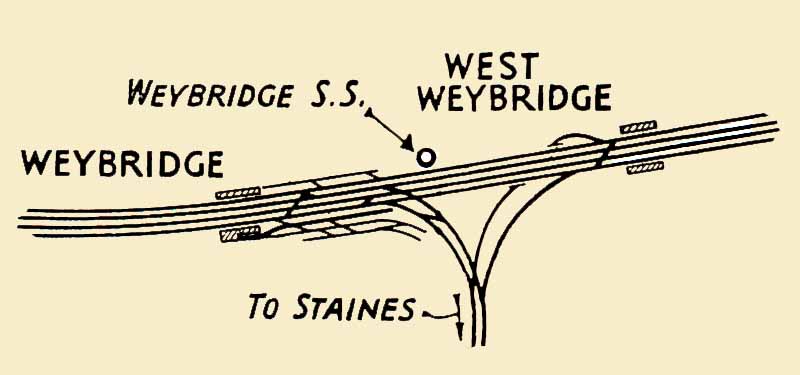 empties back to Salisbury.
empties back to Salisbury.
(Below) This view shows construction work at Hampton Court Junction circa 1915. The photographer is standing in the 'fourfoot' of what is now known as the 'New Line' to Guildford via Cobham. The flyover would eventually allow down trains to pass over the top of main lines to Thames Ditton and Hampton Court. Trains terminate at Hampton Court to return to Waterloo and this is still the case. The 'New Line' was electrified using the 650 V DC third rail system as far as Claygate in 1916 and for the full route to Guildford in 1925. The locomotive on the train is LSWR A12 (527) / O4 Class 0-4-2 No.620, designed by William Adams and these locos were popularly referred to as 'Jubilees' due to the fact that they were introduced during the fiftieth year of Queen Victoria's reign.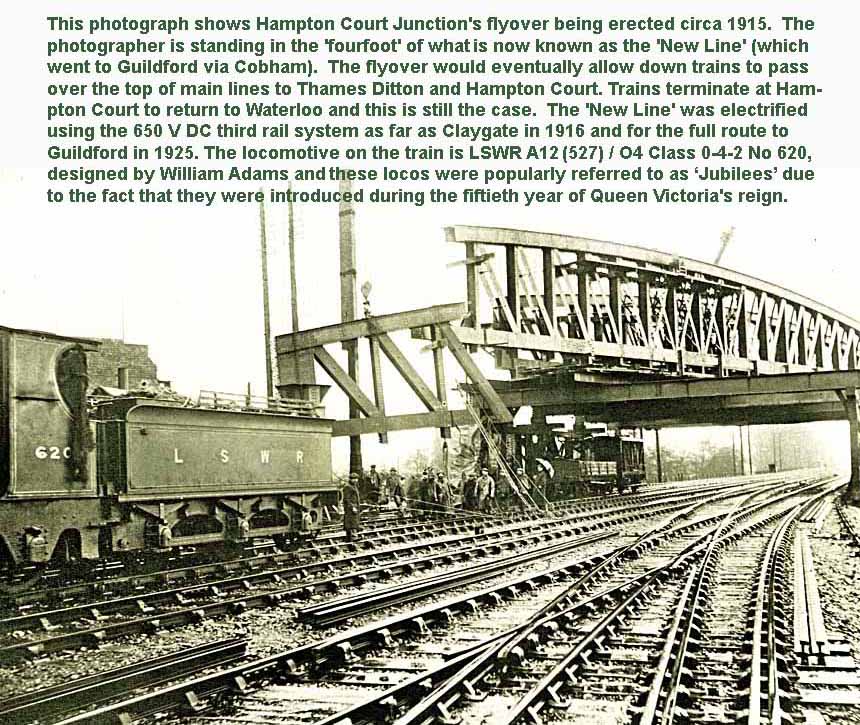
London-Portsmouth Electrification
Southern Railway
Overview
In 1935, a decision was announced to electrify the Portsmouth and Aldershot routes. The electrification (Hampton Court Junction to Portsmouth Harbour, Woking to Alton and Weybridge to Staines) comprised but a part of the Southern Railway's conversion programme. The line from Godalming to Havant, built very cheaply followed the lie of the land with long 1-80 gradients was not conducive to easy locomotive working or strict punctuality in the heavy summer traffic to Southsea, Hayling Island and the Isle of Wight. Thus, the operating benefits of electrification were of great importance as an electric train could maintain relatively high uphill speed and accelerate quickly from signal checks on difficult parts of the line. The estimate cost of the conversion showed a cost of £3,000,000, equivalent to about £31,000 per route mile and about £12,000 per track mile which were very low figures considering this included 312 new or rebuilt motor-coaches and trailers. An interesting feature of the Portsmouth electrification was the rapidity with which the conversion work was accomplished. From June 1935 when instructions to proceed were given, 26 substations were built and equipped and 242 track miles were electrified in 20 months and electric trial trains began to run on 8th March 1937. As an illustration to the intensity of the erection work, three complete substations and equipment were unloaded per month, each equipment train comprising 18 wagons complete with a 36-ton 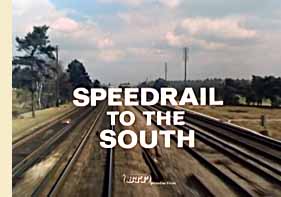 breakdown steam crane and brake van.The unloading was normally carried out over a weekend period from 11pm on Sunday and 04.30am on Monday. During the period between December 1935 and November 1936, 188 cable trains were employed in laying 309 miles of single-core 33kV cable and 218 miles of pilot cable.
breakdown steam crane and brake van.The unloading was normally carried out over a weekend period from 11pm on Sunday and 04.30am on Monday. During the period between December 1935 and November 1936, 188 cable trains were employed in laying 309 miles of single-core 33kV cable and 218 miles of pilot cable.
(Right) Footnote: Here's a nice little film posted on You Tube by Beulah 22. Just ten minutes long, 'Speedrail to the South' is a BTF promotional film from 1967 which features the type of 4REP + TC and Class 73 + TC formations I used to drive when at Woking MT as a driver. It starts off with a driver and fireman on a WC/BB Class doing their stuff...ah, memories! Click HERE for to visit You Tube... 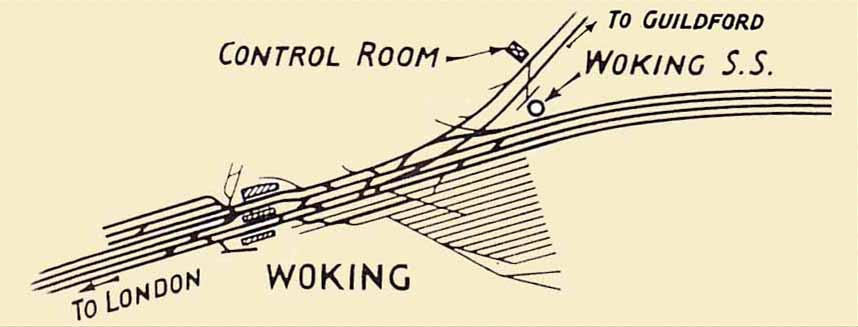
(Above-Below) One of the anomalies of featuring the Southern Railway's map of the London-Portsmouth electrification scheme is that it is essentially a storyboard illustrating the journey from London to the south coast, therefore it has been drawn upside down with the compass points 'north' and 'south' reversed. Below is a conventional view of Woking Signal Box and associated Track Diagram with north at the top. During my firing days at Guildford Loco (and subsequent move to Woking when steam ended in July 1967), the signals and track diagram shown were much the same as depicted. The Up Bay was still in existence (now forms part of a bus station) however, the Down Yard exit to the main line was altered, the exit points and ground signal being moved further south towards the station.---Automatic signals (those being controlled by the running of trains utilising track circuits) were prefixed with the letters WA (Whiskey-Alpha) and Waterloo signal box signals being prefixed with the letters WB (Whiskey-Bravo). Signals belonging to Woking signal box were prefixed with the letters WV (Whiskey-Victor), Worplesdon's signals were prefixed with the letters WW (Whiskey-Whiskey) and Guildford's signals prefixed with the letters WX (Whiskey X-ray). 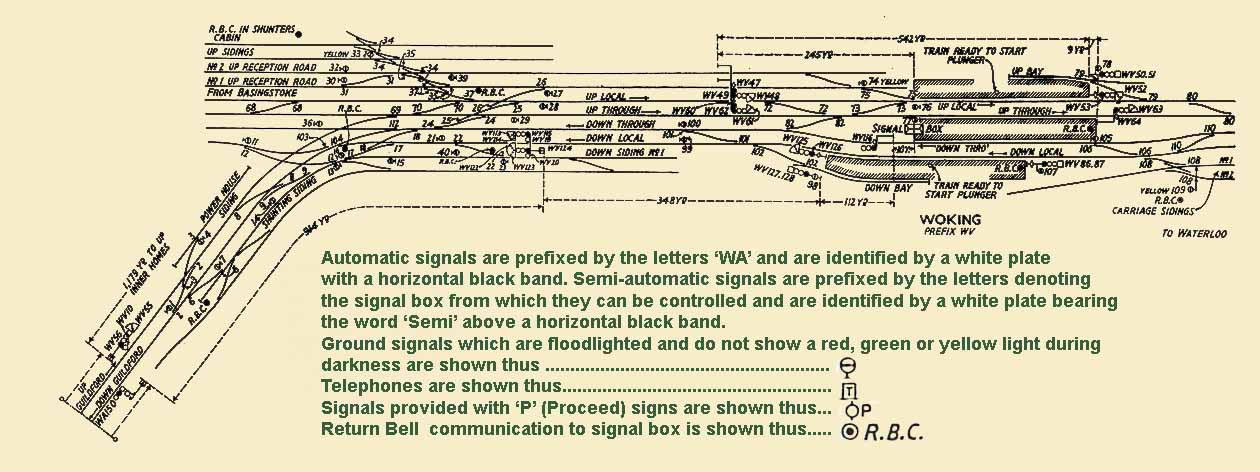
(Below) Guildford railway station is at one of three main railway junctions on the Portsmouth Direct Line. It provides an interchange station for three other railway lines: the North Downs Line northwards towards Reading, with a connection to Aldershot; the same line eastwards to Redhill, and the New Guildford Line, which provides an alternative route to Waterloo via Cobham or Epsom. Guildford station is larger, more frequently and more diversely served of the two stations in Guildford town centre, the other being London Road (Guildford) on the New Guildford Line, however its London services operator is the same. This view of Guildford from Yorkies Bridge in July 1961 shows a Redhill to Reading passenger service leaving Guildford headed by an unidentified U class locomotive that will call at Ash, North Camp, Farnborough North, Blackwater, Sandhurst Halt, Crowthorne Wokingham, Earley and Reading. Heading the other way towards Guildford station is a passenger service from Ascot (via Aldershot) consisting of 2 x 2-BIL units. In the Up Yard, the resident 350hp shunter waits for its next shunting duty and a light locomotive is waiting to leave the loco reception road bound for Woking. Another 2-BIL unit is berthed in the middle siding and a passenger service consisting of 2 x4-SUB stock is about depart No 1 platform with a passenger service for Waterloo via Cobham (New Line). Note that although all of the station's starting signals were now 3-aspect colour light, the starting signal at the end of No 1 platform, an upper quadrant semaphore signal remains. This is a super-wide image - click on picture once then a second time to see full size.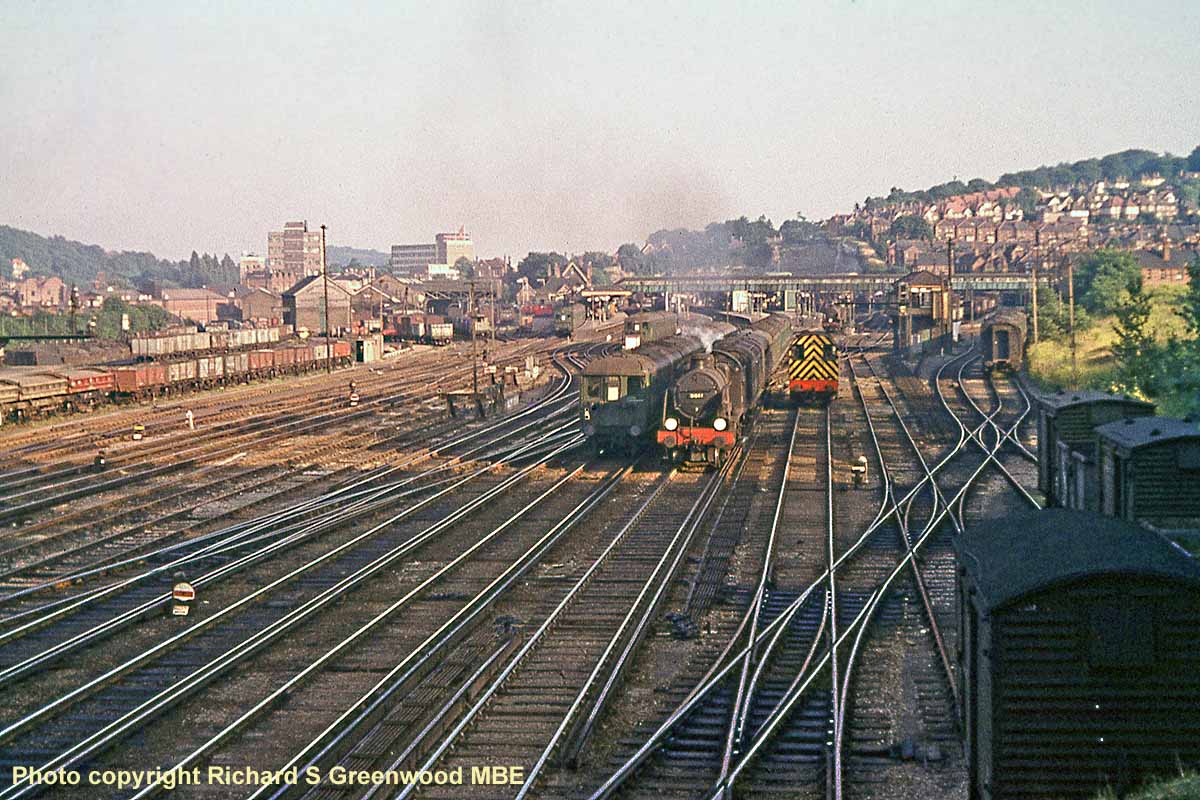
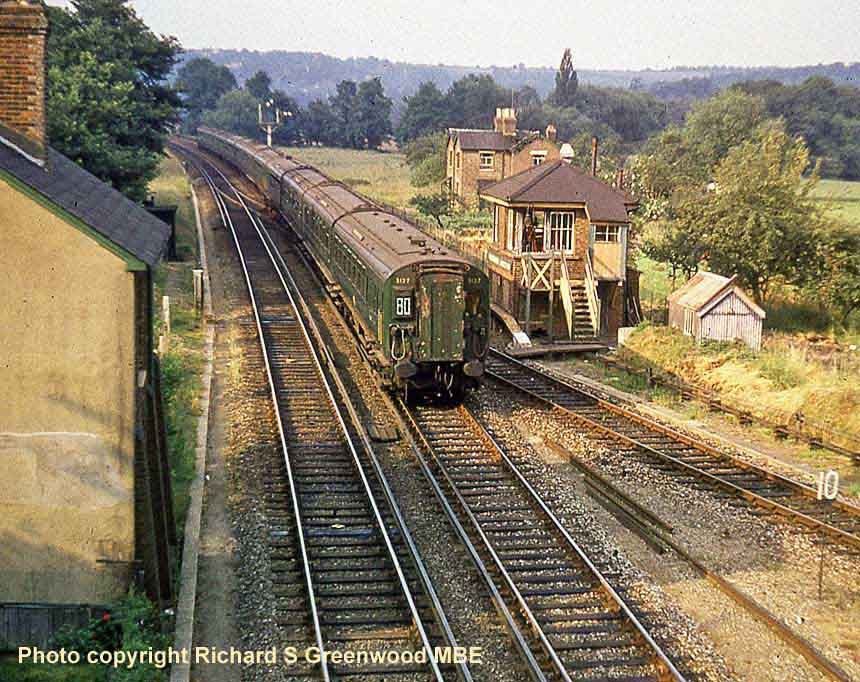
(Above-Below) At Peasmarsh Junction, a Waterloo-Portsmouth train formed of three of the iconic 4-COR electrics was photographed on 20 June 1961. (Below) This blown-up section of the Railway Gazette's June 1937 electric traction map shows both Shalford Junction and Peasmarsh Junction. Shalford Junction was the point where the non-electrified line branched off the Portsmouth Direct line towards Shalford and onwards towards Redhill via the picturesque North Downs. Peasmarsh Junction was the point where the non-electrified single line branched off to Bramley and Cranleigh and continued to Christ's Hospital and Stammerham Junction where it joined the main line to Horsham.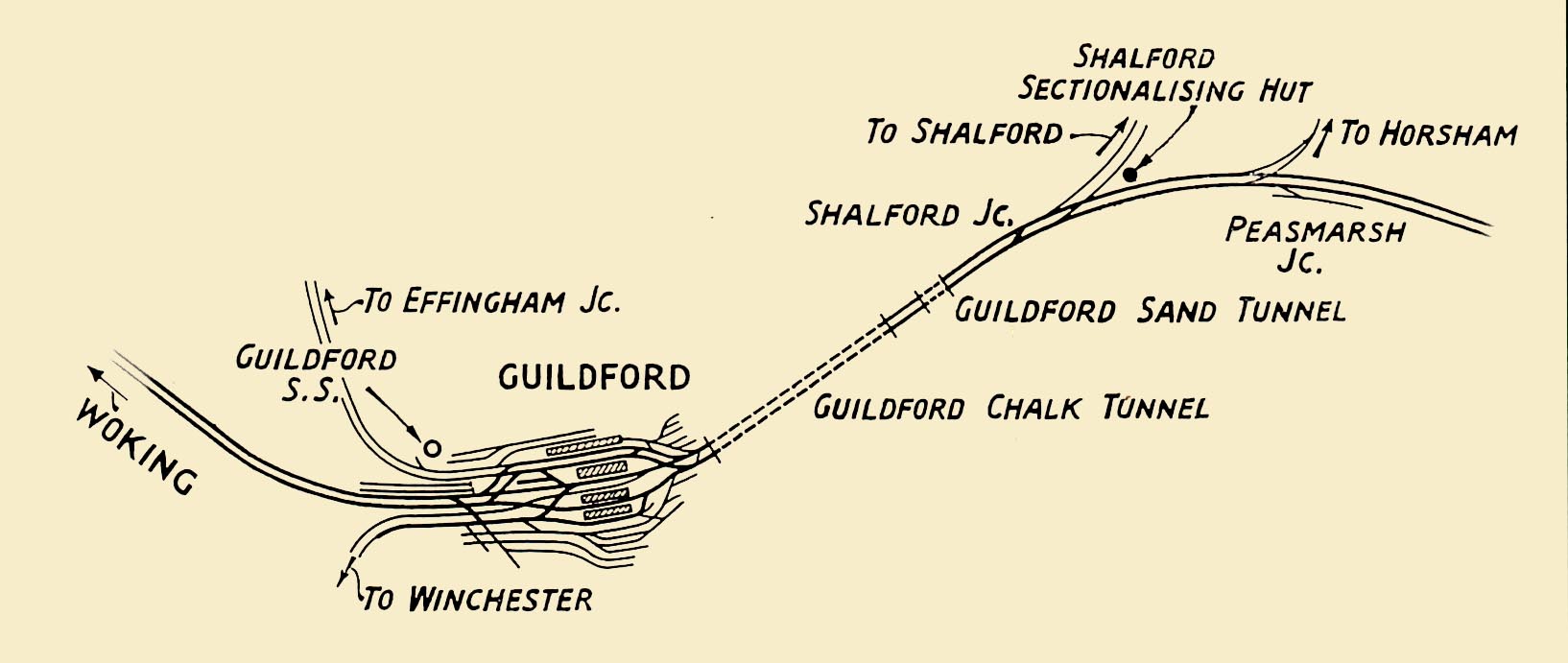
Supply and Distribution
For the operation of the new electric services the power supply was obtained from the Central Electricity Board's grid substations at Byfleet and Portsmouth (Wymering). In addition, the railway had its own existing 5000kV generating station at Durnsford Road, Wimbledon. The increased traction supplies in the Western suburban area had been provided by an additional rotary converter substation at Durnsford Road, the equipment taken from the existing substation at Guildford where a rectifier had been installed. The grid supply was made available at33kV. Three-phase 50 cycles and distributed to unattended substations a 33kV. ring main cable system where mercury arc rectifiers converted the electrical energy to 660 volts d.c. The high  tension and pilot cables were run in wooden troughs supported on concrete posts (except in cases where conditions necessitated the cables to be run on concrete ducts at level crossings and stations).
tension and pilot cables were run in wooden troughs supported on concrete posts (except in cases where conditions necessitated the cables to be run on concrete ducts at level crossings and stations).
(Inset-Below) The track apparatus, cases, insulated rail joints, impedance bonds, negative return bonds and positive connecting feeders for third rail electrified lines can be seen in the inset left. (Below) Designed by HG Ivatt in collaboration with the English Electric Co (the company supplied the 16SVT Mk 1 engine, generator and traction motors) the first of the pioneering LMS Co-Co twins, No 10000, was unveiled at a ceremony at Euston station on December 18th 1947. This splendid photo from the Rail Photoprints archives HERE shows the 1,600hp diesel electric locomotive passing Dunsford Road Power Station with the 1.00 Waterloo-Exeter service on 20th May 1953.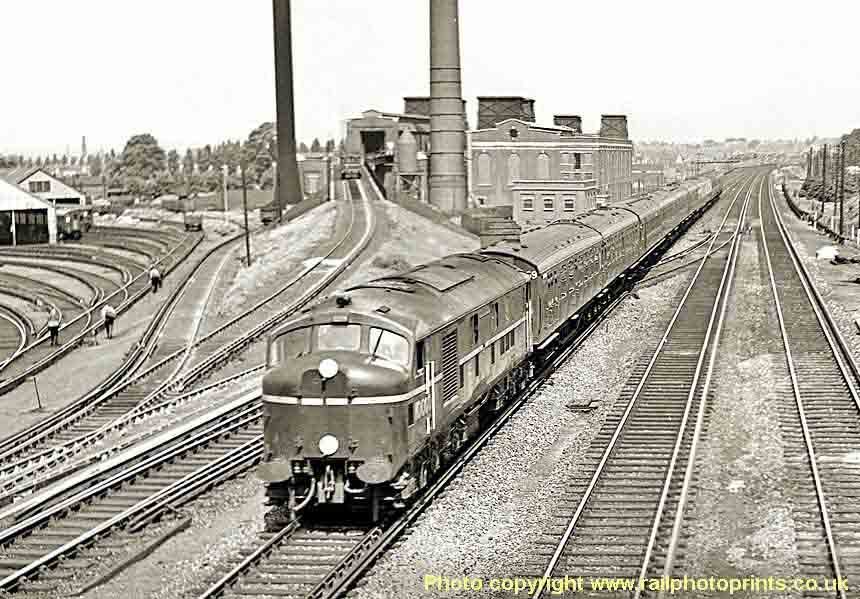
Substations.
In all, 26 substations and 18 track-paralleling huts were remotely controlled from two control rooms situated at Woking and Havant respectively. Woking control room controlled the area north of Liss and substations south of that point were controlled by Havant. (Below) Finchdean substation.
Conductor Rails & Track Equipment
The conductor rails were of the Southern Railway standard, flat-bottomed section and were supported on porcelain insulators of which there were generally 620 insulators to the mile. The 60-ft length rails were bonded together by four copper bonds. The negative return traction circuit was provided by the running rails, each point of which was bonded by two bonds; one protected type bond inside the fishplate and one welded bond. Sections of the conductor rail could be isolated by means of a hook switches that were provided between the feeders and the conductor rails. Track paralleling huts were placed midway between substations and contained groups of high-speed circuit breakers depending on the number of tracks. The breakers were automatic in their operation and their purpose was to parallel the tracks to take advantage of the cross-sectional area of the conductor rails and thus reduce voltage drop to a minimum.
Traffic Operation
The Portsmouth line had experienced quite heavy traffic throughout the year but the mail characteristic was a seasonable variation with extra peaks, such as Navy Week traffic handled in the midst of the summer holiday rush to and from the Isle of Wight and Southsea. Although the density of traffic with electric operation was not so great on average to the Brighton line, the relief afforded by conversion was if anything, greater than for the two inclines in each direction between Guildford and Havant, with gradients as steep as 1 in 80, had always proved limiting factors to the weight, timing and punctuality of steam trains, whereas with electric traction they were surmounted without trouble at an almost constant speed.
For the fast trains a four-car vestibuled set was the basic unit, from which was built up to eight and twelve-car according to the time of day and the requirements of traffic. One of the four-car sets in all of these trains contained a kitchen car (see below), so every express train had a refreshment or restaurant service. The stopping trains were composed of one or more two-car units of the corridor non-vestibuled type. A total of 312 carriages had been found necessary to maintain the electric services on the Portsmouth and Alton routes. 
The standard basis of the new timetables was one fast service an hour between London (Waterloo) and Portsmouth Harbour in each direction calling at Guildford, Haslemere and Portsmouth & Southsea; two stopping trains an hour in each direction running no-stop between Waterloo and Surbiton, and then calling at all stations between Surbiton and Portsmouth & Southsea. These trains were made up in two sections, 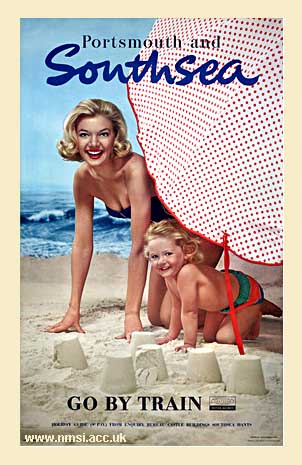 one of which was attached or detached at Woking to serve all stations on the Aldershot, Farnham and Alton line. On Saturdays in the summer the standard service over the Portsmouth direct line was increased to three fast trains an hour in each direction, one of which ran non-stop between Waterloo and Portsmouth & outhsea in the down direction and from Portsmouth Harbour to Waterloo in the up direction thus catering particularly for Isle of Wight passengers. The second called at Havant (connection to Hayling Island); the third only at Guildford, Haslemere and Portsmouth & Southsea. Over the Portsmouth main line were such that one of the two stopping trains in each hour arrived at Guildford six minutes in advance of the hourly express and left four minutes after it, providing a good connection from intermediate stations on the London side of Guildford to Haslemere and Portsmouth and in addition giving a fast journey from Waterloo to stations beyond Guildford. A similar arrangement was in force for up trains, one of which arrived at Guildford five minutes before the express (having left Portsmouth & Southsea 24 minutes before it) and leaving five minutes after it. On Saturdays in the summer, the two stopping trains had to be sandwiched in between four express services, and one of them in each direction was passed at Guildford by two fast trains only one of which stopped at that station.
one of which was attached or detached at Woking to serve all stations on the Aldershot, Farnham and Alton line. On Saturdays in the summer the standard service over the Portsmouth direct line was increased to three fast trains an hour in each direction, one of which ran non-stop between Waterloo and Portsmouth & outhsea in the down direction and from Portsmouth Harbour to Waterloo in the up direction thus catering particularly for Isle of Wight passengers. The second called at Havant (connection to Hayling Island); the third only at Guildford, Haslemere and Portsmouth & Southsea. Over the Portsmouth main line were such that one of the two stopping trains in each hour arrived at Guildford six minutes in advance of the hourly express and left four minutes after it, providing a good connection from intermediate stations on the London side of Guildford to Haslemere and Portsmouth and in addition giving a fast journey from Waterloo to stations beyond Guildford. A similar arrangement was in force for up trains, one of which arrived at Guildford five minutes before the express (having left Portsmouth & Southsea 24 minutes before it) and leaving five minutes after it. On Saturdays in the summer, the two stopping trains had to be sandwiched in between four express services, and one of them in each direction was passed at Guildford by two fast trains only one of which stopped at that station.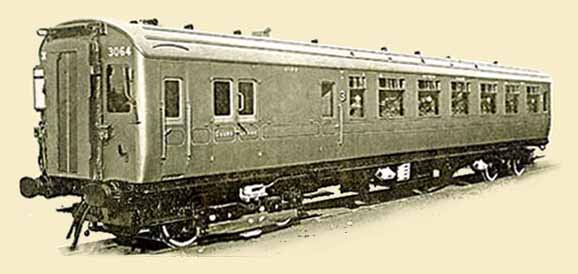
Rolling Stock
As mentioned, a total of 312v new or rebuilt vehicles had been constructed to operate the electrified  services on the Portsmouth, Alton and Weybridge routes. All this stock had been built to the designs of Mr REL Maunsell, Chief Mechanical Engineer but the complete electrical equipment had been the responsibility of Mr Raworth, Electrical Engineer for New Works. With the exception of two types of vehicles, ie the first and third class restaurant cars built respectively by the Metropolitan Cammel Carriage & Wagon Co Ltd, and the Birmingham Railway Carriage & Wagon Co Ltd, all the other vehicles were manufactured or rebuilt in the SR's own workshops at Eastleigh and Lancing. Details of the stock are shown below.
services on the Portsmouth, Alton and Weybridge routes. All this stock had been built to the designs of Mr REL Maunsell, Chief Mechanical Engineer but the complete electrical equipment had been the responsibility of Mr Raworth, Electrical Engineer for New Works. With the exception of two types of vehicles, ie the first and third class restaurant cars built respectively by the Metropolitan Cammel Carriage & Wagon Co Ltd, and the Birmingham Railway Carriage & Wagon Co Ltd, all the other vehicles were manufactured or rebuilt in the SR's own workshops at Eastleigh and Lancing. Details of the stock are shown below.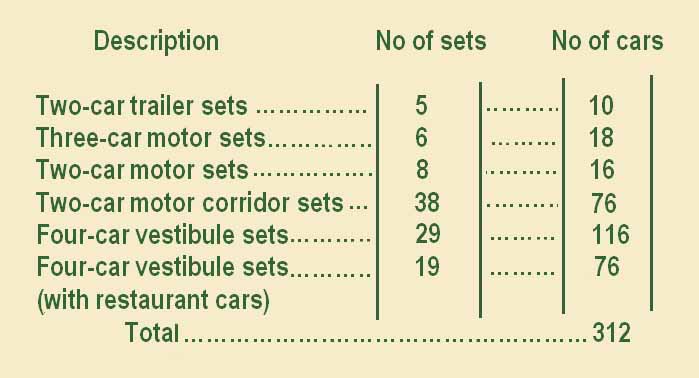

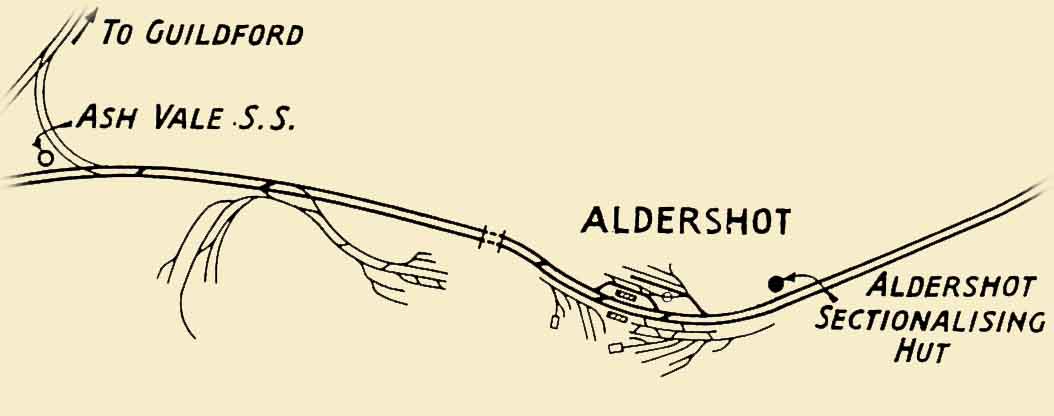 (Above-Right) Aldershot had two signalboxes, three goods yards, a turntable and water column and was a very busy place in its heyday. Aldershot station had three platforms (two of which were kept busy by Guildford - Ascot services which terminated at Aldershot for the driver to change ends. Apart from the usual freight from Woking Yard to Aldershot and Farnham, one of the regular turns we worked ran two or three times a week was to Aldershot Government
(Above-Right) Aldershot had two signalboxes, three goods yards, a turntable and water column and was a very busy place in its heyday. Aldershot station had three platforms (two of which were kept busy by Guildford - Ascot services which terminated at Aldershot for the driver to change ends. Apart from the usual freight from Woking Yard to Aldershot and Farnham, one of the regular turns we worked ran two or three times a week was to Aldershot Government 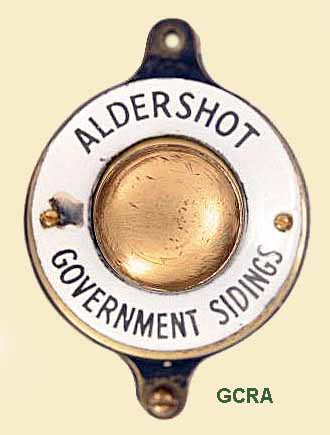 Sidings. The sidings were situated on the up line between Aldershot and Aldershot North Junction and were operated by a groundframe. The train was marshalled at Aldershot and the Aldershot shunters (Frank King, Bill Padgett or Danny Curley) would accompany you to the sidings and operate the ground frame once your train had passed over the points. The train was then propelled back into the siding, with the shunter closing the ground frame points to allow normal traffic to pass.
Sidings. The sidings were situated on the up line between Aldershot and Aldershot North Junction and were operated by a groundframe. The train was marshalled at Aldershot and the Aldershot shunters (Frank King, Bill Padgett or Danny Curley) would accompany you to the sidings and operate the ground frame once your train had passed over the points. The train was then propelled back into the siding, with the shunter closing the ground frame points to allow normal traffic to pass.
(Left-Below) In the steam days, Aldershot Government Sidings was very busy, with a train visiting the area every day. One of the sidings went down adjacent to the Basingstoke Canal (where coke would be placed for a huge boiler); another to the bakery, where you would deliver wagons of flour, and finally the field stores which were situated across the other side of a main road that led to Aldershot Cambridge Military Hospital. Before any movement was made across the road to the field stores, the shunter(s) would have to stop the traffic by displaying red flags. The field stores area was quite large and had platforms with covered canopies. In the Great War, horses and troops were loaded into trains and departed from here to the front. Aldershot Government Sidings call plunger, courtesy Great Central Railwayana Auctions. (Below) An enhanced image of Aldershot Signalbox's illuminated track diagram showing the rail connection to Aldershot Government Sidings - photo of the signal box interior courtesy David Ingham.
Petersfield
Eric Hern, who worked at Petersfield as a Porter and then Shunter in the 1950s, recalls these memories from the 1950s - 'Petersfield had a very busy railway yard; coal, sugar-beet, fish, and milk wagons had to be placed in their correct positions for loading and unloading in the Goods Yard at Petersfield so that lorries (and even horse drawn carts in that period) could easily make a collection. After the wagons were emptied or 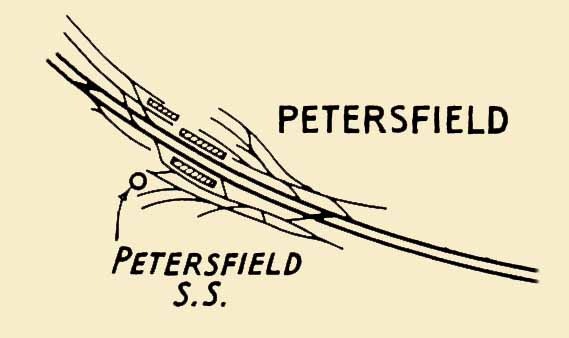 loaded, they would be despatched to Guildford. Local farmers would arrive, forming a queue to off-load their sugar-beet and sometimes 10-12 lorries or tractors would arrive. The farmers were experts at transferring their loads speedily - some twenty-five wagons would be loaded for despatch to the Midlands.
loaded, they would be despatched to Guildford. Local farmers would arrive, forming a queue to off-load their sugar-beet and sometimes 10-12 lorries or tractors would arrive. The farmers were experts at transferring their loads speedily - some twenty-five wagons would be loaded for despatch to the Midlands.
Fish trains often frequented Petersfield - one in the early morning and one mid morning. Coal stock was kept in the up yard and four coal merchants were sited there. The coal wagons needed to be placed correctly.
A wire-fencing firm was sited at Petersfield station (called Flextella) and wagonloads of steel wire would appear. They had a dock for one-and-a-half wagons adjacent to their premises and one wagon would easily be accommodated but the other one would present some difficulty to unload. Once a week, a girder firm loaded wagons with their products.
About 10.20am, a freight train would depart for Rowlands Castle and also to Havant and quite often it was necessary to join the train and assist with the unloading at the two stations. Bean and pea sticks and  Christmas trees were just some of the commodities that would be off-loaded from the Midhurst line trains. There were five or six 'push-pull' fitted trains a day operating on the line at that time; the locomotive invariably coming off the train upon arrival to replenish its water tanks.
Christmas trees were just some of the commodities that would be off-loaded from the Midhurst line trains. There were five or six 'push-pull' fitted trains a day operating on the line at that time; the locomotive invariably coming off the train upon arrival to replenish its water tanks.
The Midhurst branch line closed in 1955 and part of the line became a small siding adjacent to the Itshide Rubber Company which manufactured Commando heels and soles for their range of army boots...'
(Inset Right) This photo was taken by Mick Foster in the mid 1960s and relates to a derailment of wagons on the Up Loop line. The signal and latticed signal post (signal number 50 on the map) were also demolished! The Flextella wire fencing firm signage can be seen in the background and also some of the coal pens.
(Below) check out Stephen Payne's collection of signal box diagrams on his superb Flickr website 'Elm Tree Photography' HERE.
Whilst a fireman at Guildford in the middle 1960s, one of the early turns in No 2 Link involved working a freight train to Petersfield calling at various station sidings on the way there and the way back. My Driver during that time was Alan Ackehurst. We would call in at Haslemere first and drop off the coal wagons and then go to Liphook with military wagons that were destined for Longmoor Camp. Once we'd shunted there, we'd miss Liss on the down trip and then call in at Petersfield. One of the sidings on the down side just before the station was used by the Itshide Rubber Co Ltd which manufactured Commando heels and soles for their range of army boots. After shunting duties were finished, it was customary for the fireman to make the tea and we'd all take refreshments in the Guard's van. After finishing our brief sojourn, Alan and I made our way back to the locomotive and as we did so, I picked up one of the reject rubber heels that were strewn along the track. Alan was a good distance ahead of me and I jokingly threw it towards him. Unfortunately, the rubber heel's flight path took upon a mind if its own (curling somewhat similar to a Frisbee) hitting Alan by the side of the ear! I could see that he wasn't amused so I decided to wait a while before climbing up the steps to the engine later thinking that he might have calmed down by then and see the funny side of it. Before climbing the steps, I unwittingly placed my half-full tea can onto the footplate and as I climbed the handrails, Alan picked up the tea can and proceeded to tip the contents (no tea bags in those days) all over my head! I wasn't wearing my hat or knotted handkerchief at that time, so my hair (yes, I had some then) was covered in tea and grouts! It served me right to play such a foolish prank and this was Alan's revenge for hitting him with the rubber heel. I was combing tea grouts out from my hair all the way back to Guildford!
Havant
As part of the Waterloo to Portsmouth electrification the station was completely rebuilt in 1938. The number of tracks was increased from two to four, two for stopping trains and the two for non-stop, generally  express trains. The northernmost of the two fast tracks (as mentioned above) was later removed, and the remaining fast (through) track was also removed in late 2006. Havant was also the terminus for the Hayling Island branch services until late in 1963. Apart from the platform there was a run round loop, a siding serving a warehouse and a water column supplied by a circular metal water tank located near the signal box.
express trains. The northernmost of the two fast tracks (as mentioned above) was later removed, and the remaining fast (through) track was also removed in late 2006. Havant was also the terminus for the Hayling Island branch services until late in 1963. Apart from the platform there was a run round loop, a siding serving a warehouse and a water column supplied by a circular metal water tank located near the signal box.  As a child going on holiday to Hayling Island with my parents in the 1950s, we would board the train for the journey across the wooden Langstone bridge to Hayling Island hauled by an A1X Class 'Terrier', this train being nicknamed 'Puffing Billy'. The summer Sunday afternoon service on the Havant to Hayling Island branch was made up of trains alternately running as 3 coach stoppers or 4 coach expresses. In this 25 June 1961 of Class A1X 32661, note the natty spark arresters - small caps above the chimney tops. Click HERE to visit Richard S Greenwood's superb page of SR colour photos on Page 87...
As a child going on holiday to Hayling Island with my parents in the 1950s, we would board the train for the journey across the wooden Langstone bridge to Hayling Island hauled by an A1X Class 'Terrier', this train being nicknamed 'Puffing Billy'. The summer Sunday afternoon service on the Havant to Hayling Island branch was made up of trains alternately running as 3 coach stoppers or 4 coach expresses. In this 25 June 1961 of Class A1X 32661, note the natty spark arresters - small caps above the chimney tops. Click HERE to visit Richard S Greenwood's superb page of SR colour photos on Page 87...
Portsmouth & Southsea
Portsmouth & Southsea station is split into two distinct parts: the High Level station has one island platform for through trains, whereas the Low Level station is comprised of five terminus platforms, three of which have a conductor rail allowing the entry of electric trains. Portsmouth and Southsea was once the junction for the branch line to the dockyard. (Below) In this 1979 view of Portsmouth & Southsea station, one of the platforms is occupied by a 4-car EMU with a return service to Waterloo, while the remaining two platforms on the right are available for non-electric trains. The photo also shows a number of sidings (one being electrified) containing parcel vans. In the foreground, a Class 31, 31401 runs light engine from Fratton to Portsmouth Harbour via Portsmouth & Southsea High Level station. On the left is an 8-car EMU berthed in the carriage road. The photograph was taken by Stephen Payne from Jacobs Ladder footbridge on 13th May 1979…check out Stephen's photos of Portsmouth & Southsea on his Flickr website 'Elm Tree Photography' HERE.
(Below) In this 1979 view of Portsmouth & Southsea station, one of the platforms is occupied by a 4-car EMU with a return service to Waterloo, while the remaining two platforms on the right are available for non-electric trains. The photo also shows a number of sidings (one being electrified) containing parcel vans. In the foreground, a Class 31, 31401 runs light engine from Fratton to Portsmouth Harbour via Portsmouth & Southsea High Level station. On the left is an 8-car EMU berthed in the carriage road. The photograph was taken by Stephen Payne from Jacobs Ladder footbridge on 13th May 1979…check out Stephen's photos of Portsmouth & Southsea on his Flickr website 'Elm Tree Photography' HERE.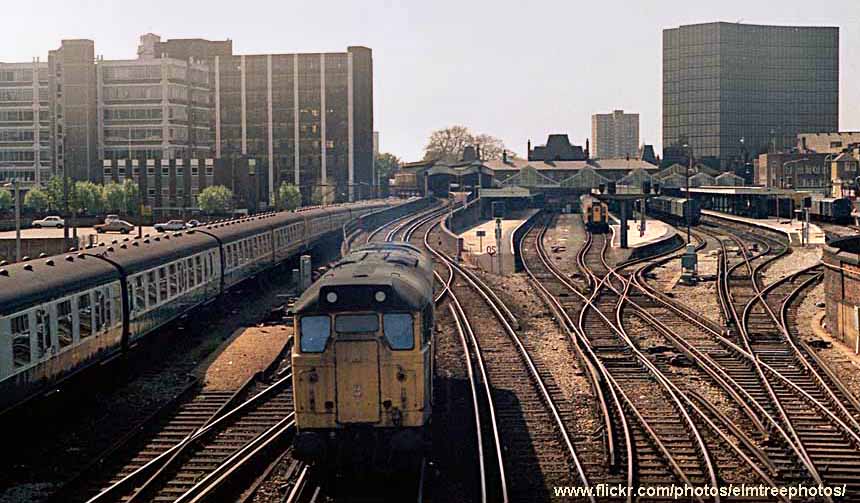
Looking at the photo (above) reminds me of an early turn I worked at Guildford Loco in the 1960s, signing on at 03:00 to work the paper train from Woking to Portsmouth & Southsea station. This train was the 03:40 ex-Waterloo. Invariably, the train was headed by a Standard Class 5MT locomotive and after stopping at Guildford to unload papers, the next stop would be Godalming. I always went back to make the tea at Godalming and on a Tuesday, the newpaper proprietor would let me have the 'Anglers Mail' and 'Angling Times' for free! Our next stop would be Haslemere and then on to Petersfield and it was here that we'd pick up the water churns and load them onto the footplate to be deposited at the foot crossing at Ditcham as the railway house there didn't have a water supply. As well as dropping the water churns off, we were expected to pick up the empty ones and these would be dropped off at Havant and subsequently returned to Petersfield for refilling. Once you'd reached your destination at Portsmouth & Southsea station, you would have to wait about an hour for your train to be released, and then run light-engine to Fratton MPD where you would perform the necessary disposal duties before returning back to Guildford 'on the cushions'.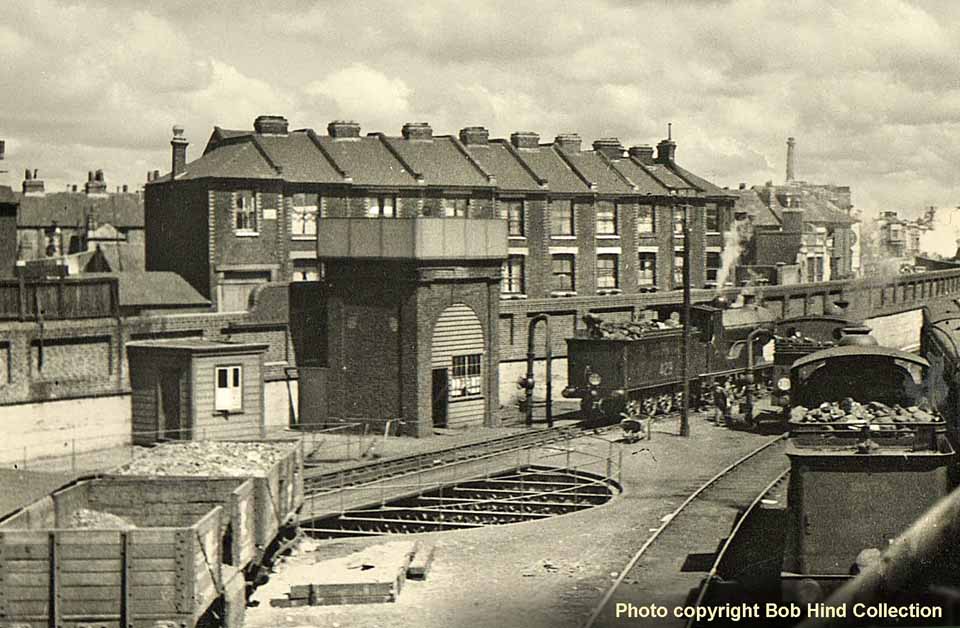
(Above) Looking in the opposite direction from Portsmouth & Southsea High Level station is this view of the turntable where the signal box was later built. The engine is No 423, one of Dugald Drummond's twenty L12 Class express passenger 4-4-0s built in 1904-5.
Portsmouth Harbour
Portsmouth Harbour station was reached via the high level route and terminated at platforms constructed above a wooden pier. Back in the 1950s, as a child going on holiday to the Isle of Wight with my parents I remember standing in an orderly queue waiting patiently to board one of the paddle steamers to take us over the short sea crossing to Ryde Pier Head and onward steam hauled journey to Ryde, Sandown or Shanklin.
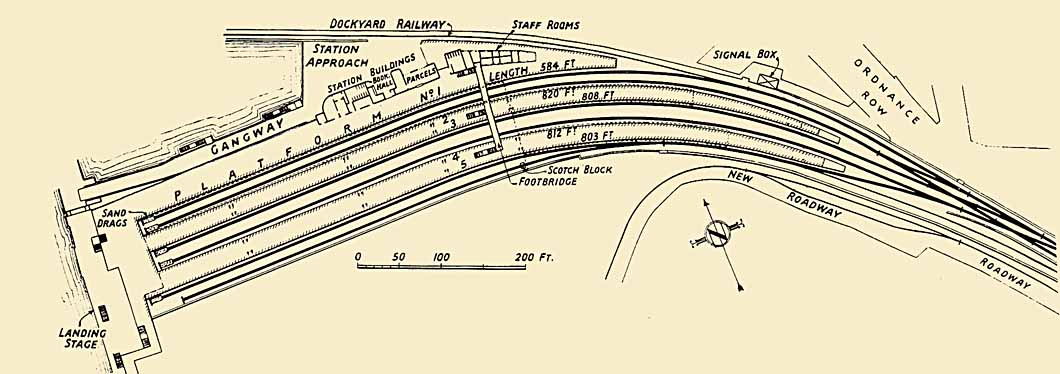

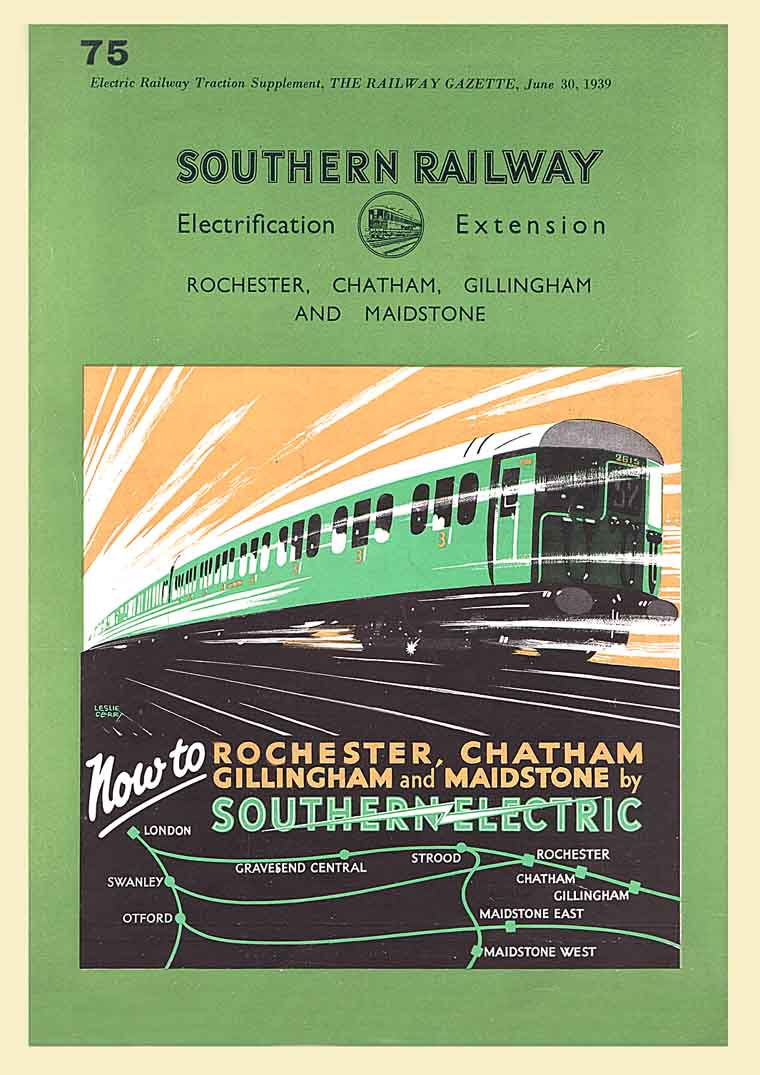
(Below) This Southern Railway poster - 'Summer Services for Winter Visitors to Portsmouth, Southsea and Isle of Wight' - was painted by Charles (Chas) Pears in 1937. The text at the bottom of the poster is accompanied by the Southern Railway's lightning flash electric logo. The train is about to enter Buriton Tunnel heading towards Portsmouth. The tail lamp can just be seen…yes, even though it was an electric train, during 1937 and for many years to come, an oil tail lamp was still necessary in case of electric current failure. The train is a 12-car Portmouth Express consisting of two 4-COR units sandwiching a 4-BUF unit.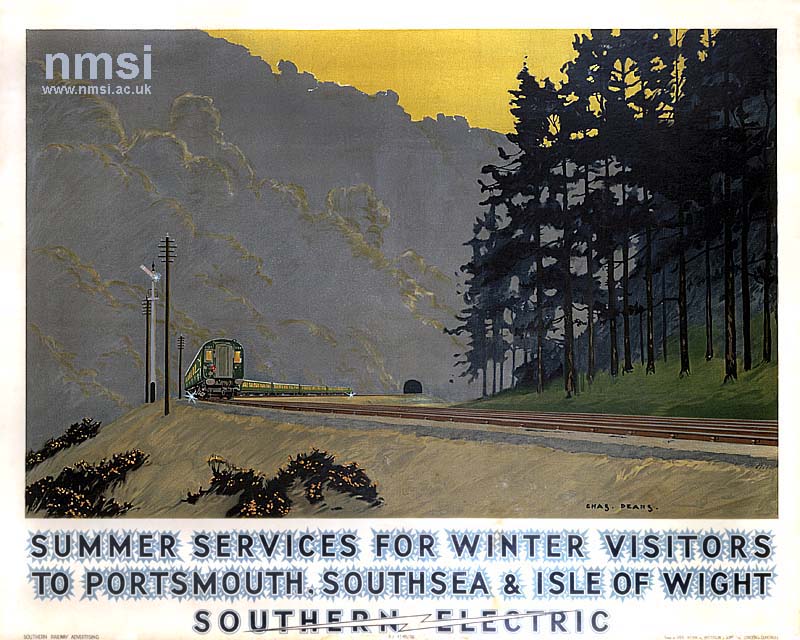
The arrival of the London and South Western Railway in 1845 brought about the biggest change to Guildford. It gave the 'middle classes' an opportunity to reside in the rural environs of Guildford and  commute to London by train although the journey probably took a little longer than the 40 minutes it takes now!
commute to London by train although the journey probably took a little longer than the 40 minutes it takes now!
In 1895 Dennis Brothers set up a firm to make bicycles and then went on to build buses and fire appliances (my father being employed there as an engineer in the mid-1950s). There was also a brewery in the town (Friary) and a printing works (Billing & Son) in Walnut Tree Close. Indeed as you can see by the 1935 map at the top of the page, Guildford's landmarks have now changed considerably and although some are still recognisable, others have disappeared forever. Over the years the Brewery, Cattle Market, Gas Works, Brick Works, Ice Factory, and Tuberculosis (TB) Isolation Hospital have long since gone, and in their place we now have shopping precincts, housing developments and modern industrial estates. Talking of successful Guildford businesses, I must mention Ben Darnton, whose shop - 'Ben's Collectors Records' - in Tunsgate, has recently scored a top 10 chart position - being chosen as one of the UK's most favourite shops of its kind. In March 2013 the Observer newspaper ran a story highlighting the best independent record shops across the country. The Independent newspaper also ran a feature in its culture section in which readers were invited to name their best record stores - Well Done Ben! On top of that, BBC's Business Editor, Robert Peston was in his shop recently to record a programme about the history of shopping in the UK and the boom in leisure goods during the 1960s when record shops were so popular.
Talking of successful Guildford businesses, I must mention Ben Darnton, whose shop - 'Ben's Collectors Records' - in Tunsgate, has recently scored a top 10 chart position - being chosen as one of the UK's most favourite shops of its kind. In March 2013 the Observer newspaper ran a story highlighting the best independent record shops across the country. The Independent newspaper also ran a feature in its culture section in which readers were invited to name their best record stores - Well Done Ben! On top of that, BBC's Business Editor, Robert Peston was in his shop recently to record a programme about the history of shopping in the UK and the boom in leisure goods during the 1960s when record shops were so popular. 
Ben, who is a complete railway nut (and top bloke) has always been extremely supportive of my talks and presentations and along with other railway DVDs has sold a large number of both my books in his shop for which I'm thankful. If you're in Guildford, do drop in to see him, he'll always make you very welcome.
Despite Central London being less than 30 miles away, Guildford has always remained a thriving economic and cultural centre in its own right. Guildford Cathedral (built between 1936 and 1961) stands in a commanding spot on Stag Hill. It was so named because the Kings of England used to hunt there; the Cathedral's solid red brick outline is made from clay taken from the hill on which it stands and can be seen from miles around. It overlooks the University of Surrey which was established in 1968 and now features a second campus at Manor Park located a short distance away.
The Royal Surrey County Hospital (RSCH) is now situated on the outskirts of Guildford; a 527-bedded District General Hospital, serving a population of 320,000 for general services and 1,200,000 for cancer services. It is also a specialist centre for diabetes, ENT and maxillo facial surgery. The old RSCH site in Farnham Road has become a specialist mental health hospital, providing round-the-clock support to adults experiencing acute mental ill-health as well as housing community mental health and day services.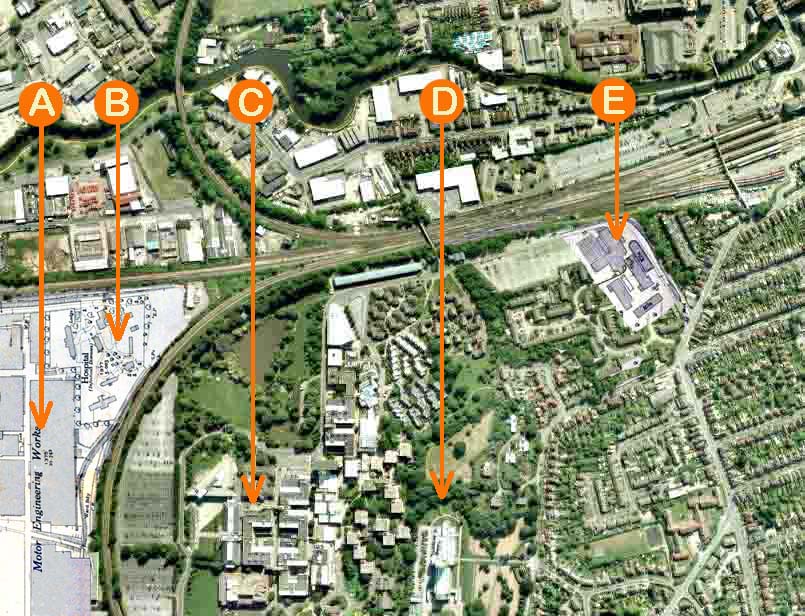
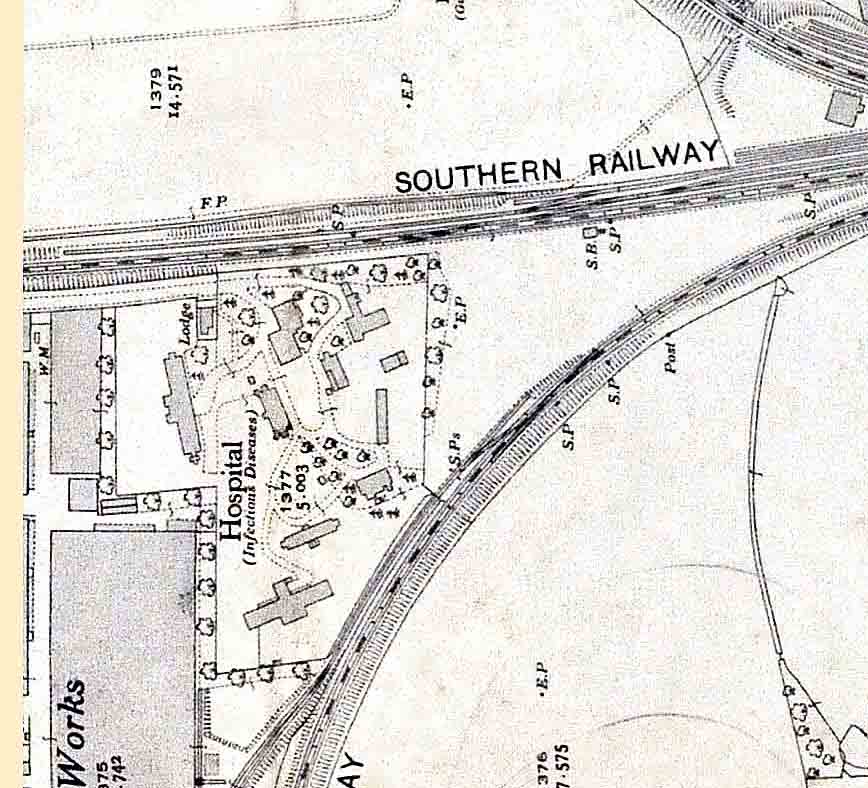 (Above-Right) This aerial view of Guildford circa 2013 is reproduced courtesy of Google Earth. Superimposed on the image is a section from the 1935 map featured at the top of the page which shows (A) Dennis Brothers Motor Engineering Works and (B) Hospital for Infectious Diseases. The other arrows point to (C) University of Surrey; (D) Guildford Cathedral and a second section from the 1935 map showing (E) the Guildford Park Brick Works...both the Brick Works and Dennis Brothers factory had rail links. (Right) Founded by John and Raymond Dennis in 1895, Dennis Brothers began manufacturing 'Speed KIng' bicycles. The company went on to make their first motor vehicle in 1898 and car in 1899. John Dennis then built the Rodboro Buildings in the centre of Guildford - the first purpose-built motor vehicle factory in
(Above-Right) This aerial view of Guildford circa 2013 is reproduced courtesy of Google Earth. Superimposed on the image is a section from the 1935 map featured at the top of the page which shows (A) Dennis Brothers Motor Engineering Works and (B) Hospital for Infectious Diseases. The other arrows point to (C) University of Surrey; (D) Guildford Cathedral and a second section from the 1935 map showing (E) the Guildford Park Brick Works...both the Brick Works and Dennis Brothers factory had rail links. (Right) Founded by John and Raymond Dennis in 1895, Dennis Brothers began manufacturing 'Speed KIng' bicycles. The company went on to make their first motor vehicle in 1898 and car in 1899. John Dennis then built the Rodboro Buildings in the centre of Guildford - the first purpose-built motor vehicle factory in 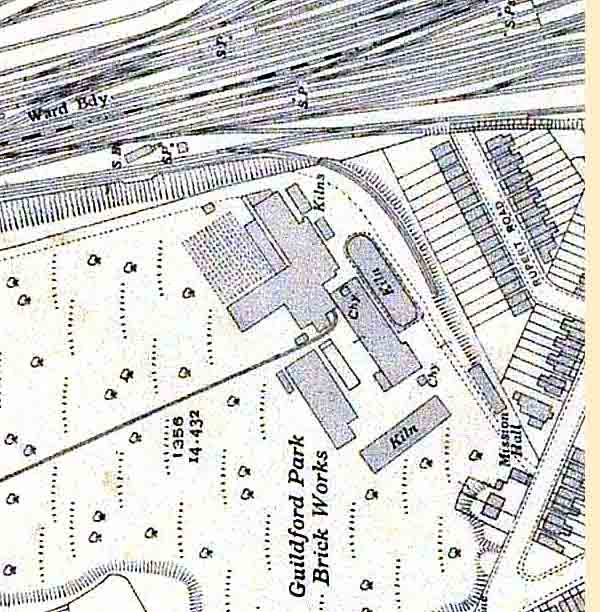 Britain to manufacture motorcars (now the site of a Wetherspoons pub). Commercial vehicle activity increased and the first bus was made in 1903 followed by the company's first fire engine in 1908. In 1913 Dennis moved to a larger factory at Woodbridge on the outskirts of Guildford. This enlarged section of the map shows a close-up view of the factory (A) and the Hospital for Infectious Diseases (B) which treated patients suspected of contracting Tuberculosis (TB).
Britain to manufacture motorcars (now the site of a Wetherspoons pub). Commercial vehicle activity increased and the first bus was made in 1903 followed by the company's first fire engine in 1908. In 1913 Dennis moved to a larger factory at Woodbridge on the outskirts of Guildford. This enlarged section of the map shows a close-up view of the factory (A) and the Hospital for Infectious Diseases (B) which treated patients suspected of contracting Tuberculosis (TB).
(Left-Right) This enlarged section of the 1935 map shows the old Guildford Park Brick Works (E) once dominated by tall chimneys but now a residential area and a 'Pay & Dispay' car park. (Below Right) I took this aerial shot of Guildford Cathedral in 1968. The Cathedral stands in a commanding spot on Stag Hill - so named because the Kings of England used to hunt there; the Cathedral's solid red brick outline is made from clay taken from  the hill on which it stands and can be seen for miles around. On the left of the Cathedral is the construction site of the University of Surrey campus. In the middle distance alongside the railway is the residential area and 'Pay & Dispay' car park I mentioned above; both now occupying the site of the Guildford Park Brick Works.
the hill on which it stands and can be seen for miles around. On the left of the Cathedral is the construction site of the University of Surrey campus. In the middle distance alongside the railway is the residential area and 'Pay & Dispay' car park I mentioned above; both now occupying the site of the Guildford Park Brick Works.
(Below) Several photos of Guildford station are featured further down the page in Pat Kinsella's gallery - 'Memories of Guildford Station 4' - featuring photos taken during the 1980s when the old station buildings were being razed to the ground in readiness for modernisation. However, I include this photo here because it shows the Guildford Cathedral dominating the skyline. Meanwhile, in the foreground the bulldozers have started work at the country end of No 2 platform and the old 'mobile' canteen, EMU Drivers' room and Lamp room have been demolished, and in their place a temporary structure has been erected outside the Gents toilet.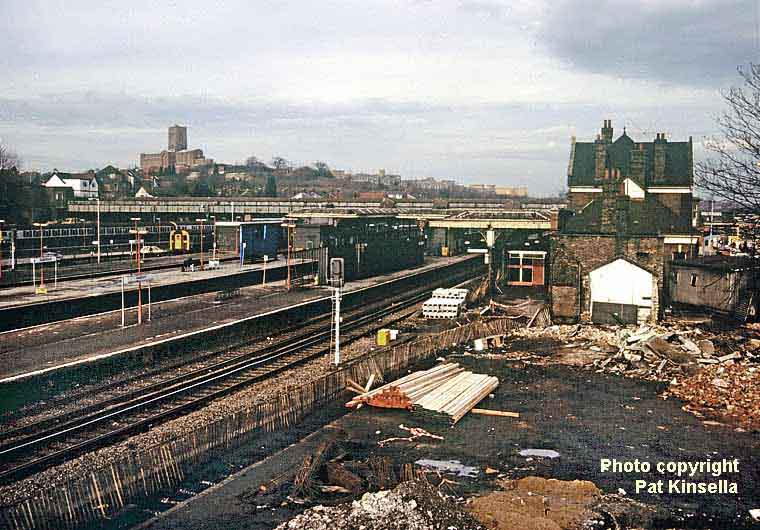
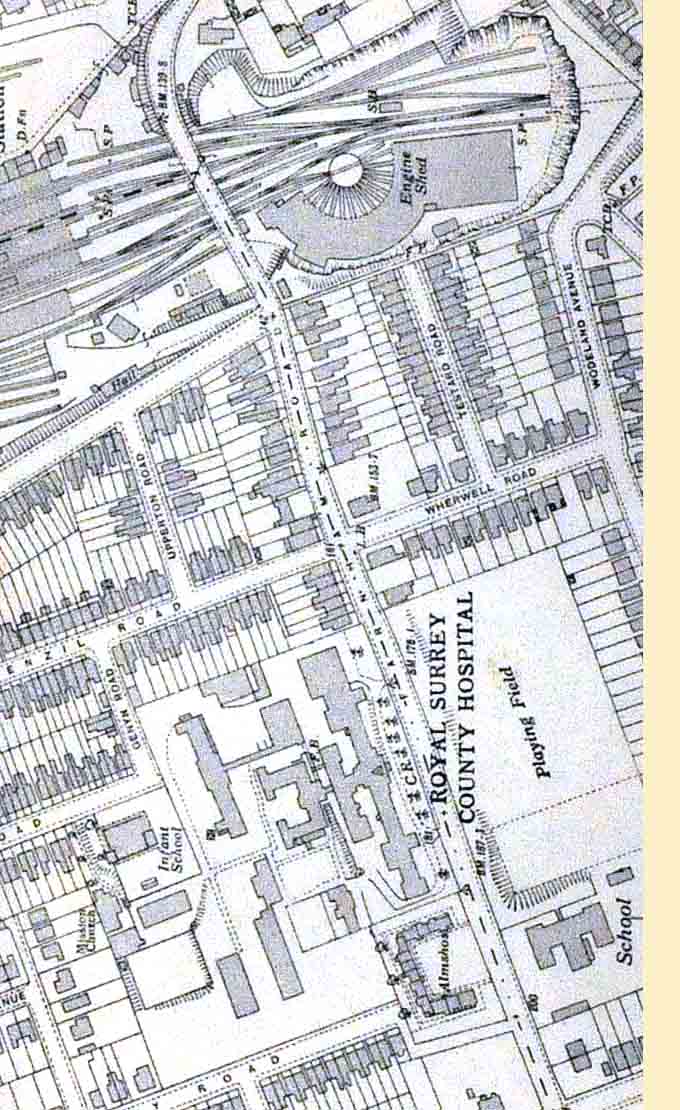 (Left) The 1935 map shows Guildford Loco at the top and the old Royal Surrey County Hospital (RSCH) in Farnham Road at the bottom; I had the misfortune of visiting the outpatients department there whilst working at Guildford loco in the 1960s; on one occasion I trod on a rusty nail whilst filling sandboxes on a loco. The hospital has since moved to a larger site on the outskirts of Guildford; a 527-bedded District General Hospital, serving a population of 320,000 for general services and 1,200,000 for cancer services. It is also a specialist centre for diabetes, ENT and maxillo facial surgery. The old Farnham Road building is now a specialist mental health hospital, providing round-the-clock support to adults and older adults experiencing acute mental ill-health as well as housing community mental health and day services.
(Left) The 1935 map shows Guildford Loco at the top and the old Royal Surrey County Hospital (RSCH) in Farnham Road at the bottom; I had the misfortune of visiting the outpatients department there whilst working at Guildford loco in the 1960s; on one occasion I trod on a rusty nail whilst filling sandboxes on a loco. The hospital has since moved to a larger site on the outskirts of Guildford; a 527-bedded District General Hospital, serving a population of 320,000 for general services and 1,200,000 for cancer services. It is also a specialist centre for diabetes, ENT and maxillo facial surgery. The old Farnham Road building is now a specialist mental health hospital, providing round-the-clock support to adults and older adults experiencing acute mental ill-health as well as housing community mental health and day services.
During the intermediate post-war year period, Guildford shed (70C) had six progressional and two voluntary Links in addition to the ash, turning and cleaning gangs. The youngest recruits to the shed started as engine cleaners and they then progressed to disposing of locomotives as they came on shed and finally to coaling, watering and turning locomotives for their next booked duty. The two voluntary Links were the 'Dual Link' where men could opt to train for driving the electric multiple-units (EMUs) as well as drive steam locomotives, and the 'Old Man's Gang' where Drivers nearing retirement age could opt for light duties which didn't involve working a night shift.
By 1950, Guildford shed was coded 70C, and in June that year it briefly witnessed the testing of Bulleid's futuristic 'Leader' class which made some test runs between Woking and Guildford. At the same time, the roof of the semi-roundhouse was replaced using corrugated sheeting. Towards the end of February 1958,  Guildford's turntable was in need of urgent repair, which effectively closed the shed buildings. Four locomotives were left stranded in the semi-roundhouse while the Aldershot triangle was used to turn locomotives. Routine repairs and boiler wash-outs were transferred to Reading Southern shed and although coaling and watering could still be carried out at Guildford, the use of these roads to stable locomotives made it very difficult for the staff. To ease matters, some of Guildford shed's locomotives were stabled at Shalford.
Guildford's turntable was in need of urgent repair, which effectively closed the shed buildings. Four locomotives were left stranded in the semi-roundhouse while the Aldershot triangle was used to turn locomotives. Routine repairs and boiler wash-outs were transferred to Reading Southern shed and although coaling and watering could still be carried out at Guildford, the use of these roads to stable locomotives made it very difficult for the staff. To ease matters, some of Guildford shed's locomotives were stabled at Shalford.
By 1959, Guildford shed's allocation had reduced to forty-five locomotives incorporating four M7 Class, three G6 Class, eight 700 Class, sixteen U class Moguls, one T9 Class and shed pilot B4 Class 30089. These were augmented in early 1960 by the arrival of three SR V Class 'Schools' 30903 'Charterhouse', 30906 'Sherborne' and 30909 'St Paul's' for use on the Reading to Redhill services. Also on the 31st December, the Tongham branch closed and as Aldershot gasworks had closed in the June, there was no further use for the already under-used line. However, the line was kept open for the early-winter sugar-beet traffic. 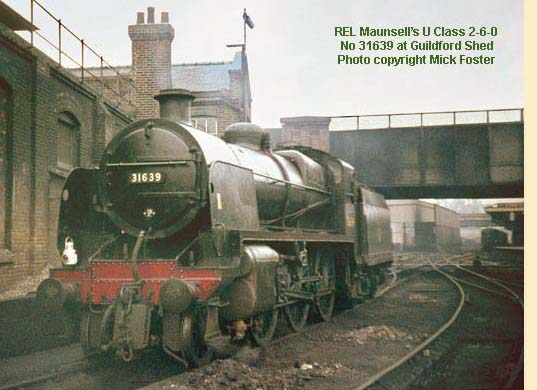 In September 1962, the Crompton Type 3 Bo-Bo diesel-electric locomotives started to appear on the Margate to Wolverhampton service and return workings. In March 1963, B4 Class 30089 was condemned and was replaced by USA Class 30064 and finally USA Class 30072. With the withdrawal of the M7 Class, the Horsham line workings became a virtual monopoly of the Ivatt Class 2MT locomotives. However, some of the services were hauled by Q1 Class locomotives.
In September 1962, the Crompton Type 3 Bo-Bo diesel-electric locomotives started to appear on the Margate to Wolverhampton service and return workings. In March 1963, B4 Class 30089 was condemned and was replaced by USA Class 30064 and finally USA Class 30072. With the withdrawal of the M7 Class, the Horsham line workings became a virtual monopoly of the Ivatt Class 2MT locomotives. However, some of the services were hauled by Q1 Class locomotives.
In 1965, the Beeching report favoured the closing of the line and on the 14th June, Ivatt Class 2MT 41287 worked the last booked passenger train. On the 4th January 1965, the Reading to Redhill line was turned over to diesel traction with 3-car diesel electric multiple units (affectionately named 'Tadpoles') working an hourly interval service.
During the mid-1960s, the Portsmouth Direct line via Guildford was utilised as a diversionary route at weekends while electrification work was being carried out on the Waterloo to Bournemouth main line. This brought the spectacle of Bulleid Pacifics and BR Standard Class 5 locomotives running through Guildford  with prestigious trains such as 'The Bournemouth Belle'. By 1965, Guildford's allocation was down to twenty-eight locomotives and comprised USA Class 30072, nine N and eight U Class, six Q1 Class and four Ivatt Class 2MT locomotives. With the withdrawal of the Maunsell S15 Class and the Bulleid Q1 Class, much of the variety which was once the trademark of Guildford Shed vanished forever.
with prestigious trains such as 'The Bournemouth Belle'. By 1965, Guildford's allocation was down to twenty-eight locomotives and comprised USA Class 30072, nine N and eight U Class, six Q1 Class and four Ivatt Class 2MT locomotives. With the withdrawal of the Maunsell S15 Class and the Bulleid Q1 Class, much of the variety which was once the trademark of Guildford Shed vanished forever.
On Sunday 9th July 1967, after years of decline and neglect, only four steam locomotives remained. The first two locomotives to leave (initially to Salisbury and then later to South Wales to face the cutter's torch) were BR Standard Class 5MT 73155 and 73118 coupled together. West Country Class 34018 'Axminster' followed them to Salisbury and finally USA Class 30072 left for Salisbury via Havant (destined for a new career on the Keighley and Worth Valley Railway). All signs of the Motive Power Depot at Guildford have now been razed to the ground. The roundhouse engine shed has disappeared and all that remains on the site is a multi-storey car-park.
RAILWAY BYWAYS
Classic SR railway photos from Rae Woodford's Collection
Rae Woodford (a fellow fireman at Guildford shed) has kindly allowed me to publish some excellent photos from his collection which I feel sure everyone will find very interesting. The photographer was railwayman, EC Griffith, who was based at Farnham.

(Above-Below) C Class 31223 hurtles down the bank towards Wanborough form Ash Junction with a Reading - Redhill passenger service on 25th May 1951. Milepost 35-1 can be seen in the foreground denoting the mileage from London (35¼ miles). (Below) T9 Class 30310 pauses before leaving Farnborough North station with a passenger service for Reading on 27th May 1955. The Class were nicknamed 'Greyhounds' due to their rapid turn of speed and were well liked by engine crews; indeed even in old age they were still capable of speed in excess of 80mph - the T9s, not the crews
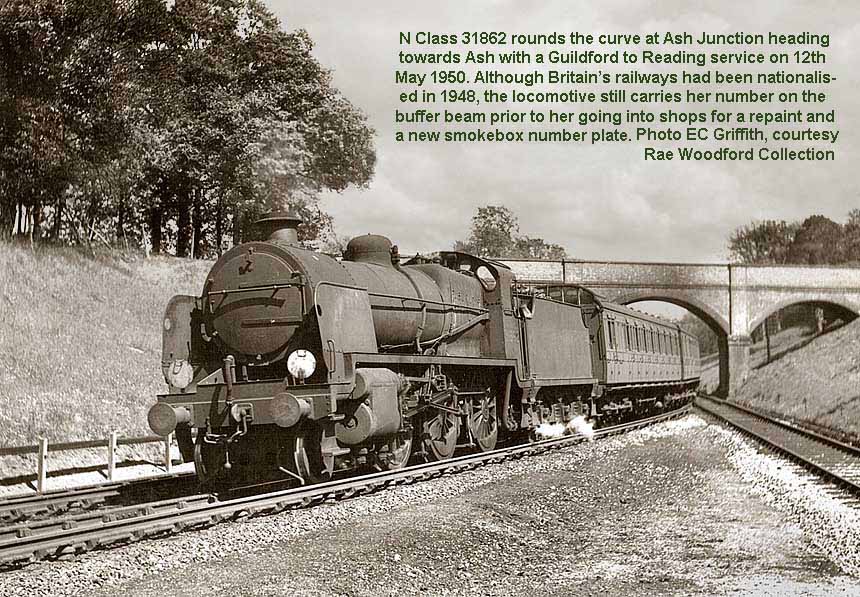
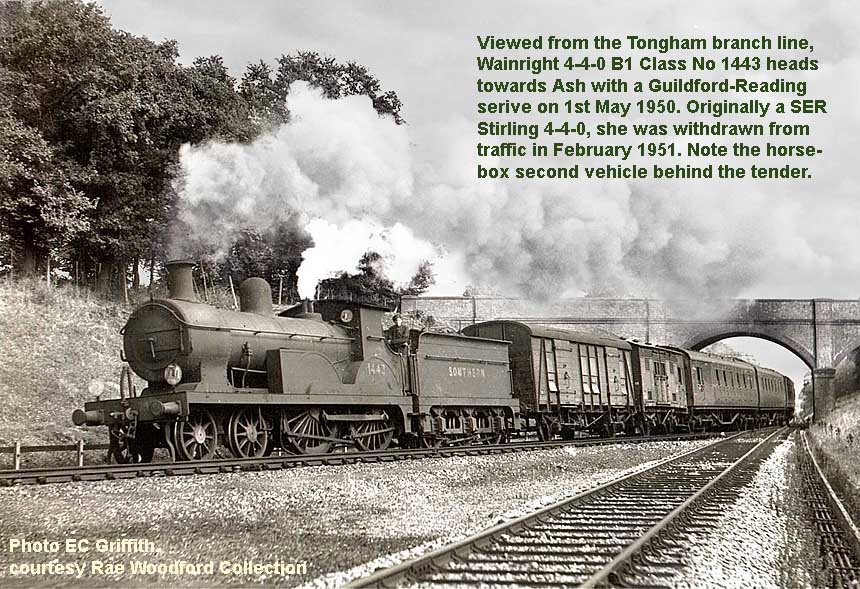
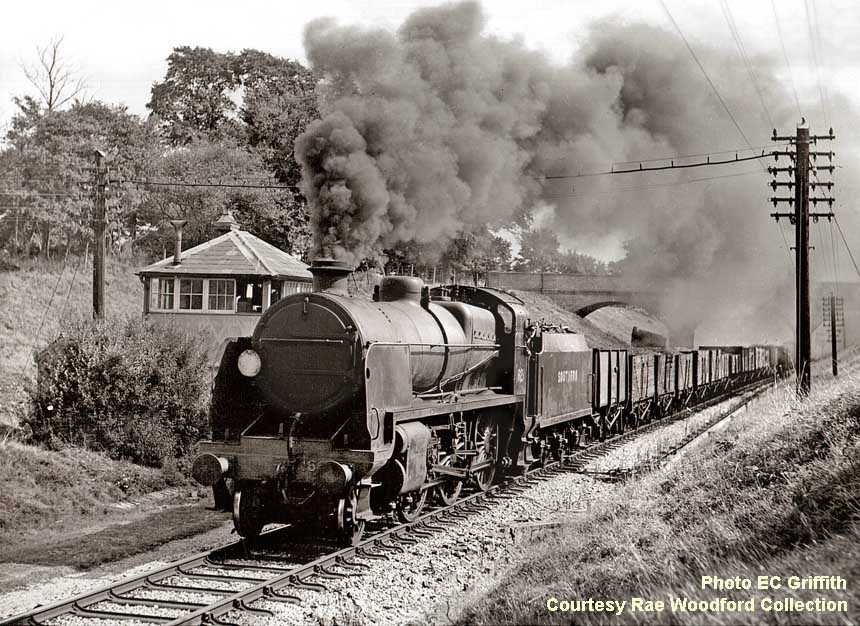
(Above-Below) U Class 1621 storms over the Tongham branch line towards Ash Green having collected the single line token fron Ash Junction signalbox. Although a short branch was laid from Tongham to serve the nearby Aldershot Gas Works in 1898, the line became a forgotten byway and was singled in 1930. Passenger services ceased in 1937 as a consequence of electrification of other lines in the vicinity, but Tongham remained open to serve the Gas Works until its closure in 1954. With the closure of the Gas Works, British Railways decided that the twice-weekly goods service was no longer justified and the last service ran on 31 December 1960. (Below) The Driver of U Class 31625 stretches out the couplings of his loose-coupled freight train after traversing the 30mph double-bend speed restriction at Farnham Junction. The train has probably originated from Bordon picking up extra wagons at Farnham Up Yard (and then Aldershot Up Yard) before departing for Feltham Yard. 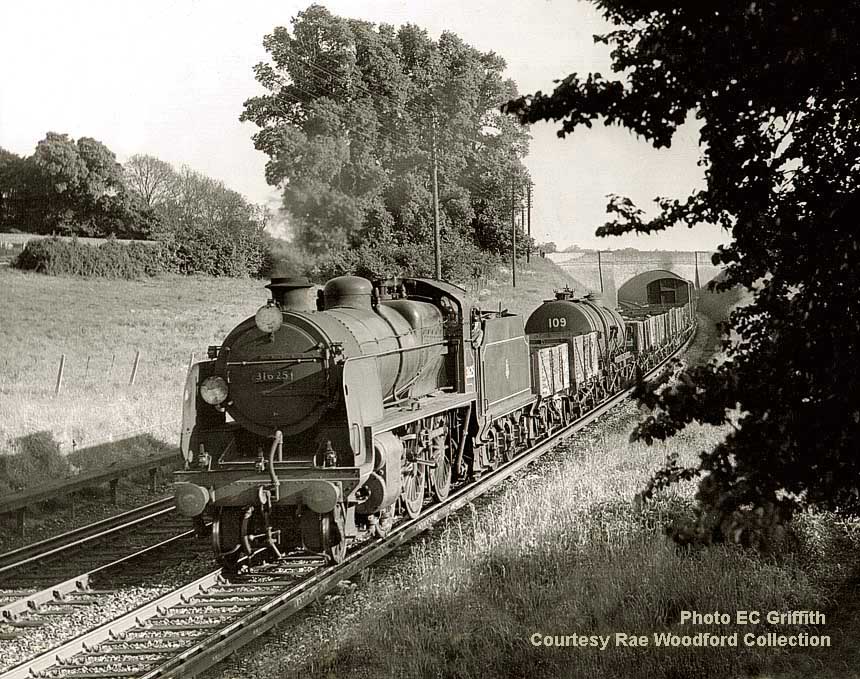
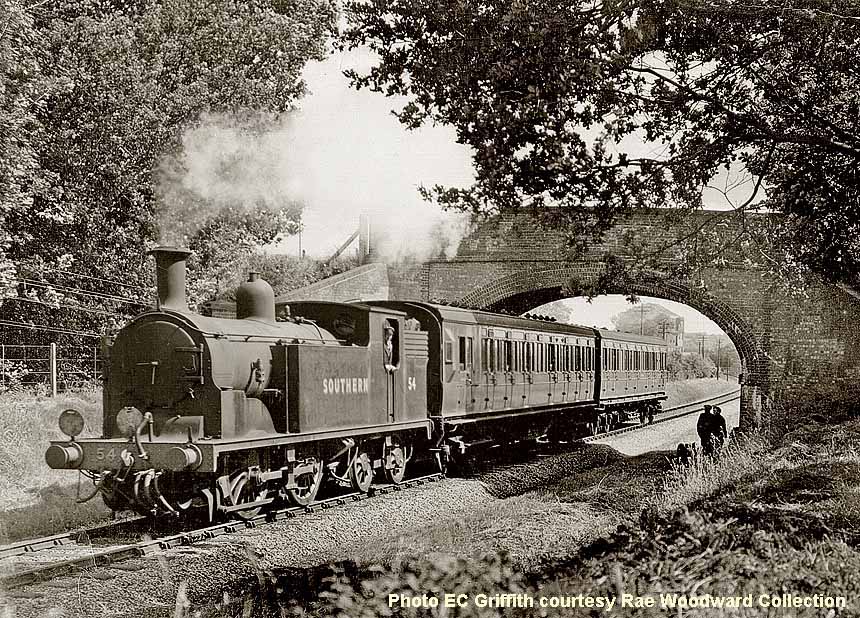
(Above-Below) M7 Class No 54 (later to become 30054) hauls a passenger service over a single line section of the Meon Valley line. (Below) 700 Class (Black Motor) 30697 approaches Treloar's Hospital Platform (also known as Alton Park and Cripples' Home Siding) which was a railway station serving Lord Mayor Treloar's hospital near Alton. It was situated just outside Alton station at Butt's Junction. 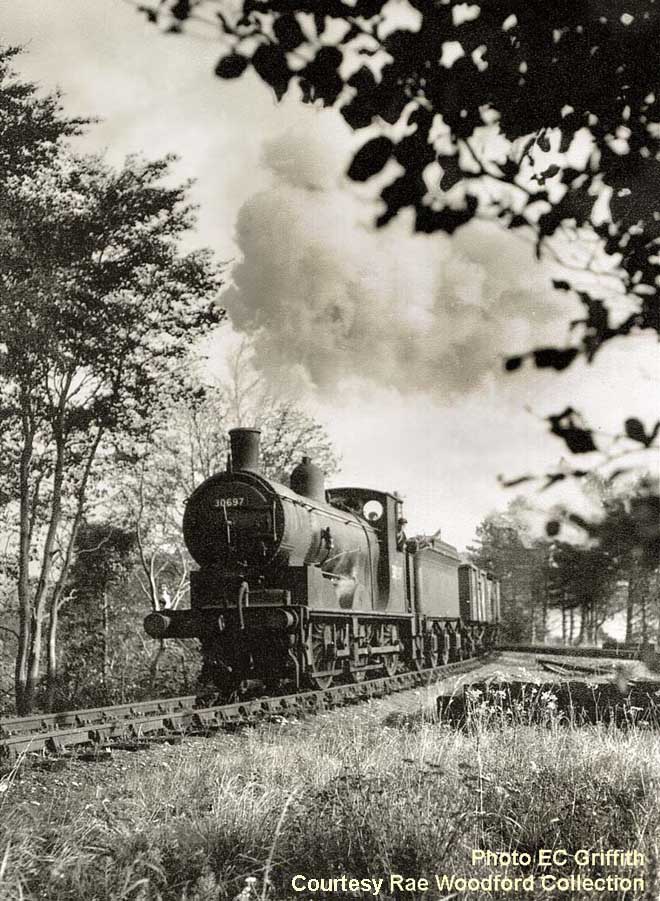
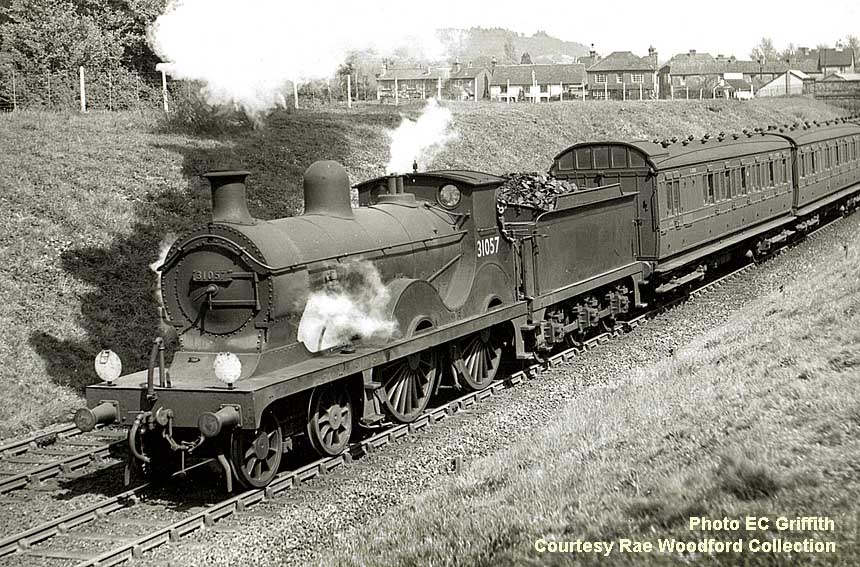
(Above-Below) A C Class 4-4-0 31057 has just left Shalford with a passenger service from Redhill bound for Guildford and Reading on 2nd May 1950. Built for the South Eastern and Chatham Railway (S.E.C.R.) the class were designed by Harry Wainwright and built between 1900 and 1908. They were designed for freight duties, although occasionally used for passenger trains. (Below) S15 Class 30836 runs into Blackwater station with a passenger service for Reading in July 1955. Note the summer excursion notices displayed at the station entrance - quite popular events as this would save the passenger considerable time in reaching the South Coast without changing trains at Redhill or Horsham. 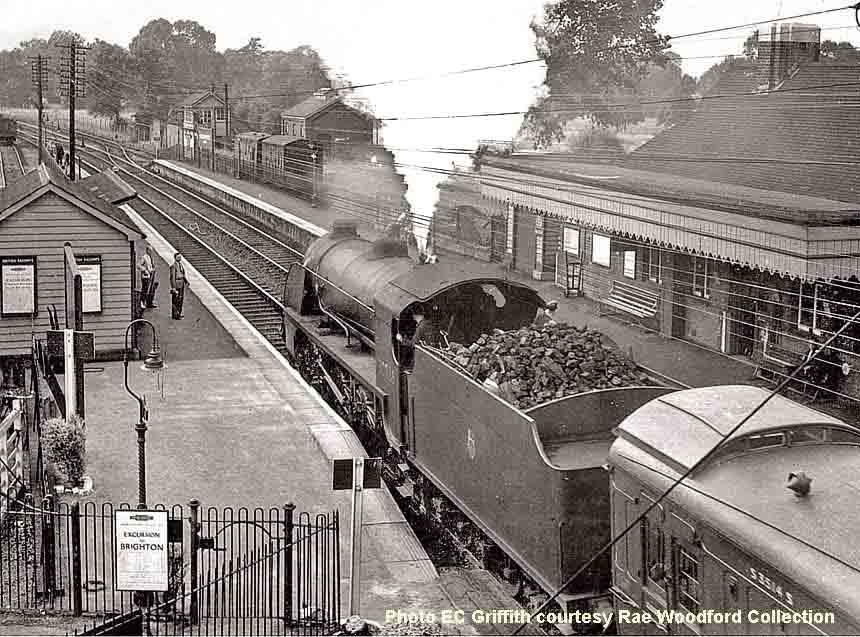
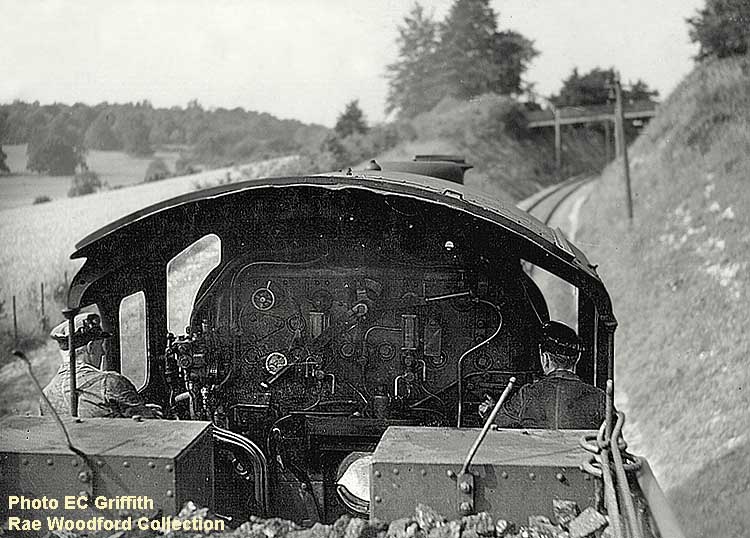
(Above-Below) A fine view of the cab of a left-handed U Class taken from the tender of the locomotive as it runs over a section of the Meon Valley Line. The single line tablet (in its leather pouch) can be seen hanging over the blower valve on the boiler front next to the Driver. (Below) 0395 Class 0-6-0 30575 travels light engine towards Shalford on its way to Redhill on 2nd May 1950. Designed by Adams and built by Nielson & Co in 1883 she was shedded at Guildford from 1948 and withdrawn from service on 31st December 1959.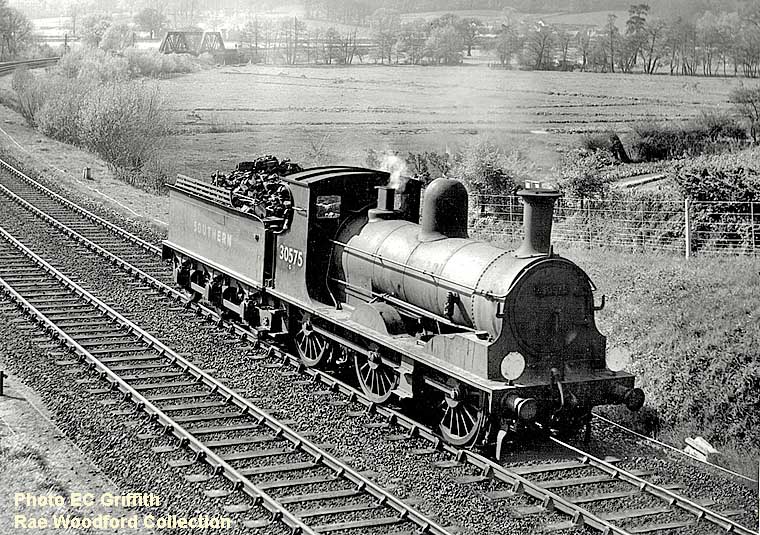
(Below) L11 Class No 168 is seen here approaching Farnham Junction working a Portsmouth - Woking passenger service via the Meon Valley line in 1949. Note the lower quadrant signals at the time - the right hand signal when lowered would be for the line to Guildford via Tongham, Ash Green and Ash Junction.
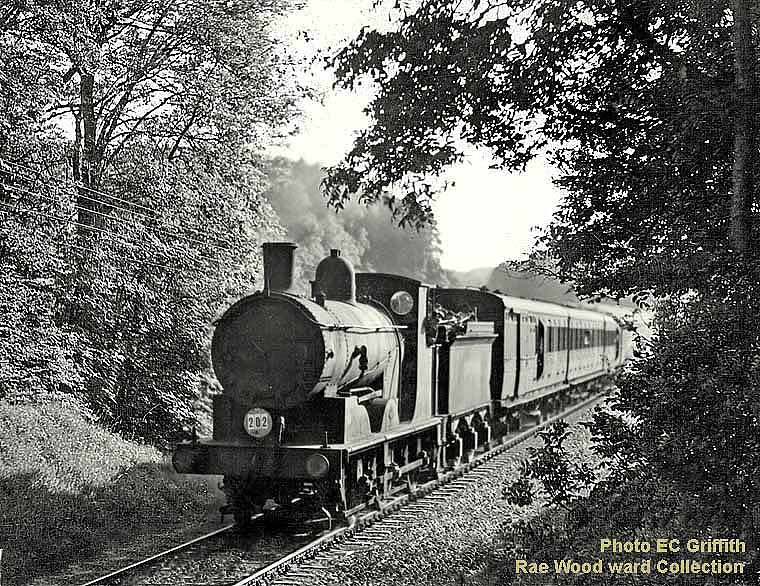
(Above) An unidentified 700 Class (Black Motor) works a passenger service near Tistead on the Neon Valley Line on 1st June 1947. The Meon Valley Railway (MVR) was a cross-country railway in Hampshire that ran for 22.5 miles between Alton and Fareham, closely following the course of the River Meon. At its northern (Alton) end, it joined with the Mid-Hants Railway to Winchester, the Alton Line to Brookwood and the Basingstoke and Alton Light Railway. At Fareham it linked with the Eastleigh to Fareham Line, the West Coastway Line and the line to Gosport. The railway was authorised in 1896 and opened in 1903, making it one of the last railways of any size to be built to main-line standards in the United Kingdom. The MVR had a crucial role to play in the D-Day operations. On Thursday, June 2 1944, Winston Churchill, US General Dwight D Eisenhower, the Prime Ministers of Canada and South Africa, William Lyon Mackenzie King and Jan Smuts, and other Allied leaders met in a special train at Droxford Station (the train was actually the Royal Train from the London, Midland & Scottish Railway). The station possessed the longest siding in southern England (outside the railway works at Eastleigh) and was close to a deep cutting. If threatened by an air raid, the train could be pushed into the relative safety of the cutting. During this meeting, final decisions regarding the planning of Operation Overlord were made.
'Battle of Britain' Class No 34051 'Winston Churchill'
On 30th January 1965, fellow fireman Alex 'Mac' McClymont and I caught a train from Guildford to Ascot to see Sir Winston Churchill's funeral train passing through on its journey from Waterloo via Reading to Bladon in Oxfordshire. The locomotive hauling the train was Battle of Britain Class 34051 'Winston 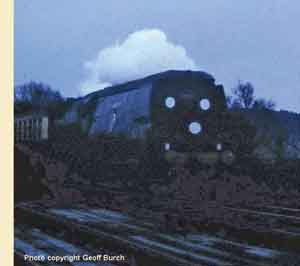 Churchill'; the Nine Elms crew being Driver Alf Hurley and Fireman James Lester. It was a cold and bleak winter's day when Alex and I positioned ourselves in the Up Yard adjacent to the Signal Box. My camera in those days was a Kodak Instamatic loaded with Kodak transparency film, which needless to say was totally inadequate for the poor wintry conditions. However I did manage one shot before Alex and I made our way back to Guildford.
Churchill'; the Nine Elms crew being Driver Alf Hurley and Fireman James Lester. It was a cold and bleak winter's day when Alex and I positioned ourselves in the Up Yard adjacent to the Signal Box. My camera in those days was a Kodak Instamatic loaded with Kodak transparency film, which needless to say was totally inadequate for the poor wintry conditions. However I did manage one shot before Alex and I made our way back to Guildford.
The full story of the journey by fireman, James (Jim) Lester - and a fine selection of lineside shots - can be found on the excellent Nine Elms website HERE; this site is dedicated to London's Nine Elms Locomotive Depot and the Enginemen who worked there.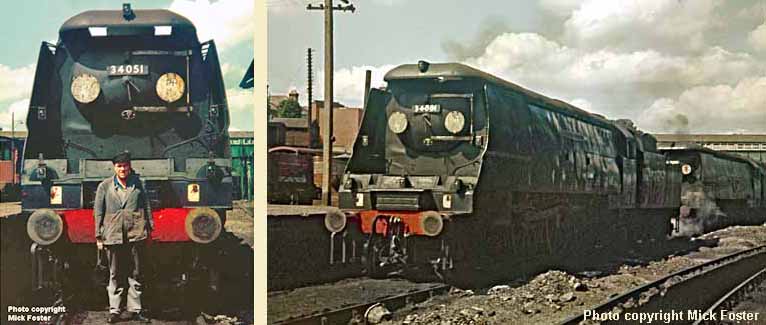
(Above) Mick Foster has kindly supplied these photos of BB Class 34051 Winston Churchill at Guildford Shed: the photo on the left shows Guildford Steamraiser 'Tuck' Tucker standing proudly in front of No 34051. Having joined the railway on the 31st March 1964, Mick filled the last appointed fireman's position at Guildford on 30th November 1964 and transferred to Woking, as I did, on 10th July 1967.
It was some months after the funeral train that I saw 34051 again when my regular Driver Alan Ackehurst and I worked an evening passenger service with the locomotive from Salisbury to Woking. A Salisbury-based engine (72B), she was in fine fettle and steamed easily; Alan worked her hard during the run and on leaving Grateley we reached speeds in excess of 80mph especially on our descent to Andover. I had the pleasure of firing on her several more times in the summer months of 1965 and eventually in September that year I was fireman on 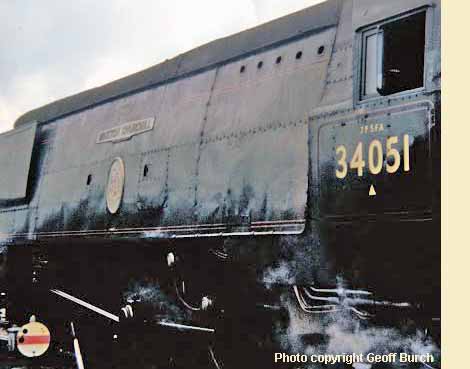 the 12.02 stone empties, again with Driver Alan Ackehurst, first working Light Engine from Guildford MPD to Woking Yard and then from Woking Down Yard to Salisbury. This turned out to be quite an eventful day, the first instance being asked by the signalman at Farnborough Main if we could shove back inside the Down Yard to allow another train to pass. Unfortunately (for the signalman) we couldn't quite clear the ground signal in the Yard (insert left) and so had to continue our journey. On reaching Salisbury MPD, the next task was to dispose of the engine, and so after cleaning out the smokebox I set about cleaning the fire. The general practise for cleaning the fire on the original Bulleid WC and BB class locomotives was to move the good fire up one side of the grate and open the dropgrate. Unfortunately, the dropgrate mechanism became disconnected and fell into the ashpan and I was instructed to dispose of the entire fire. The dropgrate incident was a deciding factor in marking the end of her working days, for 34051 was withdrawn on 19 September 1965 having covered 807,496 miles in service, and it is my belief that Alan and I were the last crew to have worked on her in steam.
the 12.02 stone empties, again with Driver Alan Ackehurst, first working Light Engine from Guildford MPD to Woking Yard and then from Woking Down Yard to Salisbury. This turned out to be quite an eventful day, the first instance being asked by the signalman at Farnborough Main if we could shove back inside the Down Yard to allow another train to pass. Unfortunately (for the signalman) we couldn't quite clear the ground signal in the Yard (insert left) and so had to continue our journey. On reaching Salisbury MPD, the next task was to dispose of the engine, and so after cleaning out the smokebox I set about cleaning the fire. The general practise for cleaning the fire on the original Bulleid WC and BB class locomotives was to move the good fire up one side of the grate and open the dropgrate. Unfortunately, the dropgrate mechanism became disconnected and fell into the ashpan and I was instructed to dispose of the entire fire. The dropgrate incident was a deciding factor in marking the end of her working days, for 34051 was withdrawn on 19 September 1965 having covered 807,496 miles in service, and it is my belief that Alan and I were the last crew to have worked on her in steam.  Nearly fifty years have now passed and an appeal has been launched to cosmetically restore 34051 for an exhibition at the National Rail Museum at York; the restoration work is being carried out by staff and volunteers at Mid-Hants Railway and a limited edition print by artist Phillip D Hawkins has been launched (inset right…details HERE) of '34051 hauling the ACE at Battledown (with part of the proceeds going towards the restoration fund).
Nearly fifty years have now passed and an appeal has been launched to cosmetically restore 34051 for an exhibition at the National Rail Museum at York; the restoration work is being carried out by staff and volunteers at Mid-Hants Railway and a limited edition print by artist Phillip D Hawkins has been launched (inset right…details HERE) of '34051 hauling the ACE at Battledown (with part of the proceeds going towards the restoration fund).
When I mentioned the calamitous dropgate incident to James Lester, 34051's fireman on the funeral train in September 1965, he replied - 'Whilst I was on the footplate of 34051 in Ropley Workshops last Friday (19th December 2014) I checked out the firebox and guess what? The drop grate trap-door is still there no doubt just where you left it, in the abyss? It's quite remarkable to think that the engine has never been steam since that time!' 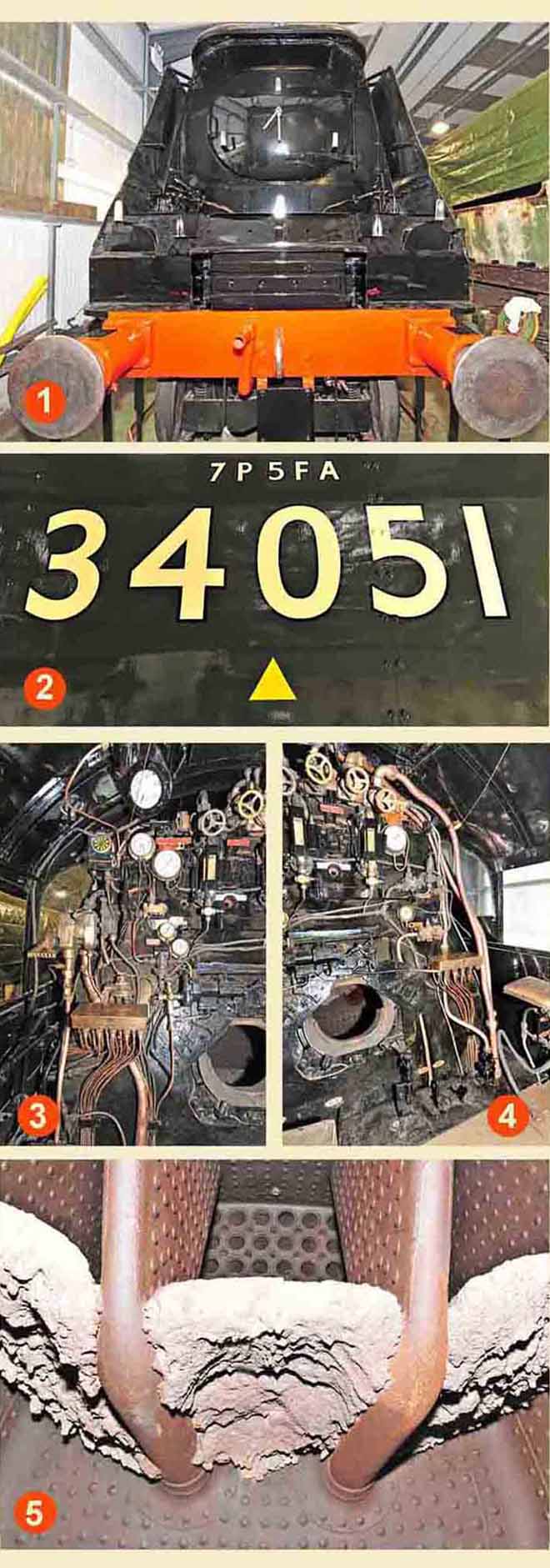
(Above-Below) On the evening of 7th January 2015, I was invited by Richard Bentley, the Operations Manager of the Mid-Hants Railway to take a look for myself and found the dropgrate had been restored to its original position. This collage of images is number 1-8...
1. Front end of 34051 - electric lights and smokebox number plate yet to be re-fitted prior to its journey to the NRM at York.
2. Cabside numberplate 34051 - 7P5FA relates to the locomotive's power codings - Class 7 Passenger, Class 5 Freight; the A relates to it's braking capabilities. The yellow triangle denotes that BR water treatment is used on the locomotive.
3. Driver's side view of the cab of 34051.
4. Fireman's side view of cab of 34051, both cab shots showing cosmetic restoration nearing completion at the Mid-Hants Railway.
5. Brick Arch & Tubeplate of 34051 - notice the firebricks have melted under the intense heat. Also shown are the Thermic Siphons; funnel-shaped steel fabrication that connects the bottom of the throat sheet (the front wall of the firebox) with the crown sheet (the roof of the firebox). Feed water flows upward through the siphons from the boiler barrel. By exposing the water to the heat of the firebox, thermic siphons increase thermal efficiency and help to improve water circulation in the boiler through ensuring more uniform temperatures within it.
6. Firebox grate area of 34051 showing rocker grates and dropgrate (indicated by the RED square).
7. AJAX Firehole door of 34051 and rocker grate and dropgrate catches plus brass indicator plates.
8. Freshly painted 'Winston Churchill' nameplate and fixing screws in the Mid-Hants Railway workshop prior to assembly.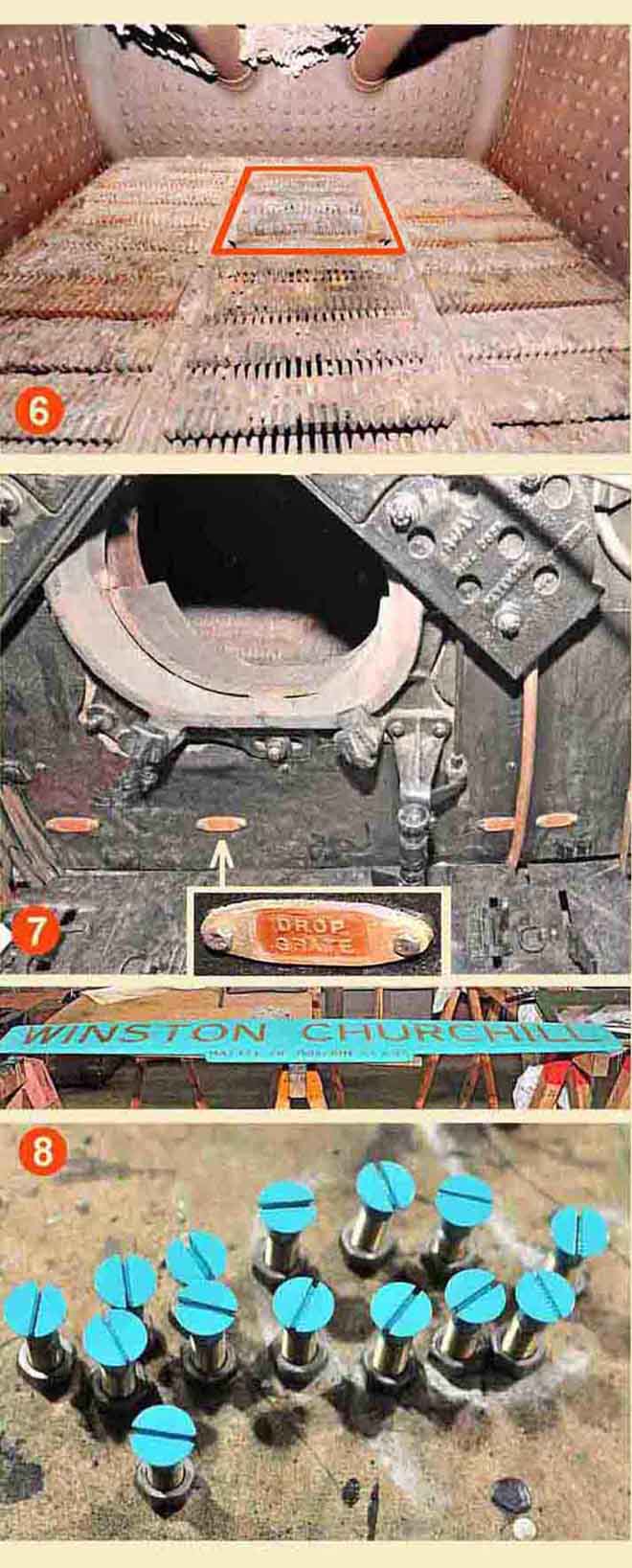
'A BRIEF MOMENT IN TIME - GUILDFORD MAY 29th 1961'
Photographer Richard S Greenwood MBE
Whilst in conversation with my friend Mick Stone, he mentioned receiving several scanned images of Guildford Shed and its environs sent to him by Richard S Greenwood MBE. My senses were immediately heightened when he showed them to me - all taken in 1961, the same year I started work at 70C as an engine cleaner. Seeing these images for the first time took my breath away and I immediately contacted Richard to 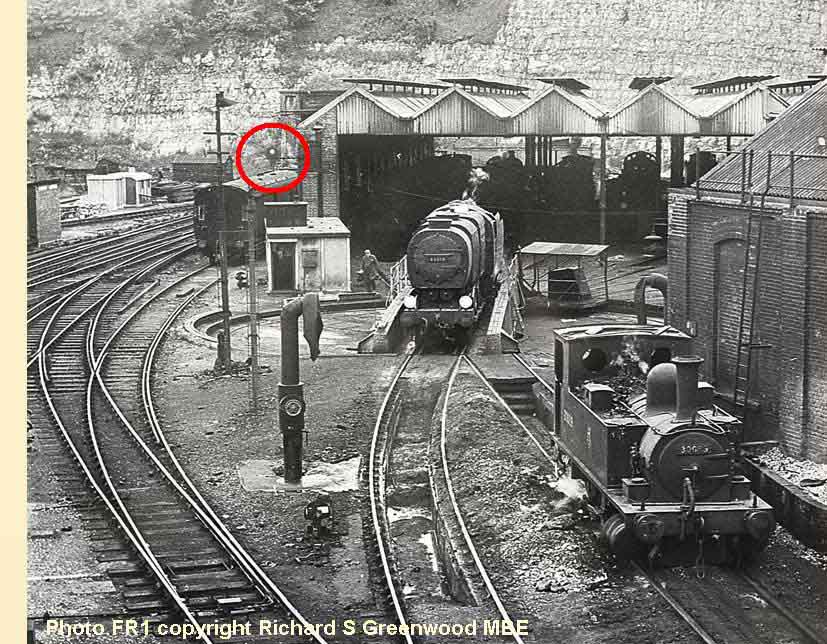 ask his permission to use them on my webpages. He readily agreed. I'm indebted to Richard because his superb photos revive so many memories of my first year at 70C...welcome to the first gallery of 'A Brief Moment in Time' featuring Richard's photos...
ask his permission to use them on my webpages. He readily agreed. I'm indebted to Richard because his superb photos revive so many memories of my first year at 70C...welcome to the first gallery of 'A Brief Moment in Time' featuring Richard's photos...
(Inset-Below) This photo shows the Shed Pilot B4 Class 30089 'Little Jim' standing on the Old Pit as Q1 Class 33019 moves onto the turntable on 29th May 1961. An interesting feature is the circular indicator or 'Bobbing Joey' as we used to call it, situated just before the mouth of the Chalk Tunnel. This track circuit indicator showed a black disc with a white ring when any portion of the track-circuited line was occupied by an engine, or an engine and vehicles, and a white disc only when the line was clear. The Signalman in Guildford South Box must satisfy himself by observation that the black disc appeared when an engine or an engine and vehicles had been shunted into the tunnel on the down line; and Enginemen and Shunters were instructed to see that the indicator showed a white disc only before carrying out a shunting movement into the tunnel. (Below) E4 Class 32468 trundles past the loco shed into the reception road and eventually into the coal stage area for disposal. The locomotive had failed for some reason and should have been working a return Horsham service.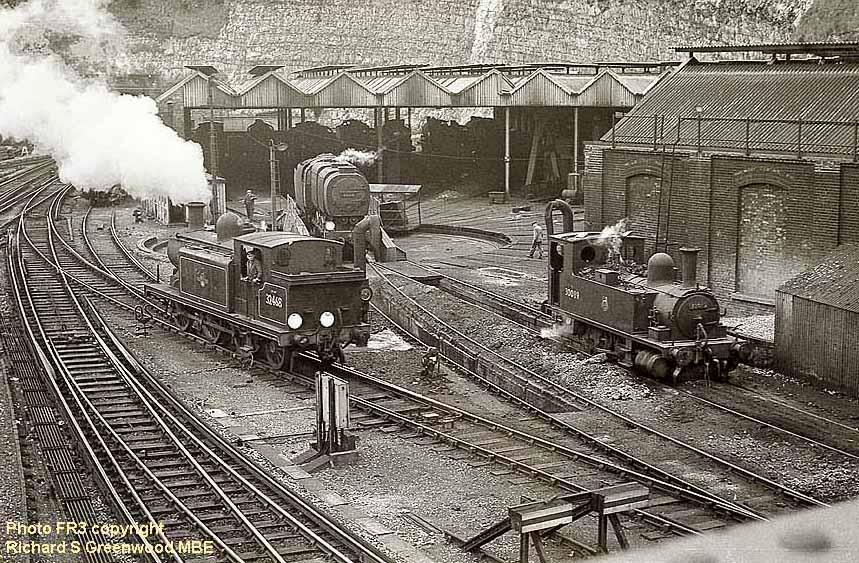
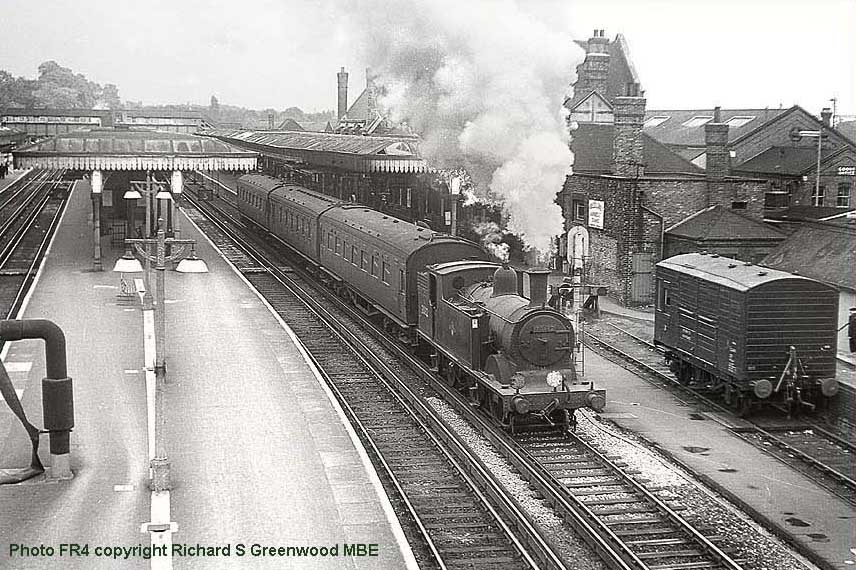
(Above-Below) Guildford-based M7 Class 30132 departs from platform 2 with a Horsham bound 3-coach set on the 29th May 1961. This service should have been worked by E4 Class 32468 which had previously failed. (Below) Q1 Class 33019 shunts the Breakdown Crane and associated Brake Van. 

(Above-Below) Guildford based C Class 31723 stands on the South end of the coal road on 29th May 1961. Designed by HS Wainwright in 1900, these 0-6-0 locomotives were the largest of the 0-6-0 classes to be found on the Southern, with locos being allocated to many sheds for mixed traffic duties. 31724 ended her days the following year and cut up at Eastleigh Works in 1962. Loco 31592 built in 1902, is preserved on the Bluebell Railway as SECR No 592. (Below) U Class 31633 departs platform 5 at Guildford with a stopping service to Redhill on 29th May 1961. Two workmen seem to be rodding out the drain leading from the downpipe stanchions on platform 8 and one of the chimneys of the Guildford Park Brickworks can be seen through the locomotive's chimney exhaust.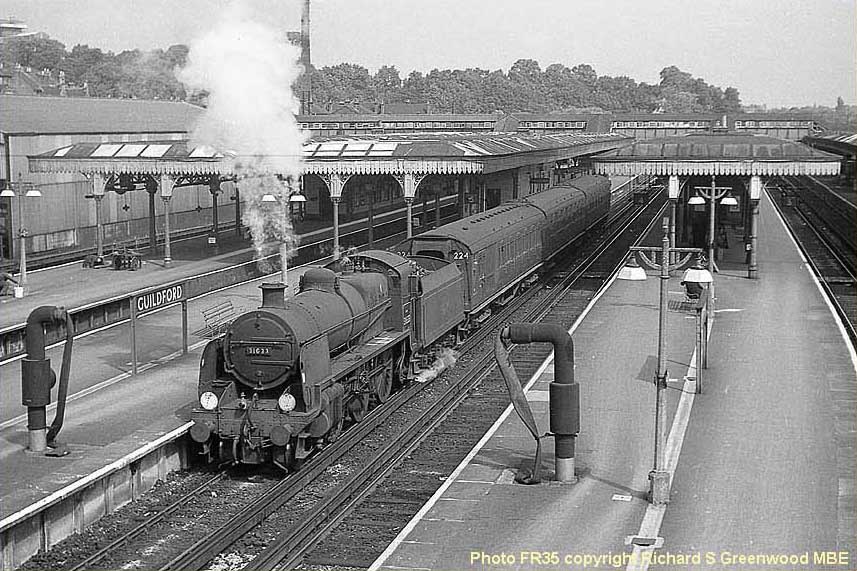
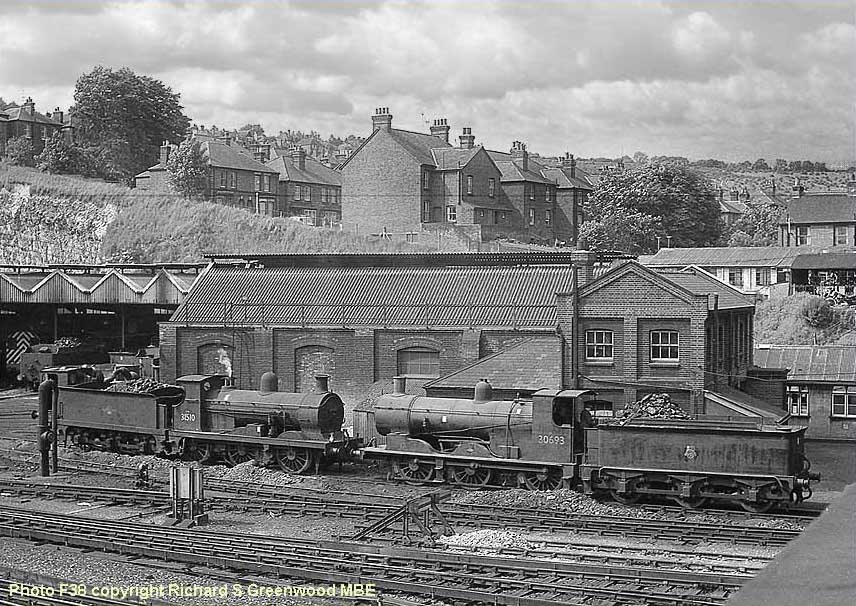
(Above-Below) C Class 31510 and 700 Class 30693 stand patiently on the Old Pit, both waiting for their turn to be berthed in the shed. The bicycle shed and staff canteen can be clearly seen in the background. (Below) N Class 31870 and E4 Class 32468 have now joined the queue to be placed in the shed behind B4 Class 30089. The Upper quadrant signal arm with a circle round the white band (WY45) when in the clear position, would allow a movement to the main line a far as the next stop signal whereas the ground signal (WY38) would allow a shunt movement as far as the line was clear. 

(Above-Below) Ex-GWR 2-6-0 4300 Class No 6385 runs into platform 6 and 7 with a Reading passenger service from Redhill on 29th May 1961.Turns worked by these types of locomotives were worked by Reading 'Western' depot crews. A number of notices displaying warnings about using the foot crossing are situated on the ends of each platform and an audible bell warning was also provided. (Below) A small freight train hauled by 700 Class 'Black Motor' 30350 runs tender first into plaform 3 (Up Cobham). This train had probably come from Godalming Goods and was one of the turns in the 'Old Man's Gang' involved working local freight services to and from Godalming or Dennis's sidings, Shalford or London Road station Yard. 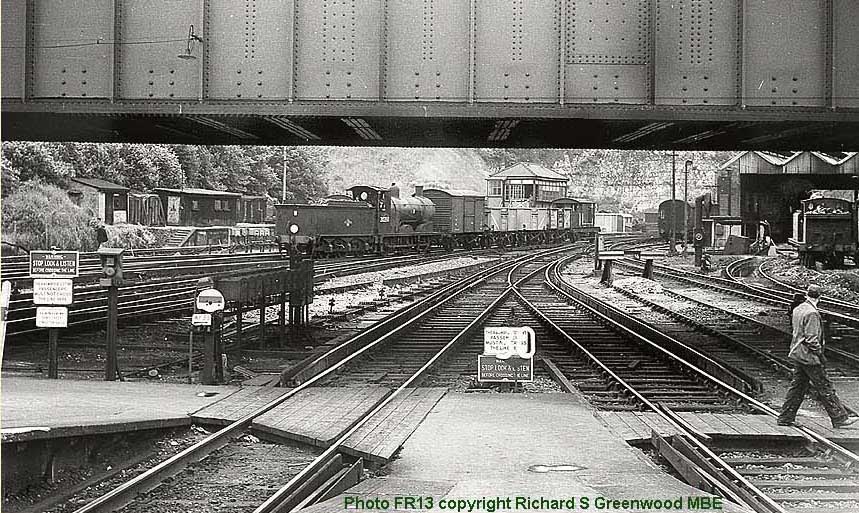
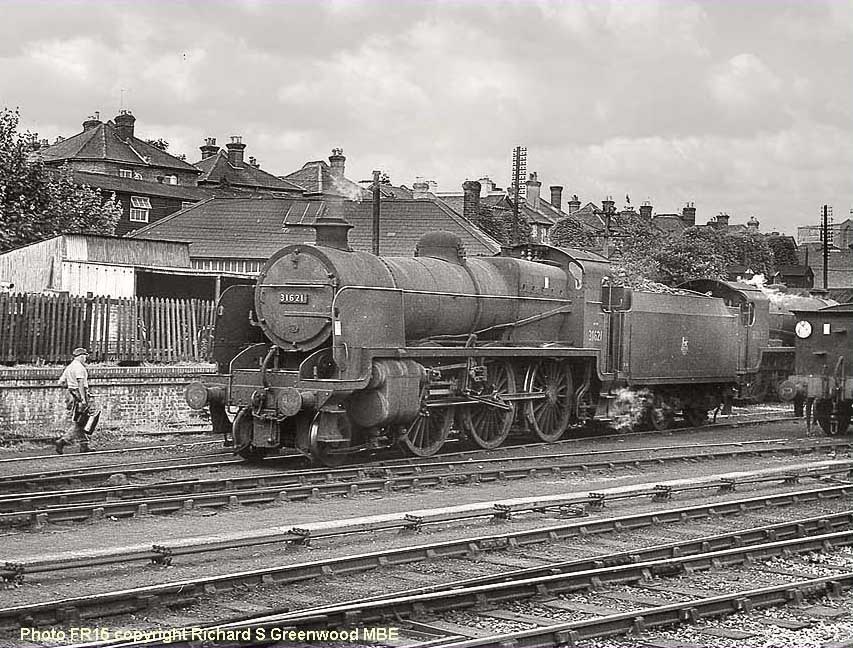
(Above-Below) The Driver with feeder in one hand and oil bottles replenished from the stores walks towards U Class 31621 which is in the engine road near the coal stage. 31621 was also based at Guildford (70C) and two of this type of loco (31625 and 31797) were temporarily converted to oil burning in 1947. Both were subsequently reconverted for coal burning. 31621 was withdrawn from service on 31st October 1964. (Below) With 'white feather' flying' N Class 31400 climbs the 1 in 100 bank towards Pinks Hill with a passenger service to Reading on 29th May 1961. The photo has been taken from the A3 bypass bridge and the land to the right of the photograph is now occupied by the University of Surrey Campus.
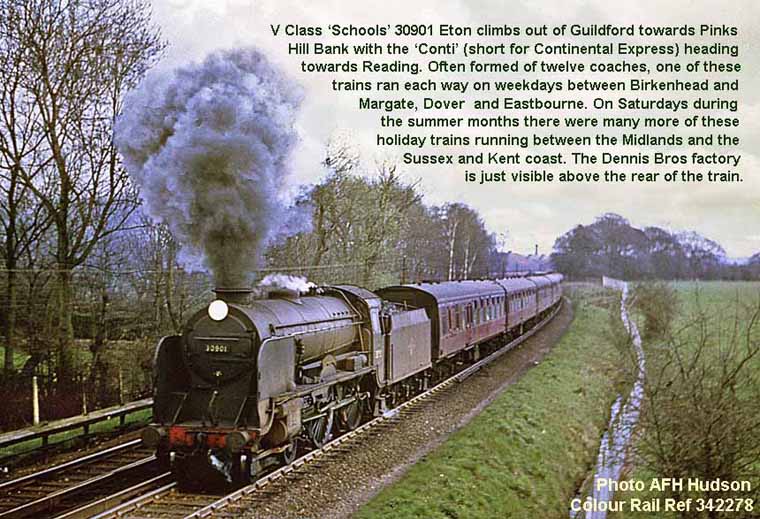
(Above-Below) This shot of V Class 'Schools' 30901 'Eton' climbing Pinks Hill Bank out of Guildford with a 'Conti' (short for Continental Express) is from the Colour-Rail collection…click here for link. The Dennis Bros factory can just be seen in the background. (Below) Q Class 30541 drops onto the turntable from the New Shed at 70C on 5th June 1964. An Ivatt 2MT Class 2-6-2T locomotive stands in No 1 road; the Ivatt tank locos replaced the ex-LSWR M7 Class 0-4-4Ts for passenger services over the Guildford-Horsham branch. The crane in the background is working on the new block of flats at Bishops Court.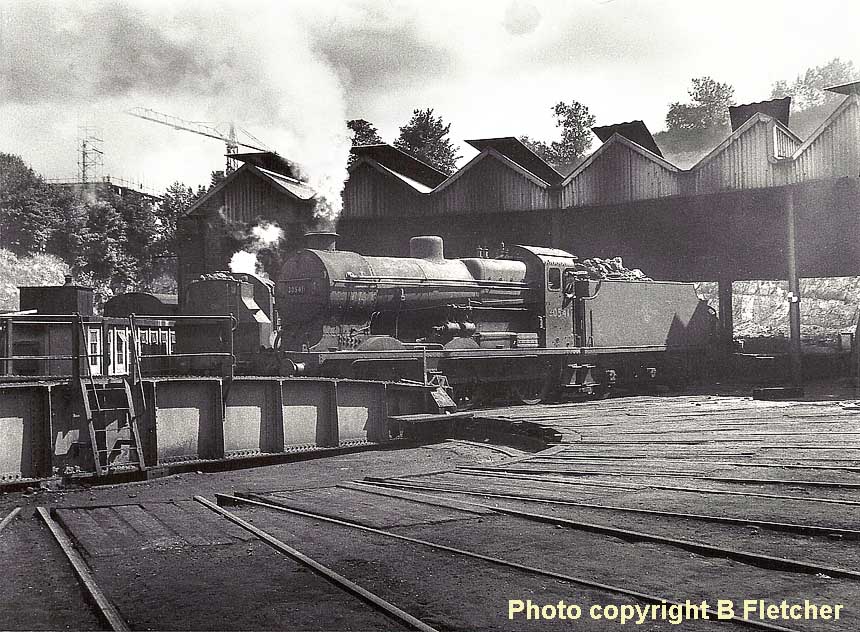
THE END OF GUILDFORD SHED (70C)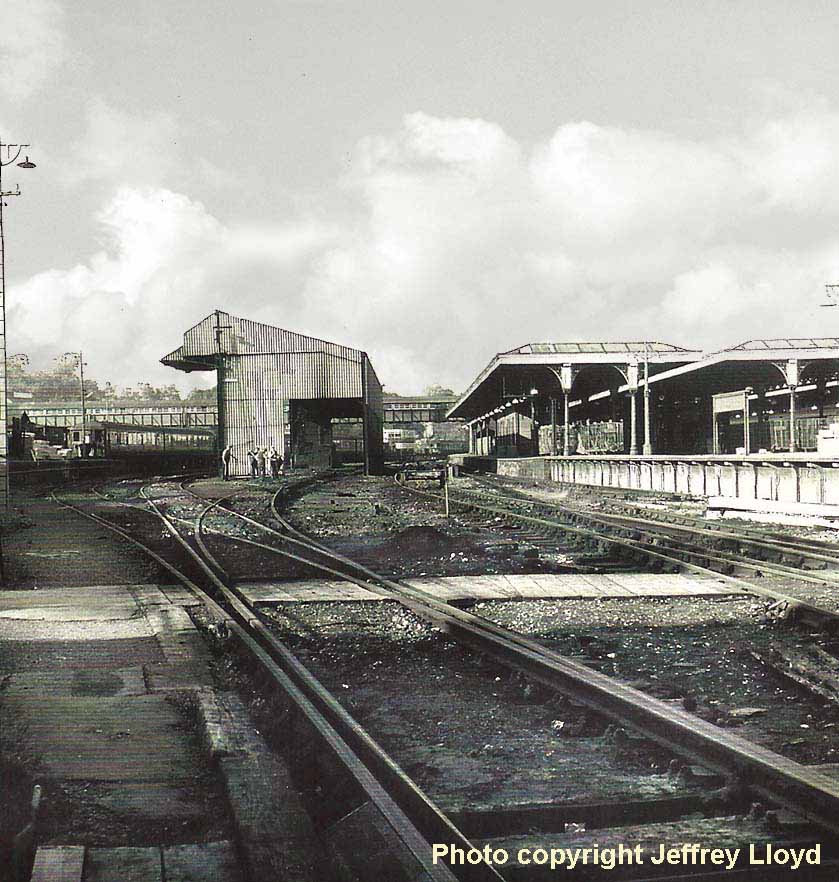
(Above-Below) A view from beneath Farnham Road Bridge looking towards the abandoned Coal Stage; workmen are already removing rails from the Coal Road. (Below) Viewed from the side of what was the Back Road of Guildford Coal Stage, demolition is well in progress. All of the structure that sheltered the two Volks electric coaling cranes has been cut into pieces by the use of an acetylene torch (even the rails of the disposal pit) and only the coalman's hut is left standing. 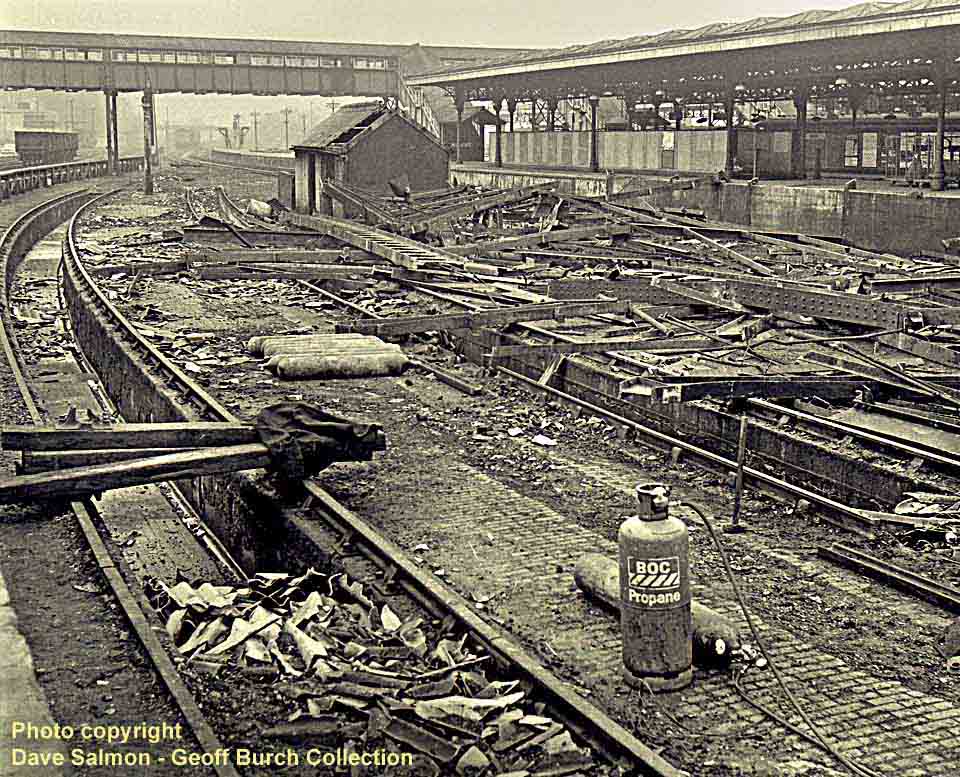
(Below) On 29th June 1970 the Coal stage has been demolished and workmen are now making headway to form a new car park.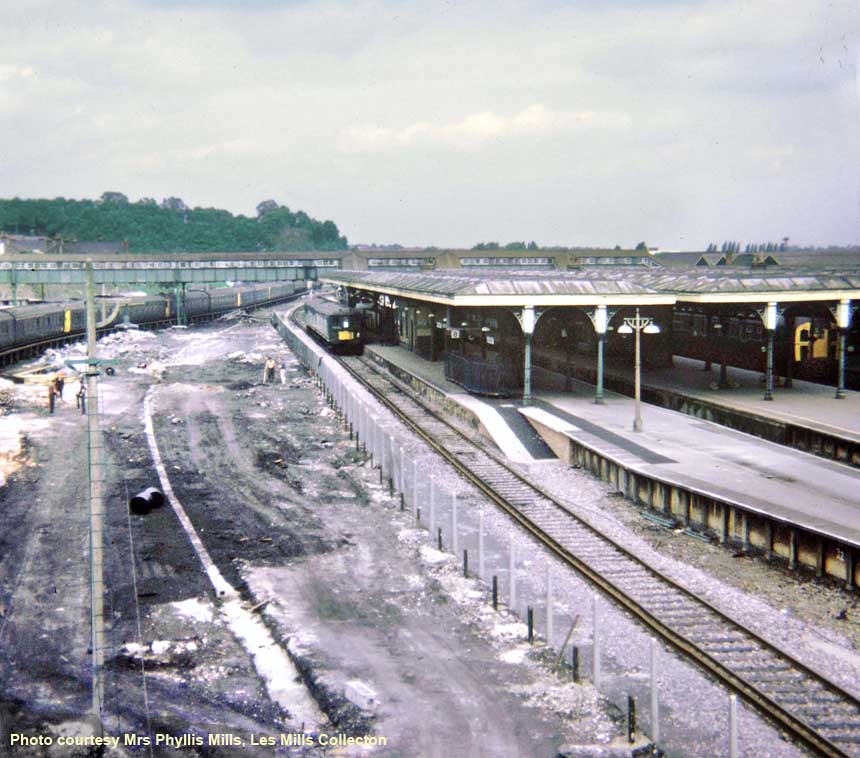

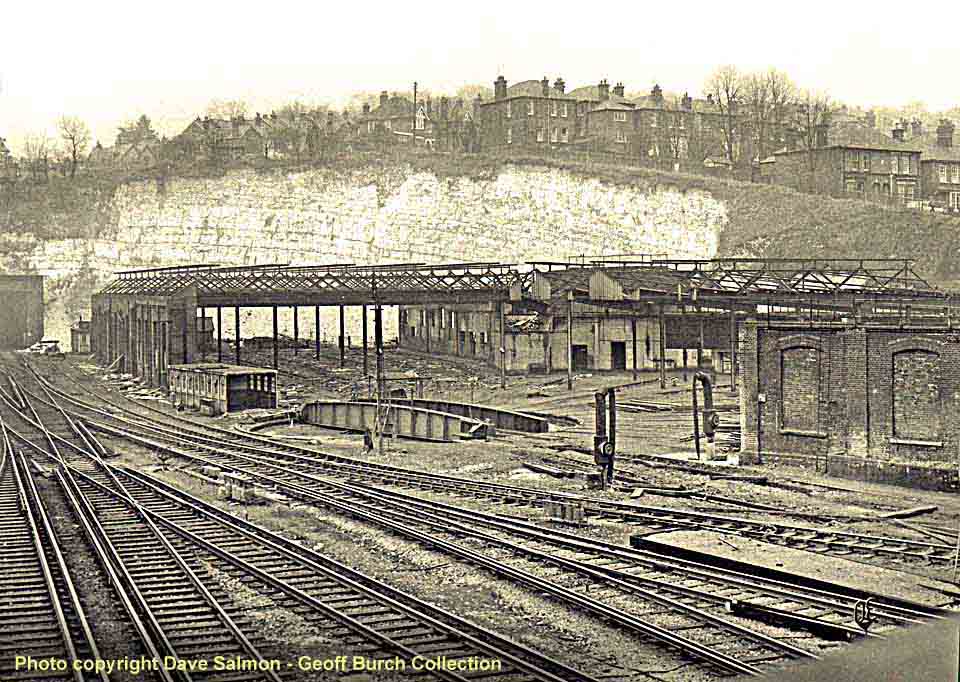
(Above-Below) A demoralising sight as Guildford Shed is being demolished following its closure in July 1967. The asbestos sheeting has already been stripped from the roof, all rails into the sheds have also been removed and the ironwork over-structure will be next. The prefabricated hut that housed the table crew and engine cleaning gang where I first started work still remains but is minus its front wall panel and door. (Below) A further view from Farnham Road bridge of the demolition of Guildford Shed. In the foreground, the building with the stripped roof served as the Running Foreman's office and Ambulance room (the Driver's cabin being adjoined to this nearer to the bridge wall). Every Saturday morning, one of the engine cleaners (quite often me and a job which I hated) would be tasked with scrubbing the stained linoleum floors of this building with carbolic soap. The Store Foreman's office and Fitter Foreman's office would also receive the same treatment. The archway to the right of the office led to the Driver's locker room. The brickwork to the left of the photo was the gable end of the second floor main office where the Shedmaster and his Chief clerk, List Clerk and Pay Clerks were situated.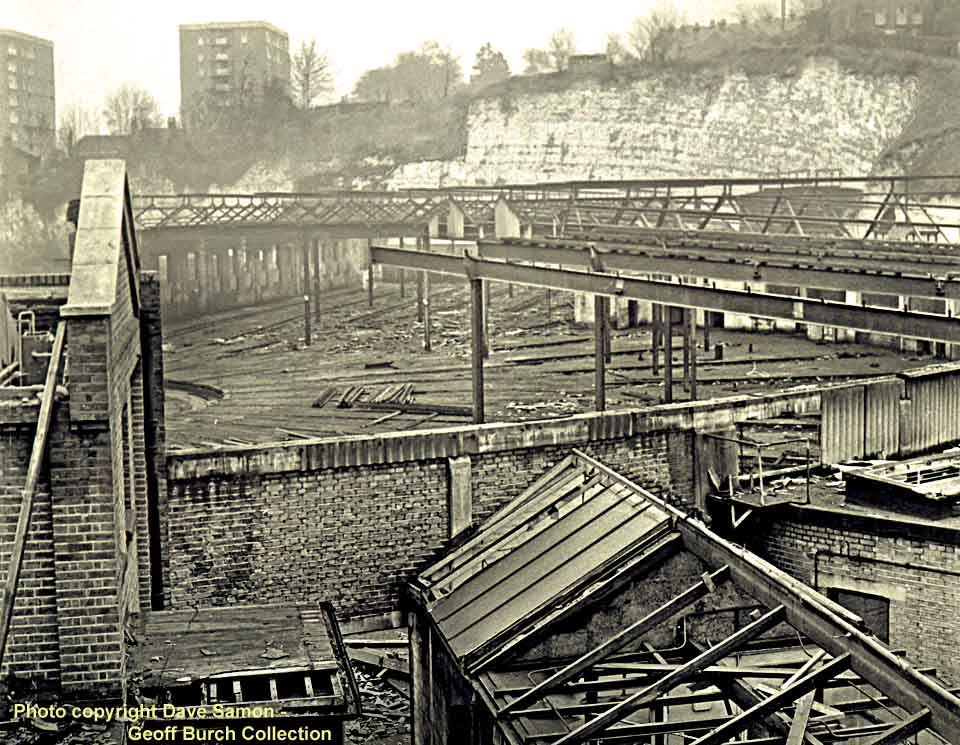
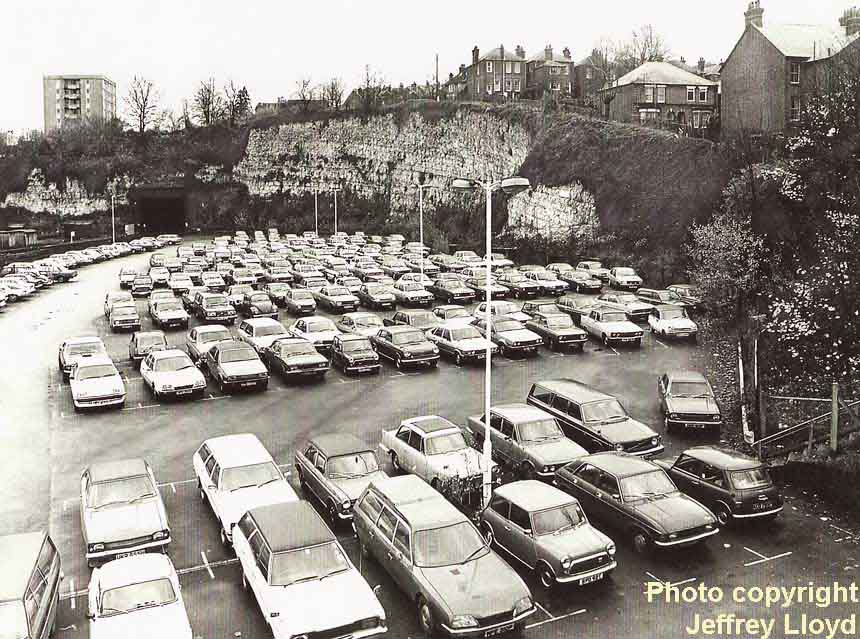
(Above-Below) Another view from the parapet of Farnham Road Bridge looking towards the area where the semi-roundhouse loco shed once stood. The concrete steps that led from Farnham Road to the depot can still be seen to the right of the photograph. (Below) On 29th June 1970 the footings are being concreted to support the steel girders for the multi-storey car park and on the right the completed building belies any evidence of a once-busy steam locomotive depot.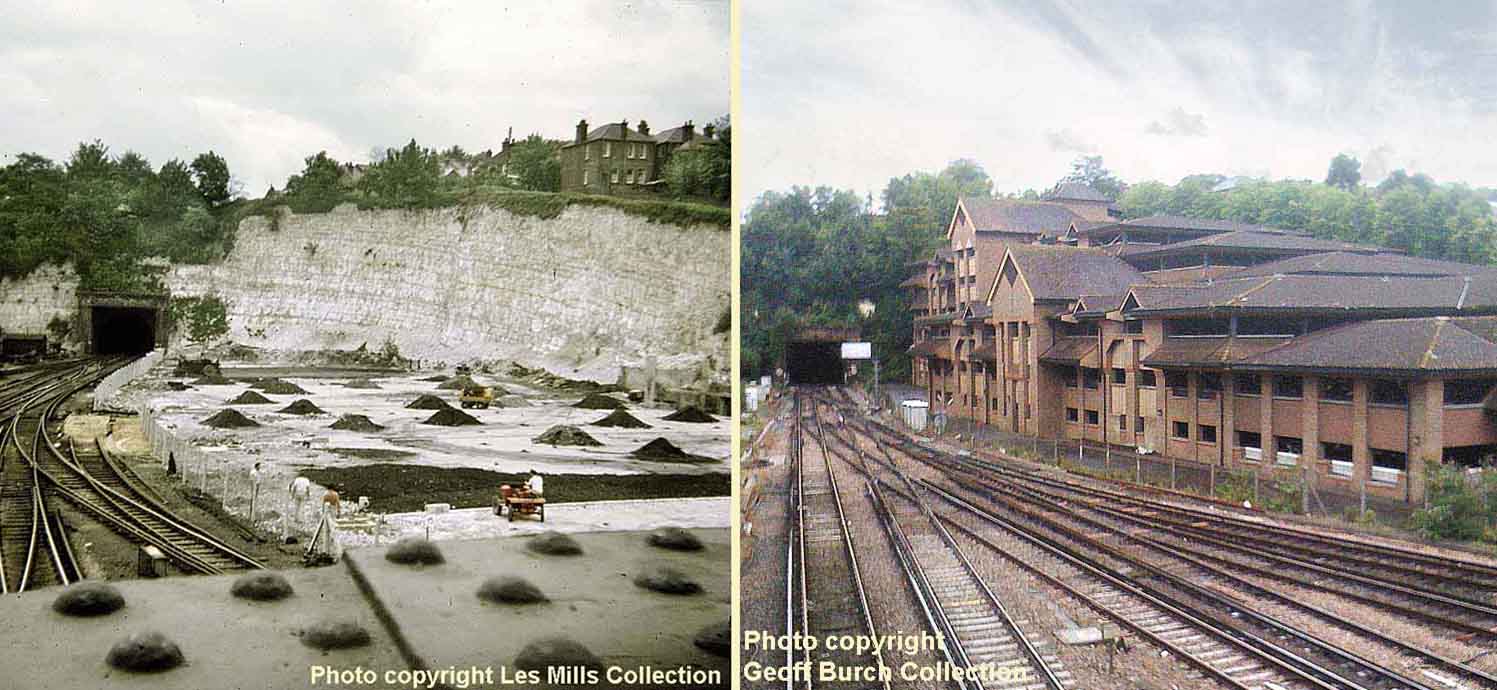
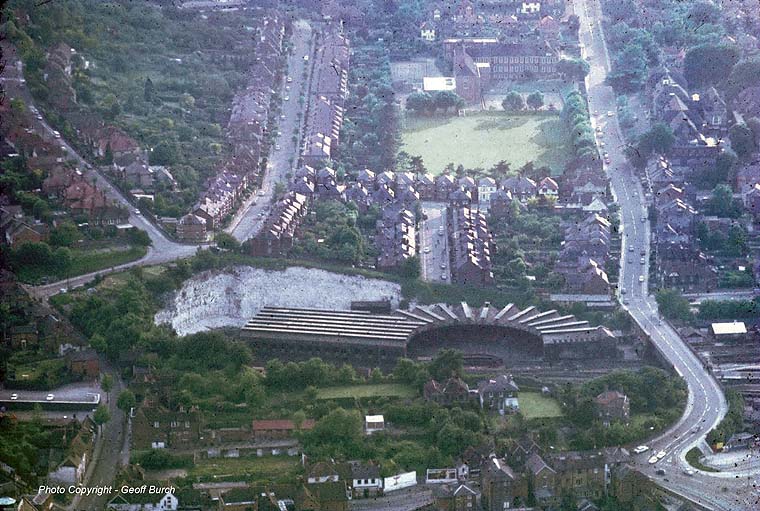
(Above-Below) These aerial shots of Guildford will give readers a better idea of where Guildford MPD was situated. I took this photo (above) from an Auster light aircraft (of which I was a passenger) in 1967 just after the shed closed. The second shot (below) was taken from a hot air balloon as my Dad and I passed over Guildford some 20-odd years later. It shows the huge multi-storey car park that now occupies the area where 70C once stood. The two signalboxes (Yard Box and South Box) have been removed as well as the panel box that followed it! The present panel box is situated at the southern end of the station and the only two carriage sidings that exist are the ones shown in the photograph with EMU slam door stock berthed there.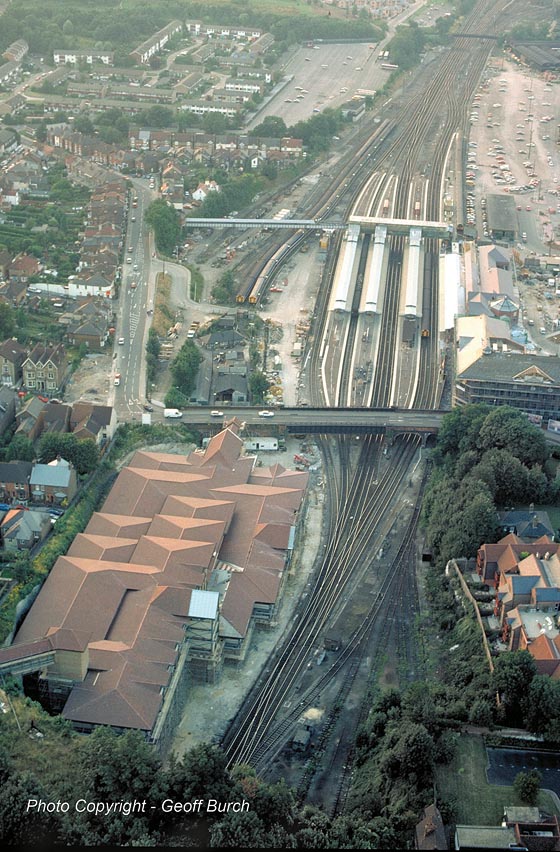
A BRIEF MOMENT IN TIME - GUILDFORD - MAY 30th 1961
The Richard S Greenwood MBE Collection - 2 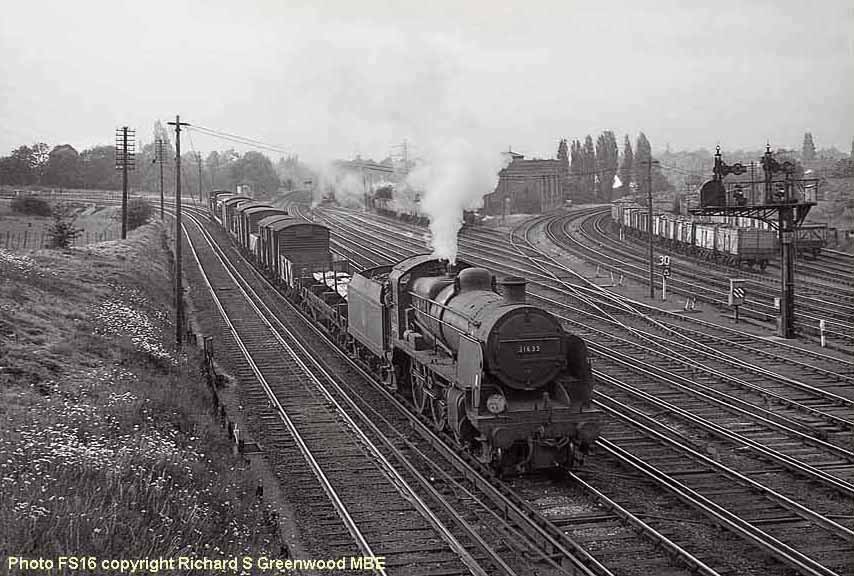
(Above-Below) Guildford Shed (70C) locomotive U Class 31635 trundles down the bank towards Guildford Up Yard with a evening mixed freight from Aldershot. (Below) Brighton based E4 Class 32509 runs into platform 3 (Up Cobham) with the 10.14 ex-Horsham passenger service on the morning of 30th May 1961. Meanwhile, on the turntable, an unidentified 700 Class 'Black Motor' is being turned to take her place in the shed and B4 Class 30089 'Little Jim' is berthed in her normal place in the Stores Road. By the looks of it, the top of the chalk cliff has also subsided and created a whiter colour to the chalk.
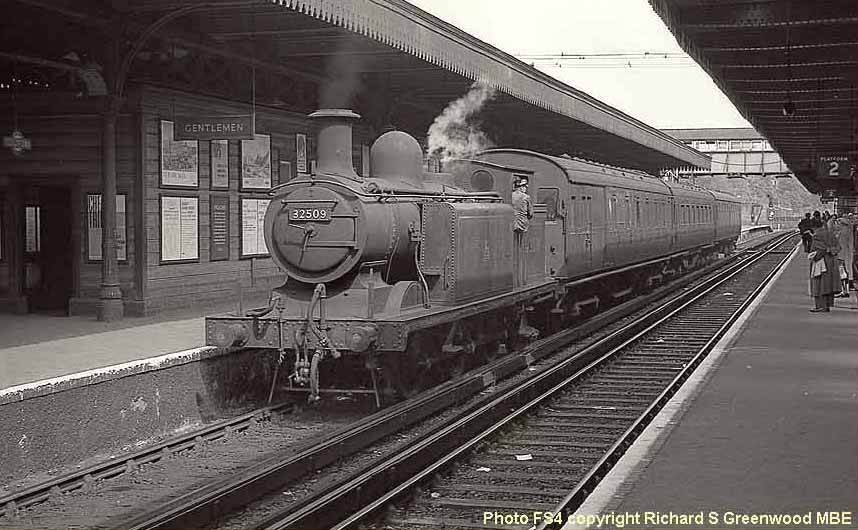
(Above-Below) E4 Class 32509 has run round the train in platform 3 (Up Cobham) and is waiting to propel the empty coaching stock towards the London end of the station to return to platform 2 (down Cobham) and form the 10.34am passenger service back to Horsham. The passengers on platform 2 await the train's arrival. Behind the locomotive, two posters advertise two holiday destinations - one to the Isle of Man and the other to Loch Erie, Ireland. (Below) Brighton based E4 Class 32509 shunts the empty coaching stock from platform 3 to platform 2 to form the 10.34am passenger service to Horsham on 30th May 1961. She was withdrawn from service on 31st March 1962 and cut up a month later. E4 Class 32473 is preserved on the Bluebell Railway in LBSCR livery as No. 473 and carries its original name 'Birch Grove'.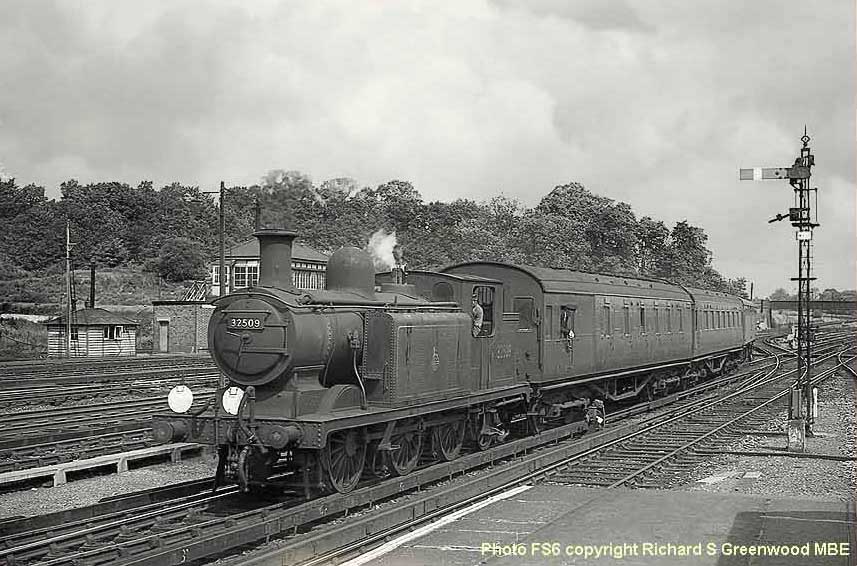
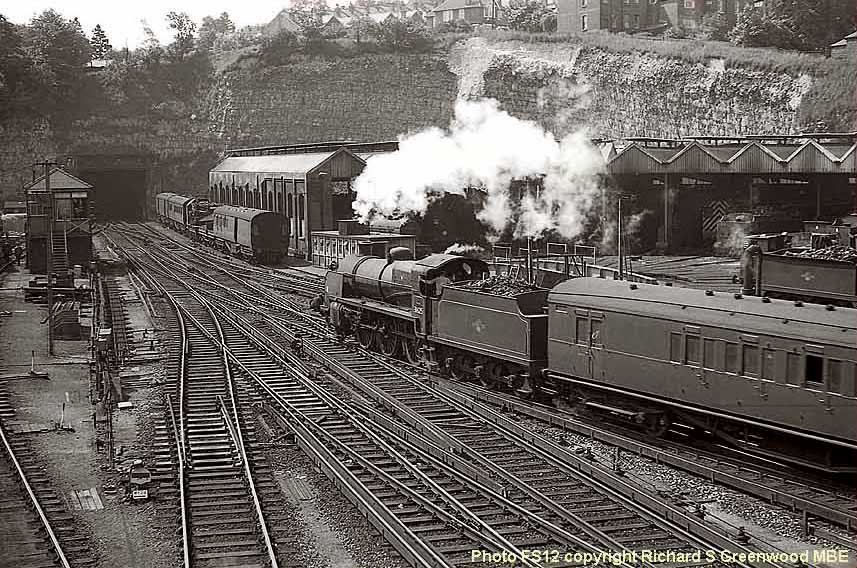
(Above-Below) U Class 31625 leaves the station and passes Guildford shed with a Reading - Redhill passenger service on 30th May 1961. The breakdown crane can be seen berthed between the New Shed and the Up running line. (Below) Viewed from Yorkie's Bridge, Ivatt Class 41301 shunts a horsebox into Guildford Up Yard Cattle dock for unloading. This has been transported from Horsham on an earlier regular passenger service. 'Moons Timber Merchants' premises can be seen in the background and the old gas works can be seen on the horizon.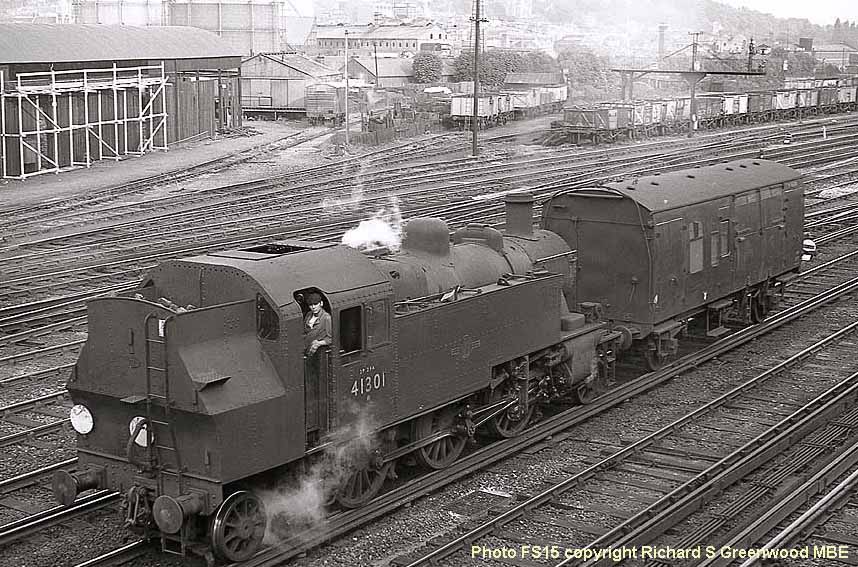
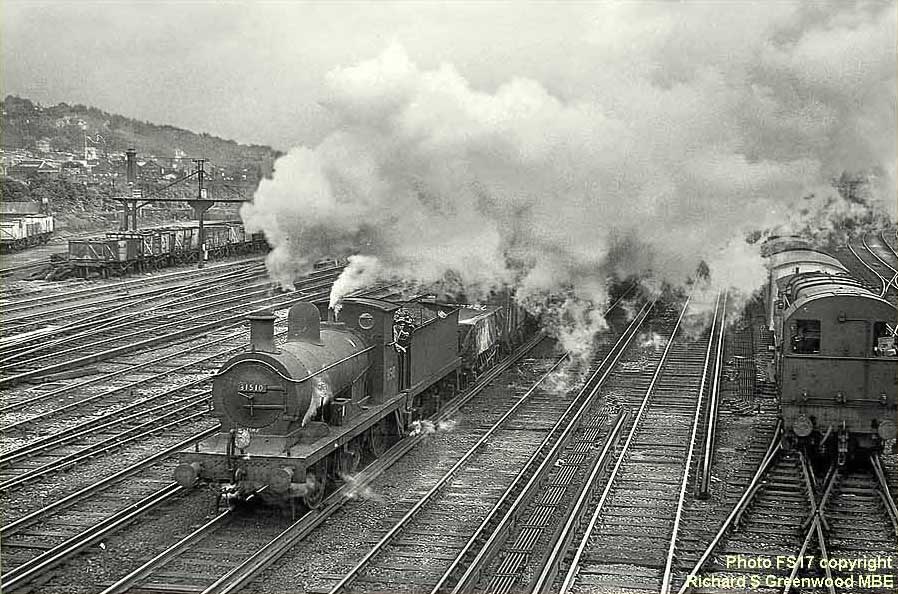
(Above) C Class 31510 departs Guildford Up Yard with a freight for Woking Yard on 30th May 1961. Unable to perform any shunting whilst this move takes place, the Driver of the 350hp diesel shunter takes a break and reads his newspaper. Note that the 350hp shunter doesn't display any black-yellow chevron markings.
GUILDFORD RAILWAYMEN
(Above-Below) Shedman Frank Mitchell glances towards the photographer as he makes his way towards the coal stage and disposal pits with his trusty shovel...a laborious task! Frank would load a low-sided wagon  with clinker that had been deposited by firemen after disposal duties of their locos. There wasn't much that Frank didn't know about horse racing - and, typically, Frank is seen here with a 'roll up' of his favourite Old Holborn tobacco dangling from the corner of his mouth. (Below) Guildford fireman Paul Schofield keeps a look out for the stop mark on the platform as the Driver uses the vacuum brake while running into Guildford with a passenger service from Reading to Redhill; the loco is a V Class 'Schools'. The original 'Bridge House' is visible in the background.
with clinker that had been deposited by firemen after disposal duties of their locos. There wasn't much that Frank didn't know about horse racing - and, typically, Frank is seen here with a 'roll up' of his favourite Old Holborn tobacco dangling from the corner of his mouth. (Below) Guildford fireman Paul Schofield keeps a look out for the stop mark on the platform as the Driver uses the vacuum brake while running into Guildford with a passenger service from Reading to Redhill; the loco is a V Class 'Schools'. The original 'Bridge House' is visible in the background.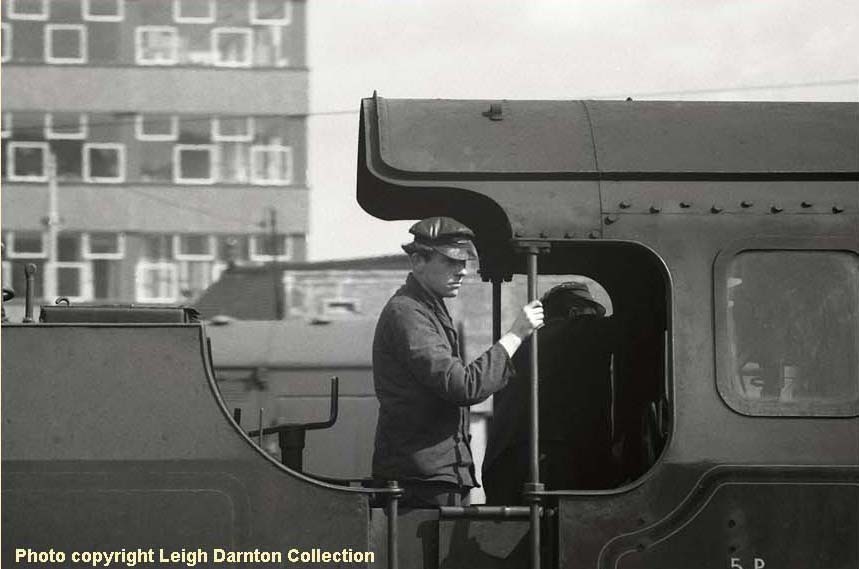
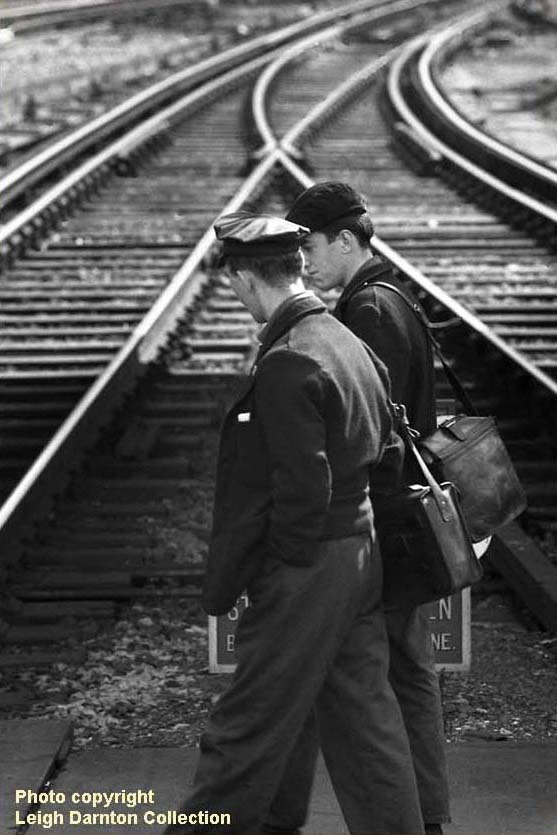
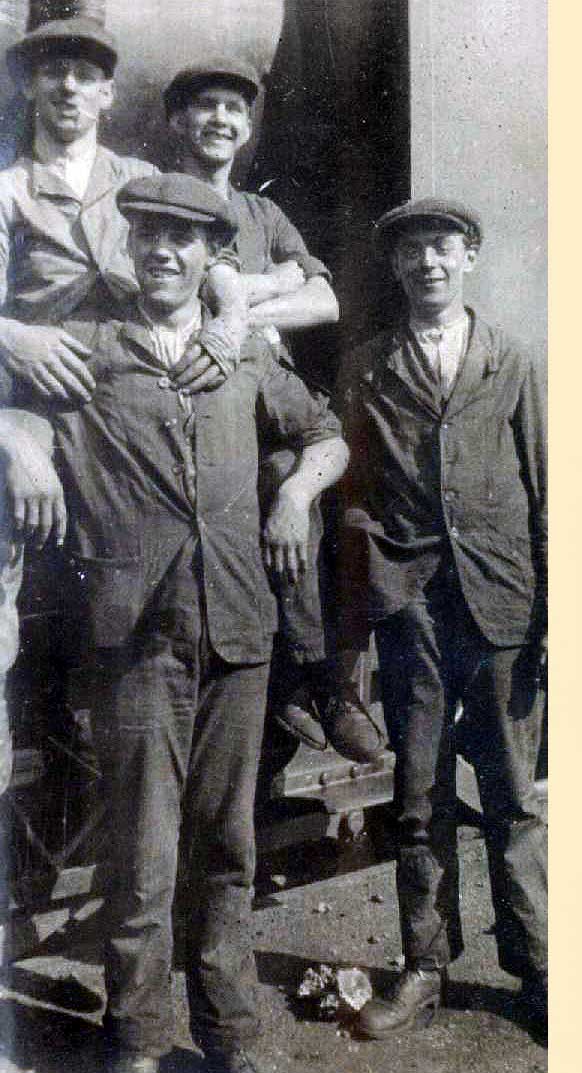 (Above) A pair of locomotive crew make their way from Guildford MPD to the station using the foot crossing situated at the Country end of the platforms adjacent to Farnham Road Bridge. Following two fatal accidents, including one when an engine cleaner was killed whilst he and a colleague were pushing a hand-barrow across this lines, the crossing was condemned and taken out of use. From then on, all loco staff had to use platform 8 and the passometer stairs to access other platforms; the walking times allowed were adjusted accordingly.
(Above) A pair of locomotive crew make their way from Guildford MPD to the station using the foot crossing situated at the Country end of the platforms adjacent to Farnham Road Bridge. Following two fatal accidents, including one when an engine cleaner was killed whilst he and a colleague were pushing a hand-barrow across this lines, the crossing was condemned and taken out of use. From then on, all loco staff had to use platform 8 and the passometer stairs to access other platforms; the walking times allowed were adjusted accordingly.
(Insert Left & Right) 'The Old Boys!' These photos were sent to me by Mike Wallace, a relative of Driver Reg Beer who was my regular mate in the 'Old Man's Gang' in 1962. As so often happened back in the old days, it was nigh on impossible to get promotion to a drivers job at your own depot, hence quite a number of railwaymen moved from the West Country to further their careers on the railway in the Surrey and London area…they 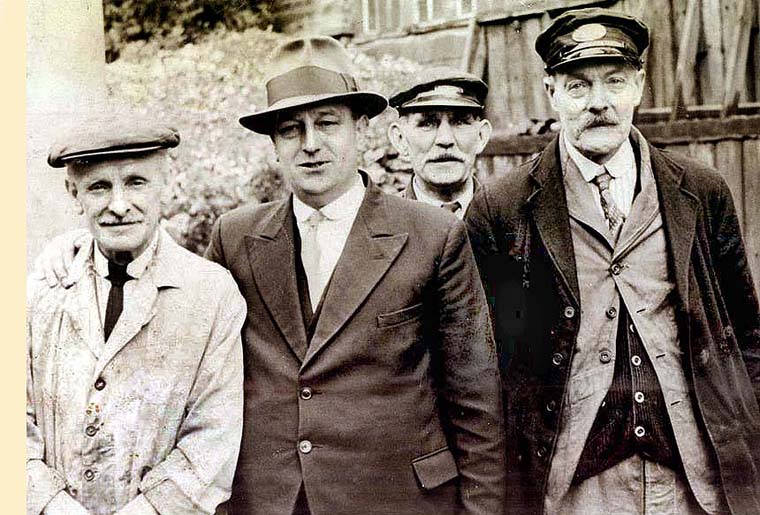 were known as 'Devons'. The first photo (left) is of Reg Beer with some cleaner buddies at Guildford and the second (right) shows a group of Guildford men, including Mike Wallace's Grandfather Driver Randall (at the back) and the man wearing the trilby hat is Fred Price - one of the Running Foremen at Guildford MPD when I started work there. He was also Acting Shedmaster when George Stovold was on holiday. (Below) The driver of the coal stage duty takes a look at the wagon label, the wagon being left there for Frank Mitchell to load with ashes. Note the empty cattle wagons and horse box berthed in Guildford Up Yard in the background.
were known as 'Devons'. The first photo (left) is of Reg Beer with some cleaner buddies at Guildford and the second (right) shows a group of Guildford men, including Mike Wallace's Grandfather Driver Randall (at the back) and the man wearing the trilby hat is Fred Price - one of the Running Foremen at Guildford MPD when I started work there. He was also Acting Shedmaster when George Stovold was on holiday. (Below) The driver of the coal stage duty takes a look at the wagon label, the wagon being left there for Frank Mitchell to load with ashes. Note the empty cattle wagons and horse box berthed in Guildford Up Yard in the background.
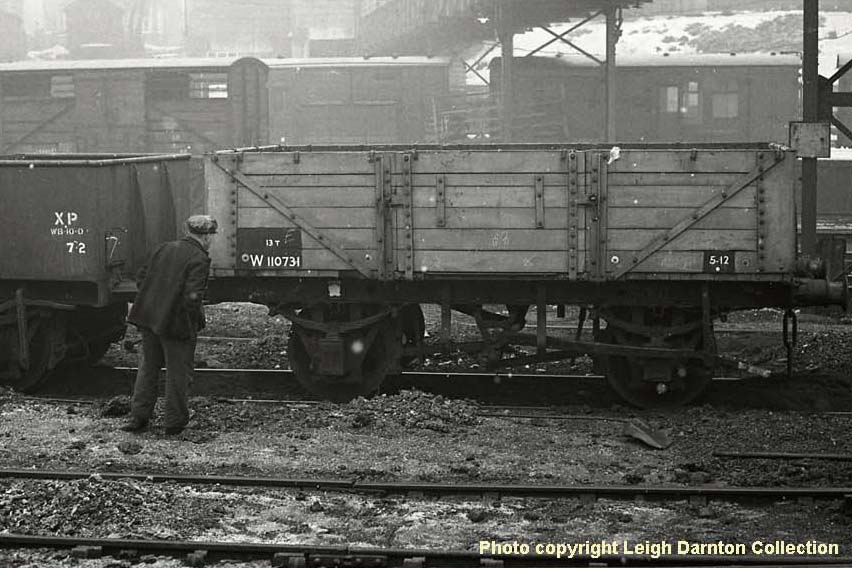

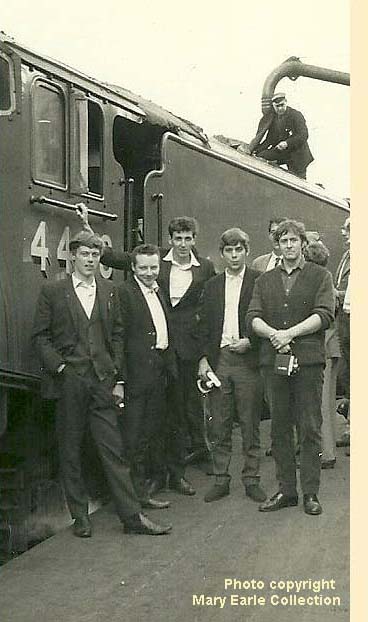 (Above) Guildford fireman Geoff Ball smiles for the camera whilst working the Guildford Pilot duty with Ivatt Class 41301. These locos were ideal for working this type of turn and a fireman's boon when it was time for disposal duties at the end of the day because of their rocker grate arrangement.
(Above) Guildford fireman Geoff Ball smiles for the camera whilst working the Guildford Pilot duty with Ivatt Class 41301. These locos were ideal for working this type of turn and a fireman's boon when it was time for disposal duties at the end of the day because of their rocker grate arrangement.
(Inset) This group photo of Class A4 Pacific 4498 'Sir Nigel Gresley' on tour of the Southern on 4th June 1967 is from the late Ken Earle's collection and was sent to me by his widow Mary. Ken took this shot of his Guildford colleagues during an 'awayday' as 4498 takes water at Weymouth. They are from left to right: Mick Foster, Alex 'Mac' McClymont, Dave 'Treacle' Hewson, Ray Bartlett and Lew Wooldridge. For the record, Mick Foster left the footplate grade and joined the BTP (British Transport Police) becoming an Inspector in later years and ended his career responsible for Royal Train duties. Alex McClymont is still working as a Shunt Driver for South West Trains, Dave Hewson is a Driver for West Coast Railways and has driven several trains recently with this class of loco over Southern routes, Ray Bartlett is still a Driver and works out of Exeter and Lew Wooldridge is retired but still enjoys the odd railtours.
(Below) I was recently contacted by freelance writer, Malcolm Wyatt, whose father Bob Wyatt worked as a fireman at Guildford shed. At the time I was an engine cleaner at Guildford back in 1961 and his Dad was about to leave the railway for a job on the post office. Affectionally known as 'Lofty' (because of his 6ft 4 in frame), work colleagues also nicknamed him 'Wyatt Earp' (after the 1955 - 1961 cowboy series in the early days of B/W television starring Hugh O'Brian). Bob's love for steam engines and the men that worked on them has obviously rubbed off onto Malcolm, whose review of both my books can be found here. Malcolm has also kindly sent me this 1957 photo (below) showing his Dad on U Class 31627 (taken by Charlie Boskett his driver that day).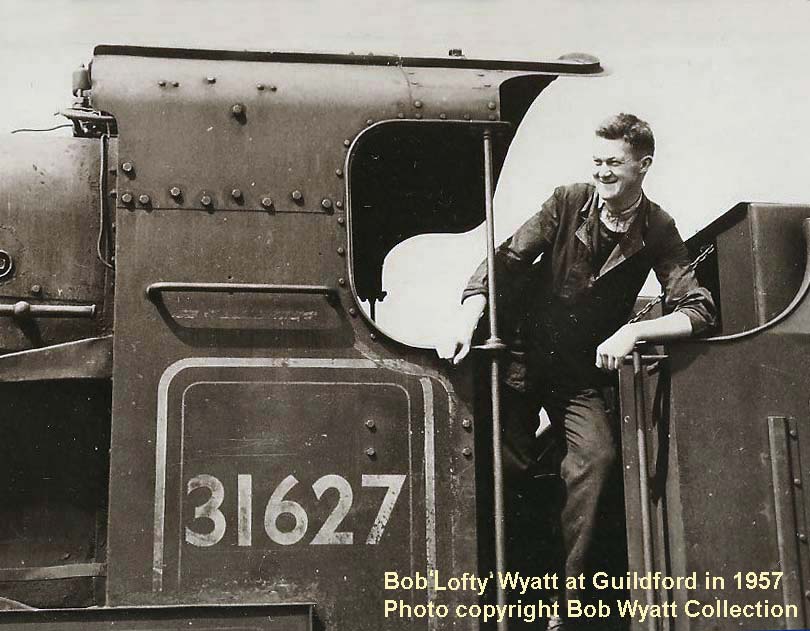
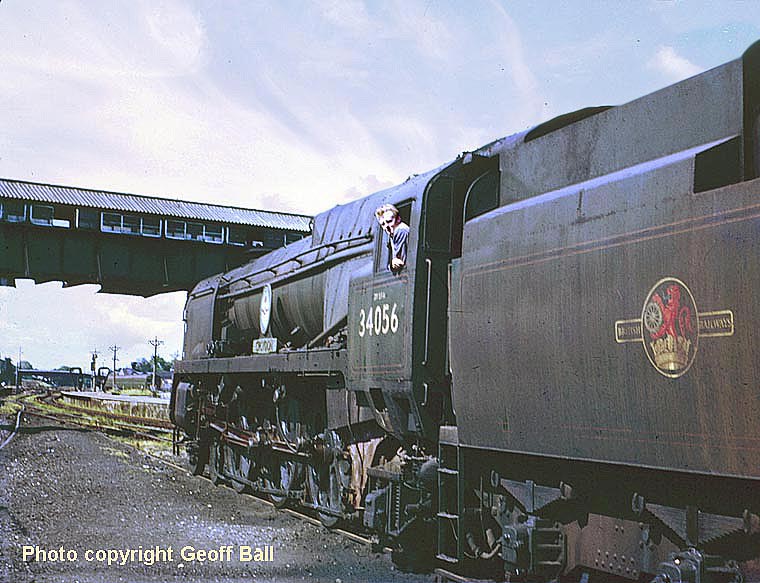
(Above) Guildford fireman Jim Woods looks out from the cab of Rebuilt Battle of Britain Class 34056 'Croydon' whilst berthed in the Coal Road at Guildford in the summer of 1966. I had the honour of being the Best Man at his wedding the following year. The Battle of Britain nameplate represents a First World War Royal Flying Corps airfield originally known as Waddon. It became a major civil airport in 1920 and RAF Croydon on August 29 1939. The RAF left in 1946 and civil flying resumed. An imposing memorial 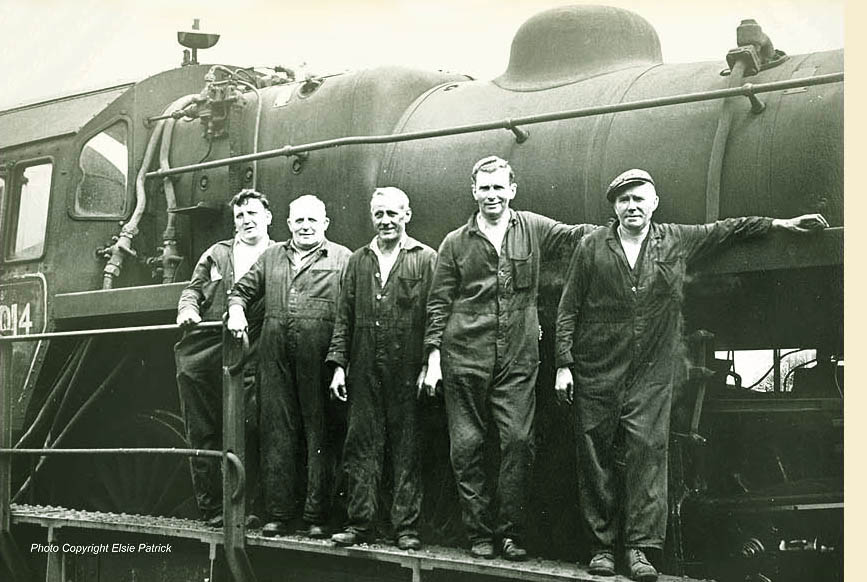 to personnel who served at the airfield was unveiled in 1991. A Salisbury based locomotive at that time, 34056 was withdrawn from service in May 1967.
to personnel who served at the airfield was unveiled in 1991. A Salisbury based locomotive at that time, 34056 was withdrawn from service in May 1967.
(Inset) Some of the Fitters that worked at Guildford MPD in the 1960s. They are from left to right: Brian Mitchener, Ivor Hopkins, Bob West, Reg Patrick and Henry Walsh. The men pose together on the turntable with BR Standard Class 3MT 77014 in the background.
(Below) Charlie Hampshire's journal shows I was his fireman on duty with BR Standard Class 73037 on 4th March 1966, the day before my 20th birthday. On this day we had taken BR Class 5MT Standard 73037 light engine to the Pre-Assembly Depot (PAD) at Shalford and then worked a rail train to Hook (for the Bournemouth Electrification Scheme). As shown, there was lots of overtime to be made during this period. I had some great times with Charlie (both on the railway and off) as we were both keen motorcyclists at that time. Always a true romantic, we'd both reminisce over our respective love lives. (Below Right) A little over a year later and I was again fireman on duty when Charlie laments the passing of steam in his journal on 18th June 1967 - 'Alas my steam days are over - how glorious they have been…' 
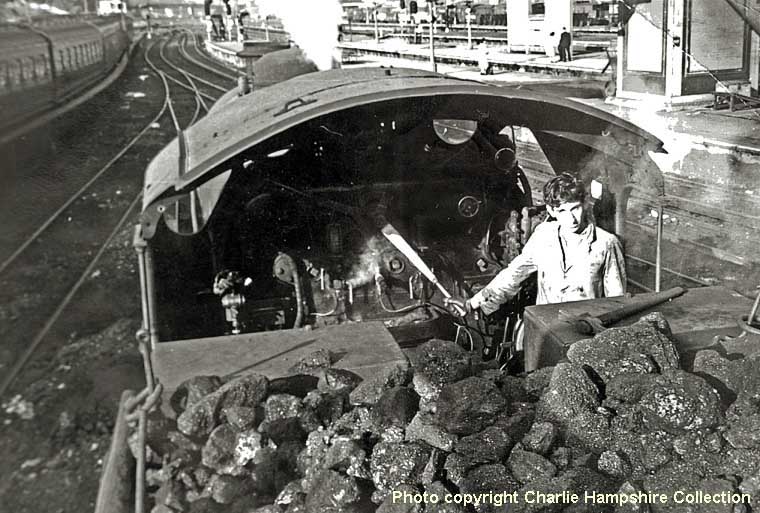
(Above-Below) Fireman Charlie Hampshire opens the regulator on a U Class in the reception road at the coal stage at Guildford. Charlie was probably Ted Fry's fireman at the time. He was also Stan Harms's fireman before I moved up to the Top Link to join Stan. (Below) A trio of firemen young and old alike pose for the camera with LMS Ivatt Class 2-6-2T 41294 - In the cab from left to right are John Richardson and Charlie Hampshire whilst a young-looking Dave Salmon is standing in the foreground. 

(Above-Below) This photo shows Driver John Berriman, who was the driver of the LMS Ivatt 41294 featured above. (Below) Driver Jim Farley (nicknamed 'Sixpenny Jim') oils round an M7 Class tank at Guildford station. 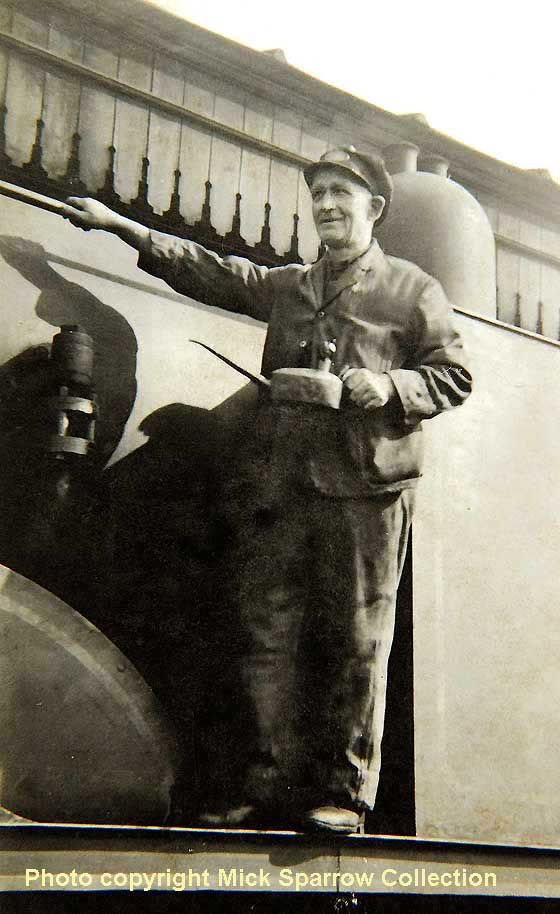

(Above-Below) Driver Jim Soal enjoys a joke in the cab a Type 3 Crompton as we wait to leave Basingstoke for Salisbury in early 1967. All Guildford Drivers had to learn the 1550hp diesel-electric class before our transfer to Woking when steam finished later that year. Jim used to let me do the driving on many occasions (on both steam and diesel) and I'm indebted to him and other drivers like him for passing on their skills to me. (Below) Guildford Driver Arthur Streatfield in the Driver's seat of 1600/600hp electro-diesel E6012 circa 1966. Arthur was a real Gent and a great engineman. The1600/600hp (JA & JB type) electro-diesel and 1550hp type 3 Crompton diesel electric locos were to be our main traction at Woking when we were to transfer there at the end of steam in July 1967.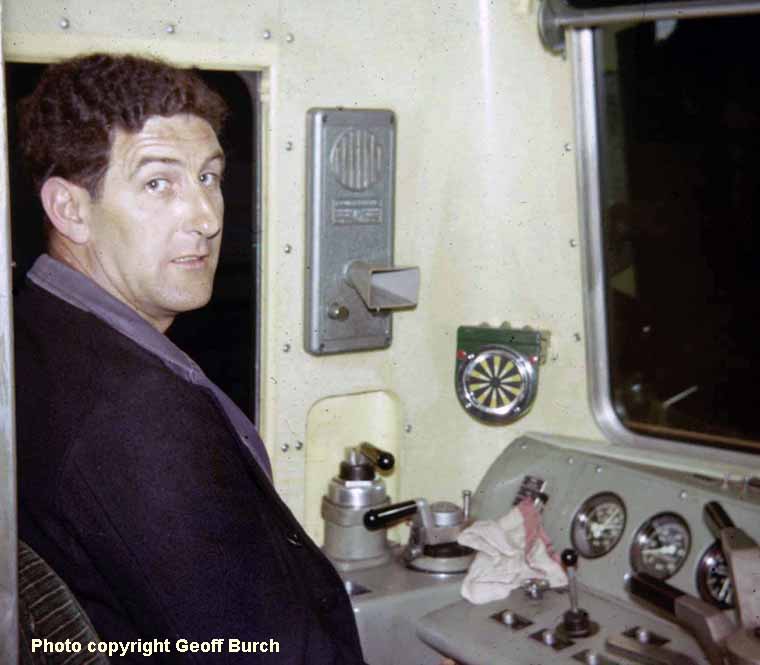
(Below) A selection of men that I worked with at Guildford MPD - mostly Drivers and firemen. All of the photographs are single frame shots from an 8mm cine-film shot by Driver Lew Wooldridge (fourth from right - top row). The film is edited by John McIvor of who has done such an amazing job of capturing each frame digitally.The film is now available from SVS Films The clips from the film helped me tremendously in creating profiles of the men that I've described in my book capturing them just as they were at the time. Sadly, nearly all of the men depicted are now residing in that great Locomotive Shed in the sky! Such a diverse bunch of men - all characters with their own tales to tell. I had such fun with some and it was an absolute treat to work with them. God bless them all! .
(Inserts-Below) This ingenious piece of apparatus was housed in a wooden cabinet below the exit signal at 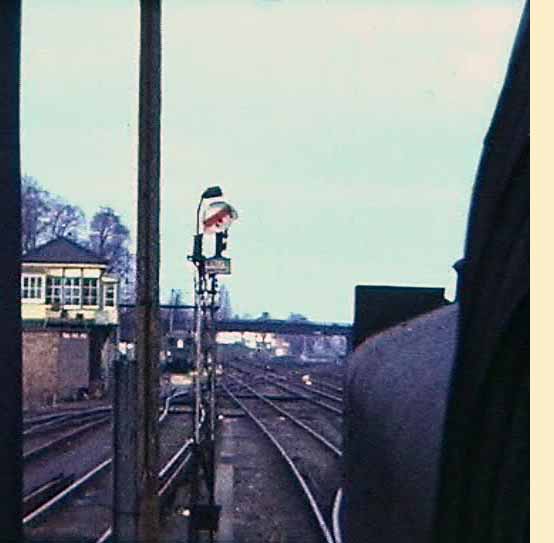 the North end of the departure road at Guildford Loco (below left). There were a number of various locations listed on the round enamel discs and after selecting a
the North end of the departure road at Guildford Loco (below left). There were a number of various locations listed on the round enamel discs and after selecting a  destination, the peg that the last person had used was released. The arrow hand would then tick round in a clockwise direction to the location peg that had been selected. The clockwork mechanism would then send an electronic signal to an identical train describer located on the panel in Guildford North Signalbox which, accompanied by an audible ring, would alert the Signalman of the appointed destination. (Inset right) Photo of Guildford based fireman Sid Ford using the train describer to inform the Signalman at Guildford North Box that the locomotive's destination is Woking Yard. In this case to work an empty stone train to Salisbury...Sid was on BR Standard Class 5 No 73022 with Driver Lew Woolridge on 25 September 1964.
destination, the peg that the last person had used was released. The arrow hand would then tick round in a clockwise direction to the location peg that had been selected. The clockwork mechanism would then send an electronic signal to an identical train describer located on the panel in Guildford North Signalbox which, accompanied by an audible ring, would alert the Signalman of the appointed destination. (Inset right) Photo of Guildford based fireman Sid Ford using the train describer to inform the Signalman at Guildford North Box that the locomotive's destination is Woking Yard. In this case to work an empty stone train to Salisbury...Sid was on BR Standard Class 5 No 73022 with Driver Lew Woolridge on 25 September 1964. 
MEMORIES OF GUILDFORD STATION - 1
Norman Hamshere Collection
(Above-Below) This somewhat sinister scene at a misty Guildford station could be a 'still' from a horror film! With the tall chimneys of Guildford Park Brick Works dominating the background, a well-dressed gentleman poses for a photograph on Platform 8; it's almost as if he has set the camera on a tripod to take a self portrait, or perhaps a friend took it? Whatever the reason, when viewing old photographs you are invariably drawn in by the detail in background, and in this case the curious contraption on the platform is interesting; it is a mobile water bowser used for replenishing train carriage toilets, and at the end of the platform semaphore signalling is still in operation. Also of interest are the two six-wheeled coaches berthed in the Up Yard reception road. They were probably used for push-pull operation, whereas David suspects the nearest vehicle might be an Inspection Saloon…my thanks to Mike Morant and Chris Knowles-Thomas for properly identifying them. The nearest one is a double-ended brake van built 1894-1903 LBSCR diagram 77/228 - and as built, would have had a side lookout (ducket) at each end, these being removed in 1927. The right hand one is LBSCR diagram 76/227 SR diagram 901, built 1891-1906. This was probably the most numerous LBSCR 6 wheel brake van, their SR numbers being 7xx and 8xx. In this case the ducket would have been in the centre on this side of the open Guard's door. Again, these duckets were removed after 1927. Ten diagram 901 vans were through piped between 1923 and 1930 so they could operate in pull-push trains and it is possible that the diagram 901 van in the photo is one of these. However, as it's not possible to see whether it has extra hose connections each end, one can't be sure. But they did, inter alia, work between Guildford-Horsham-Brighton. The PP fitted vans were withdrawn between 1936 and 1940 and in general all the LBSCR 6 wheel vans went by about 1940. (Below) This interesting photograph of the station is not very clear but then it was taken circa 1937-38 and shows the newly extended platforms towards the Farnham Road Bridge. New Water columns have been erected on platform 4 and platform 5 and a number of SR 'Roundel' Guildford signs have been attached on the new lamp standards. Guildford Gas Works can be seen in the background. 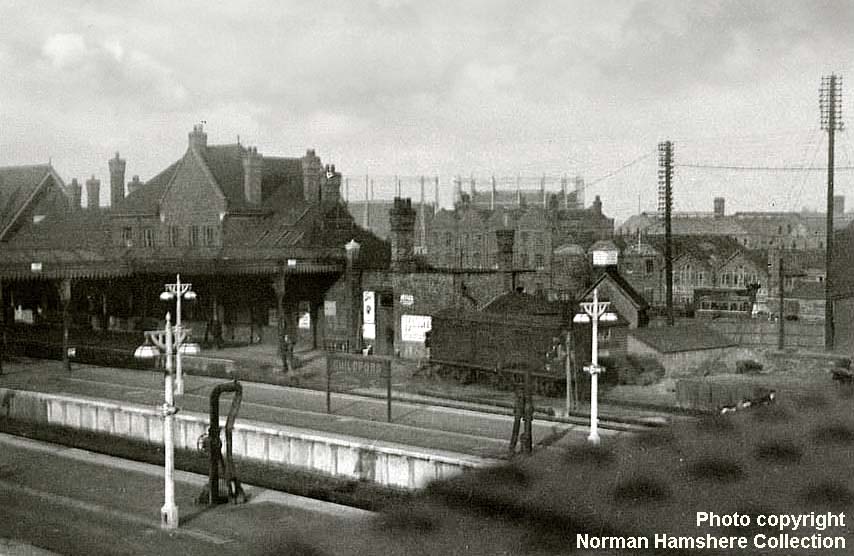

(Above-Below) An interesting view from platform 3 (Down Cobham line) of the motive power depot. The platforms haven't as yet been extended towards Farnham Road Bridge and a short slip-road and stop block exist from the down Portsmouth line. The lower quadrant semaphore signal on the end of platform 4 is the Down starting signal and the signal below it (S) if lowered, would allow a Driver to pass the starting signal at Danger for 'Shunt' purposes only. The white horizontal diamond sign on the signal post denotes to the Driver that he was exempt from carrying out the rule 'detention of trains on running lines' unless he was detained for an unusually long time - for example 10 minutes. This rule would be termed 'Rule 55' in the 1950 Rule Book that I was given on joining the railway in 1961. Another interesting point is that there are no conductor rails to be seen - thus dating this photograph to pre-1937. (Below) Taken from under Farnham Road Bridge, this photograph shows the stores office and stores building. The second floor offices were built above this for the Shedmaster and his office staff at a later date. The buildings towards the rear of the photograph were used by the Running Foreman and non-clerical timekeeper and what was called 'The Ambulance Room'. The Driver's cabin, toilet block (and the canteen above the steps leading to the Farnham Road have also yet to be built). Click here to see a detailed map of Guildford Shed….a full description of the map appears at the beginning of the next page.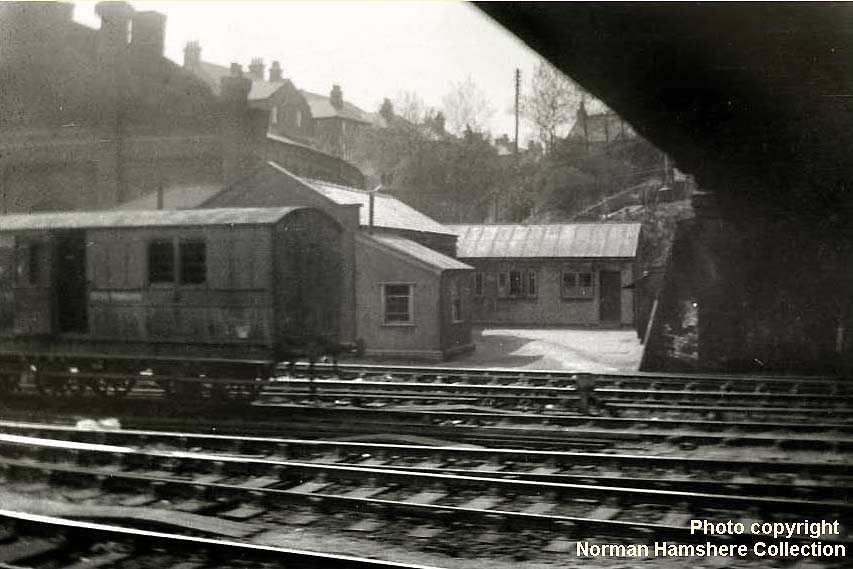

(Above-Below) A Horsham to Guildford Push-Pull unit has just arrived on platform 3 with an ex-LSCBR Stroudley D1 Class 0-4-2 No 231 Horsham at the rear. The locomotive must have been amazingly stable for the lamps to remain on top of the side tank when in motion, or perhaps they were held there on brackets? The Guildford-Horsham line was principally worked by this class and several were named after the stations on the route: No 231 Horsham; No. 268 Baynards; No 274 Guildford; No 275 Cranleigh; No 276 Rudgwick and No 277 Slinfold. Two Stroudley A1 Class 0-6-0 'Terriers' were also named after stations along the route: No 36 Bramley and No 77 Wonersh. (Below) Timber is awaiting collection in the station approach and a string of wagons extend into what is now the station car park. The Billing & Son Printing Works building is in the background, now converted into high quality offices, known as 'The Billings'.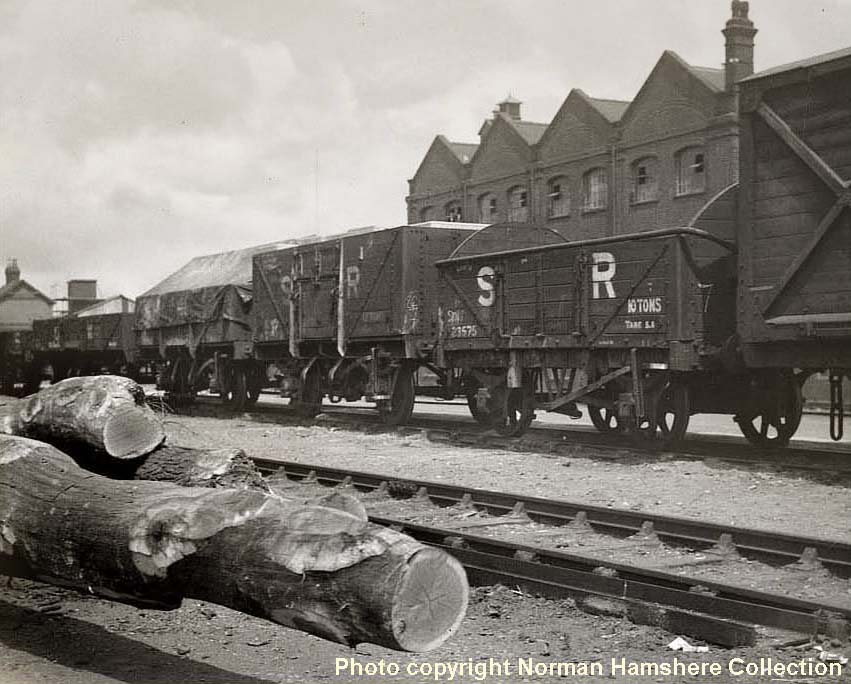
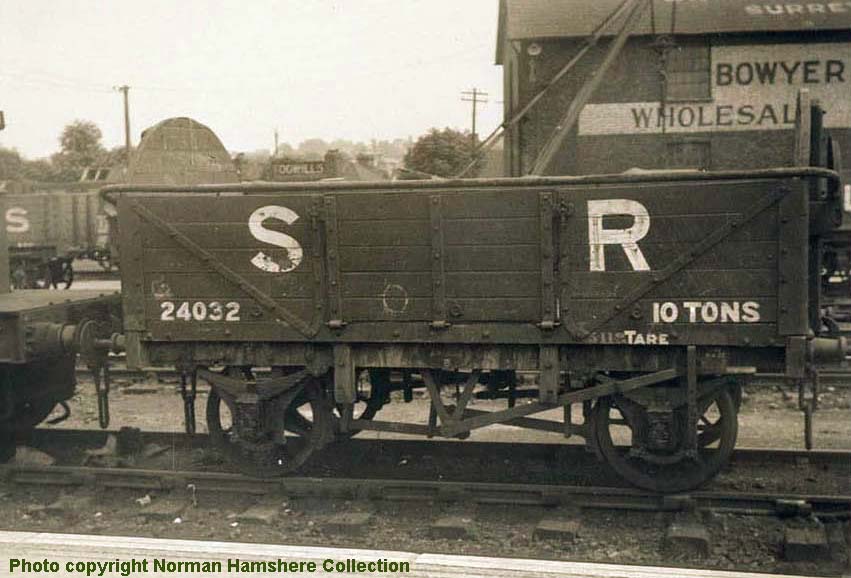
(Above-Below) A ten-ton open wagon stands next to a brake van in the Down Yard. The pipe running around the outside of the wagon was used to connect the vacuum pipes throughout the train - this wagon however, had no vacuum brake cylinders and was classed as a 'Blow Through'. (Below) A six wheeled LBSCR Perishable-Luggage Van is berthed on the block of the Dock outside the Lamp room. Oddly, one of the bogies has solid wheels whereas the two others are of the spoked variety. Once again, my thanks to Mike Morant and Chris Knowles-Thomas - 'Presumably original as the Brighton did use spoked wheels on some of their coaching stock. The 'Milk' van 270 on the Bluebell Railway is the same type and has a full set of spoked wheels; as such it seems to be SR diagram 975 built in 1908. The Brighton had a number of similar types of luggage van and this was the most numerous...' This photo (like the one from Farnham Road Bridge of the same scene) was taken after the conductor rails had been placed post 1937. 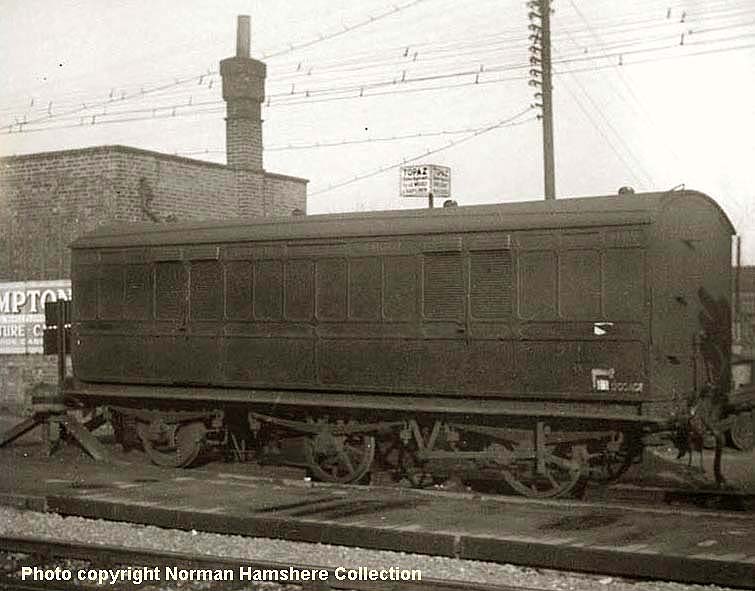

(Above) A horse and cart belonging to Chaplins Ltd stands patiently outside the Goods Shed at Guildford station. An advertisement for AG Papers is posted on the side - one of the many cigarette papers available for the 'roll your own' smokers at the time. A 'Reserved For Vehicles' sign is posted on the notice board, though the rest of the wording is unclear…let's not forget these photos were taken 70-odd years ago!
MORE BRIEF MOMENTS IN TIME - GUILDFORD - JUNE 19 and 20th 1961
The Richard S Greenwood MBE Collection - 3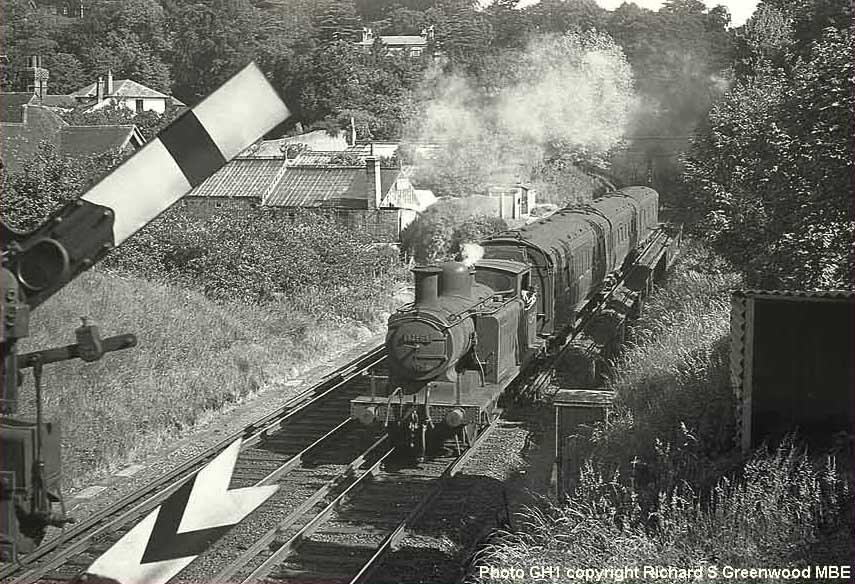
(Above-Below) A superb view from Ferry Lane Bridge through the Upper quadrant semaphore signals as E4 Class 32564 works the 9.22am Guildford to Horsham service. The train is about to enter St Catherine's sand tunnel and the distant signal for Shalford Junction in the clear position meant that the section ahead was clear as far as Peasmarsh Junction. Note the fireman has forgotten to place the disc boards on the front of the locomotive (one on the right buffer and one in the middle of the buffer beam). (Below) Guildford based (70C) M7 Class 30246 departs from platform 2 with the 6.04pm Horsham service on 19th June 1961. This Guildford turn of duty would involve booking on and preparing the locomotive, collecting the coaching stock from the South Box Sidings, working the train to Horsham stopping all stations, running round the train and then working back to Guildford stopping all stations. The train would then be berthed and the locomotive taken to the depot for disposal.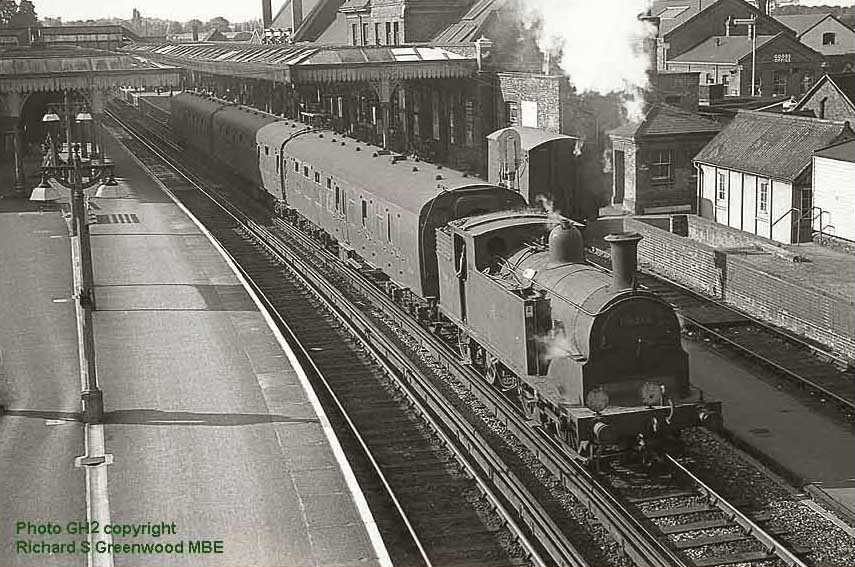
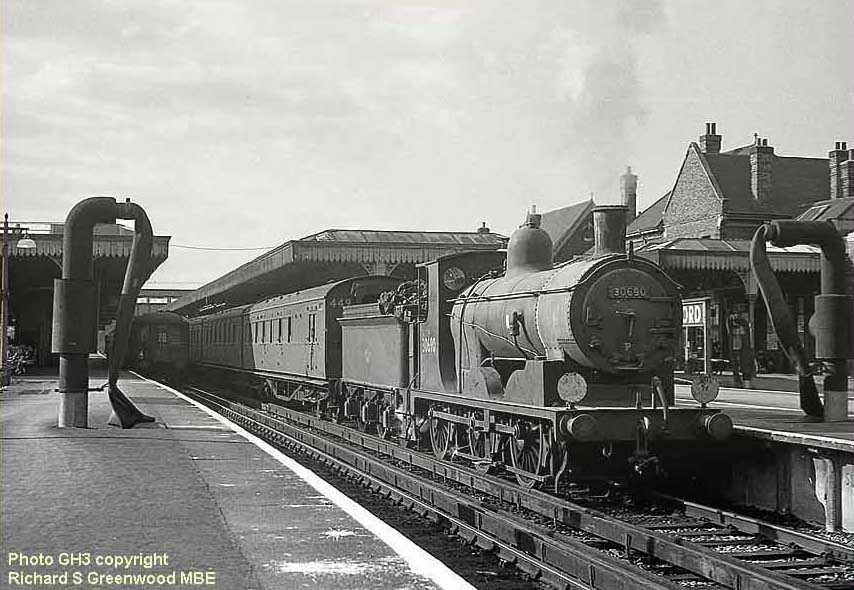
(Above-Below) An unusual sight as this service would normally be worked by an N or U Class, 700 Class 30690 is about to leave with the 6.16pm passenger service to Dorking from platform 4 on 19th June 1961. Another anomaly is the Ascot train standing next to it on platform 5 as this service would normally depart from platform 8. The stencil headcode (28) has already been place in position for the train's departure from Aldershot to Ascot where the Driver would change ends and the tail lamp would be moved to the other end of the train. (Below) In all the time I worked at Guildford Loco the BR Standard Class 2MT tanks working at Guildford is something I have never noticed before - I must have been on holiday this particular week! I think Richard has captured a truly unique photograph of 84025 entering Guildford station's platform 2 with the empty coaching stock to form the 7.34pm Horsham service. The wooden building between platform 1 and 2 was the Station Master's office, the original one being destroyed in September 1953 when an electric train over-ran the buffers of number 1 platform (down bay). Two passengers and five members of the railway staff were injured, including the Station Master and the relief Assistant Station Master. The Assistant Station Master succumbed to his injuries and died the following day. 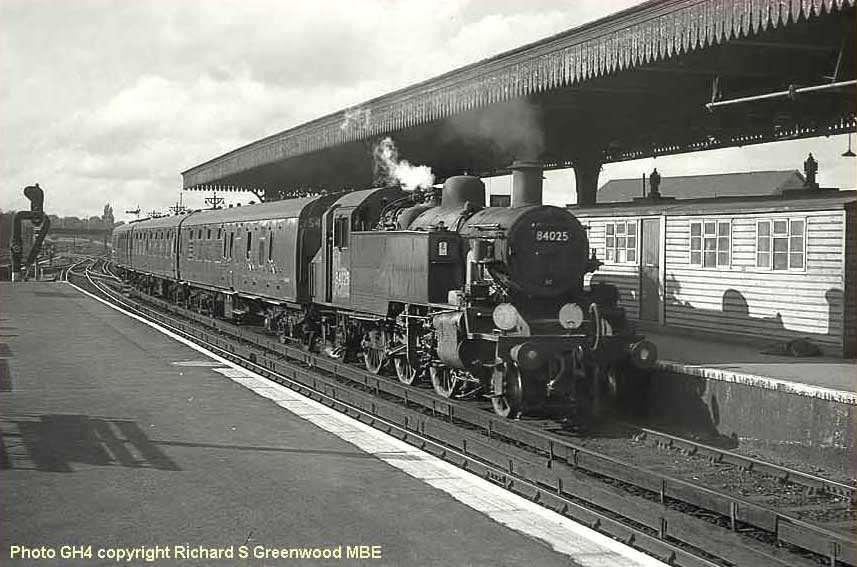

(Above-Below) Viewed from the 'Monkey Bridge' at Worplesdon o 20th June 1961, 700 Class 30697 with Guildford Driver Ernie Riggs at the controls, hauls a mixed loose coupled freight from Woking destined for Guildford Yard. Ernie was one of the Drivers in the 'Old Man's Gang' whose prerogative was that they were spared working the night shifts. Ernie retired the following year after 47 years loyal service. (Below) Viewed in the other direction from the 'Monkey Bridge', a mixed freight hauled by L1 Class 31768 has a unusual companion next to its tender - a 350hp diesel-electric shunter. The locomotive would have had its gearing de-meshed for it to run in tandem in the train as it's normal maximum speed was 20mph. Brittens Pond lays just beyond the row of trees in the background and when I became a fireman, I'd throw a few pieces of coal off down the embankment as we went by to fuel a brazier for my brother and I when we went night fishing for carp. 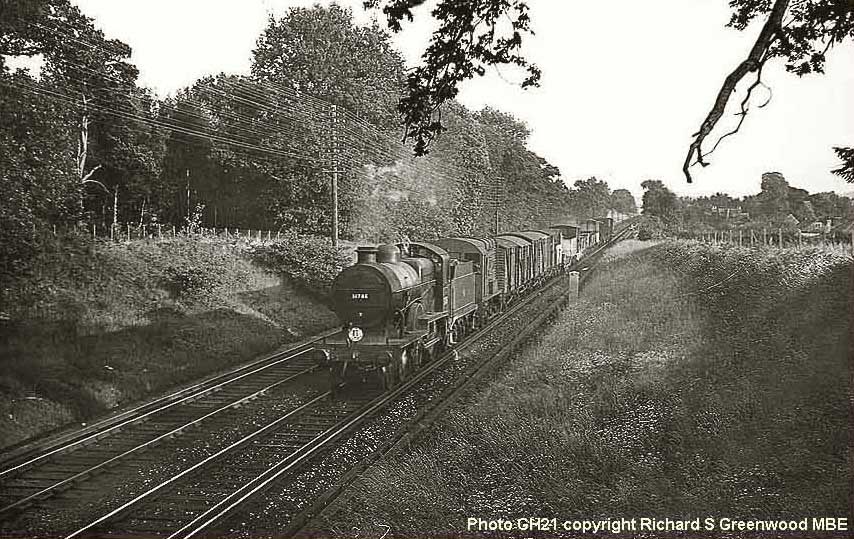
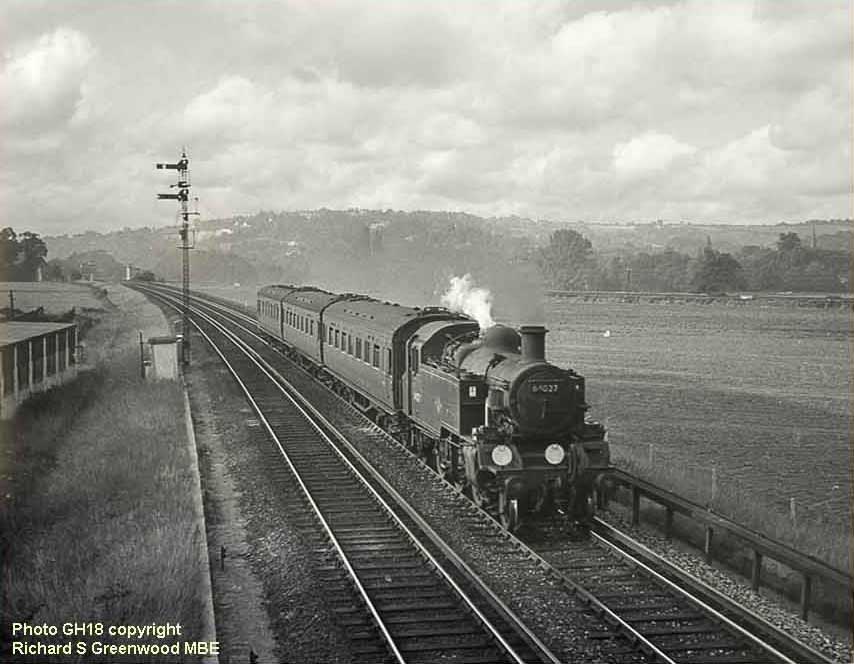
(Above-Below) Yet another BR Standard Class 2MT tank - this time 84027 on the 8.34pm Guildford to Horsham on 20th June 1961. The number of Richard's photos of this class leads me to believe that the Southern Region was conducting a trial on the 2MTs capabilities over the Guildford - Horsham branch. Richard took the photograph from a footbridge that spanned the track between Shalford Junction and Peasmarsh Junction. The curve of track in the background is the line to Redhill. Shalford Church spire can be seen to the right of the photograph with the downs that lead to St Martha's Church in the distance. Richard noted in his diary that the BR Standard Class 2MTs (formerly based in Kent) had migrated westwards, some of them to Brighton but they didn't stay there long. (Below) A 12-Car Portsmouth Express headed by 4COR 3112 passes Peasmarsh Junction signalbox with a Waterloo-Portsmouth Semi-fast service on 20th June 1961. Nicknamed 'Nelsons' because of only having one cab window (the other being taken up by being the route indicator), these units served the Portsmouth direct line well. They also had a buffet car (4-BUF) usually placed in the middle of the train formation and were gangwayed throughout. Traction equipment was in the form of 2x250hp English Electric traction motors per 4-car Unit. 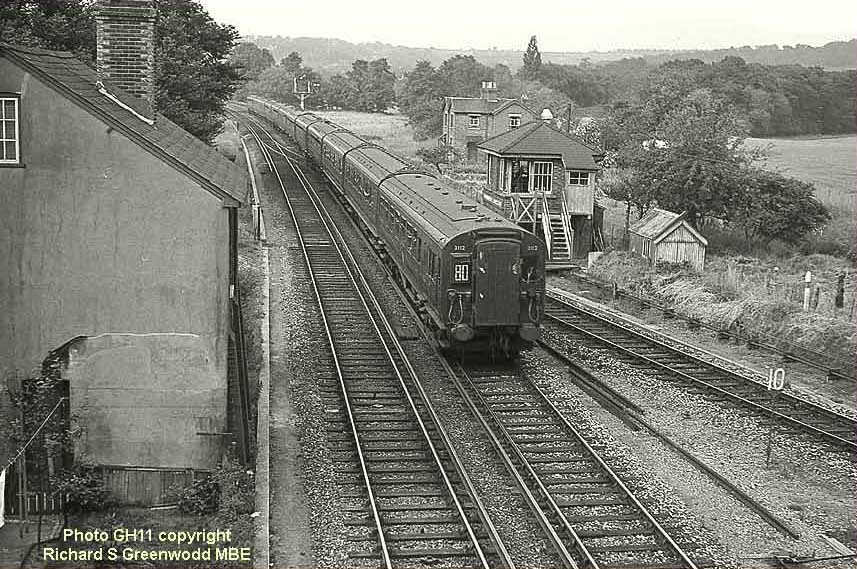
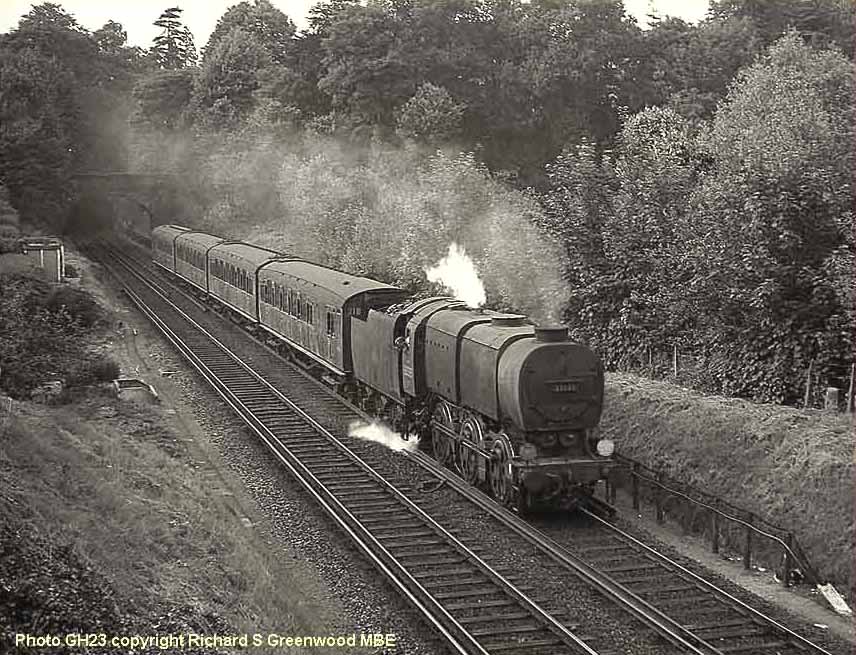
(Above) Q1 Class 33035 has her status upgraded to passenger service as she works the 6.16pm Guildford to Dorking passenger at Ferry Lane. Q1 Class locomotives were also often used on the Horsham services if tank engines weren't available as the N and U class locomotives were restricted from this line as they were unable to clear Baynards tunnel. The fireman is working the injector to keep the engine quiet before entering St Catherine's tunnel.
MEMORIES OF GUILDFORD STATION - 2
Photographs by Leigh Darnton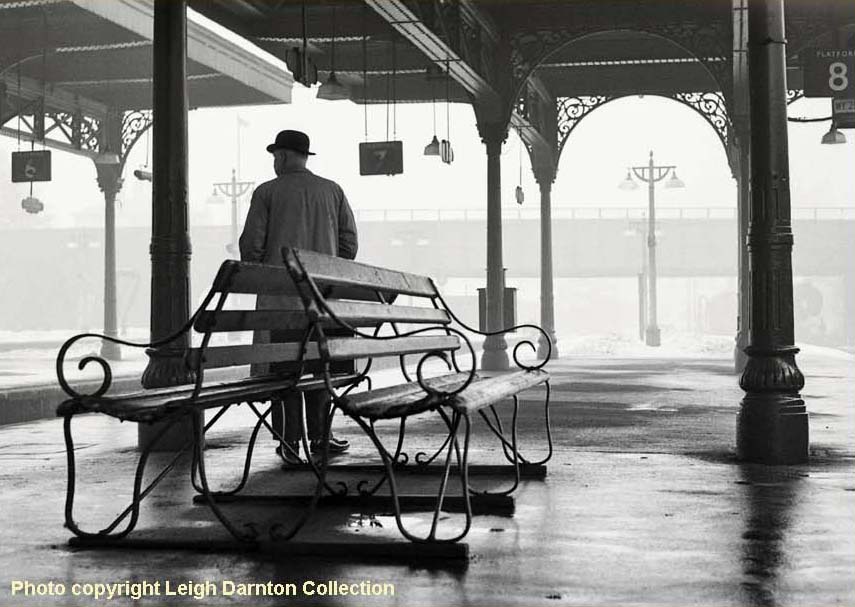
(Above-Below) A commuter awaits his train to take him to a business meeting in London on a winter's morning in 1961. Guildford's Motive Power Depot can just be seen through the morning mist. (Below) An advert to 'Go by Train' to Brighton & Hove is probably more appealing than the newspaper being read by a bowler hatted gentleman sitting in the waiting room.
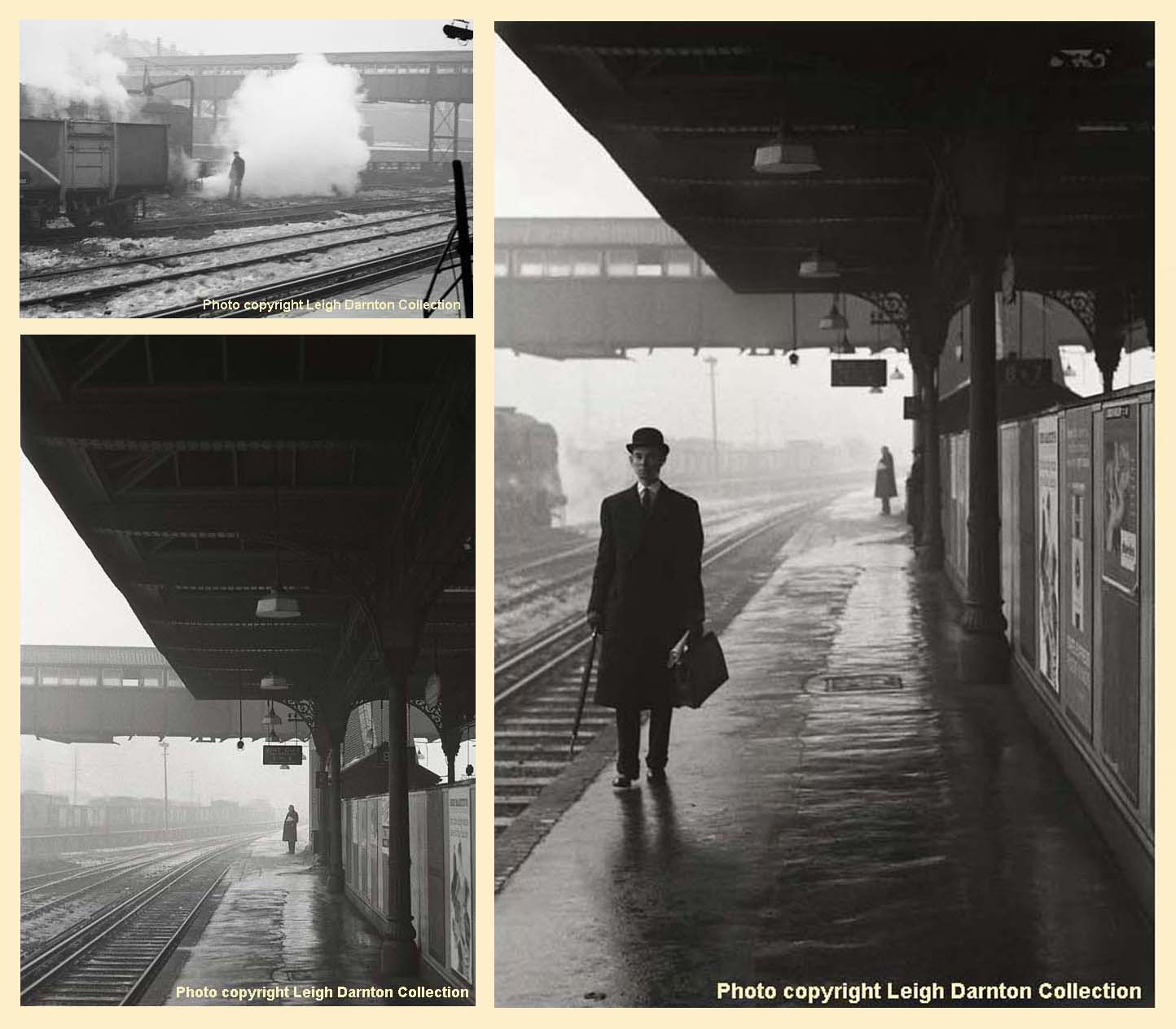
(Above-Below) An unidentified Bulleid Light Pacific's cylinder cocks blow steam as she moves down the Back Road at Guildford coal stage as one of the shed staff stands waiting for the move to finish. Meanwhile a couple of bowler hatted commuters (destined to the Foreign Office I expect) arrive on the platform, while another commuter with briefcase and newspaper (The Times I expect) tucked neatly under his arm waits patiently for his train to arrive...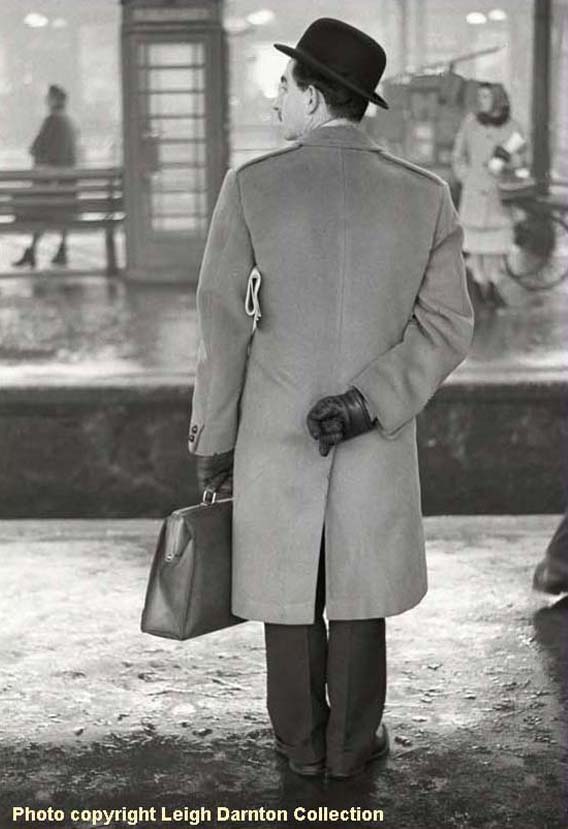
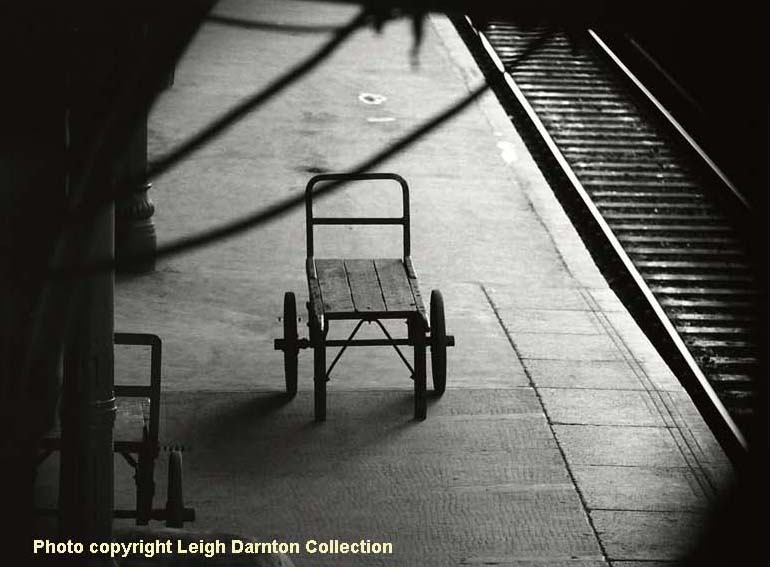
(Above-Below) A porter's barrow sets a poignant scene of days gone by on the station platform. (Below) A fine shot of the 10.53am stopping service leaving from up the gulley - platforms 6 and 7. The train consists of 2x2HAL Units, the leading unit being No 2644. The headcode stencil 7 denotes the train is a stopping service to London Waterloo via Woking and will call at Worplesdon, Woking, West Byfleet, West Weybridge, Weybridge, Walton, Hersham, Esher, Surbiton and Waterloo. 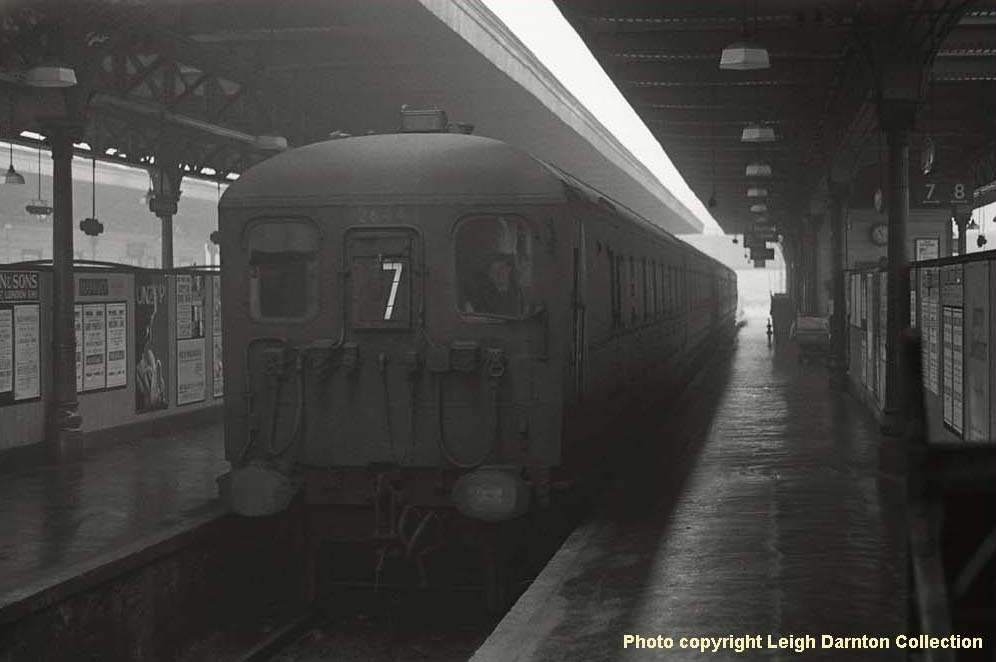

(Above) 'All change please - all change!' The station announcer's voice will be reverberating around the station as the Ascot to Guildford train comes to rest on platform 8 and passengers alight. A snowbound scene is reflected in the cab window which also shows the colour light starting signal and water column at the London end of the platform. (Below) The commuter is still waiting...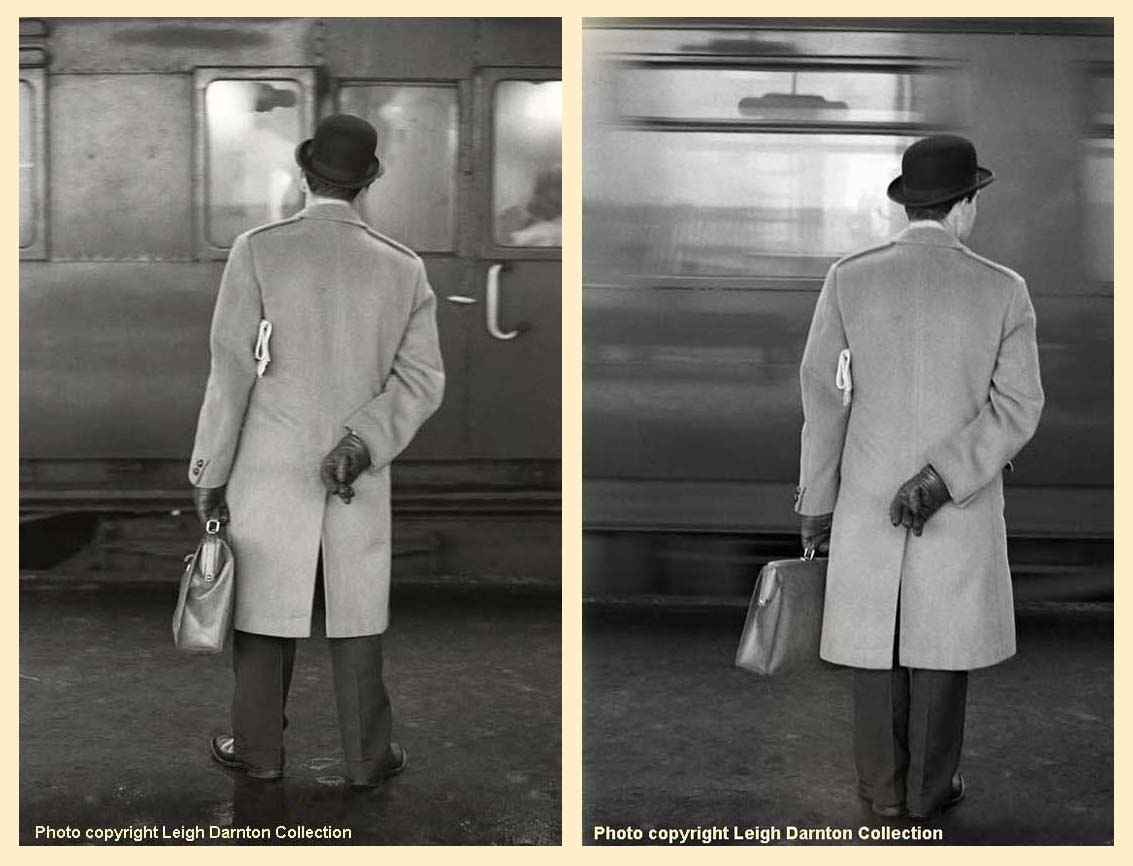
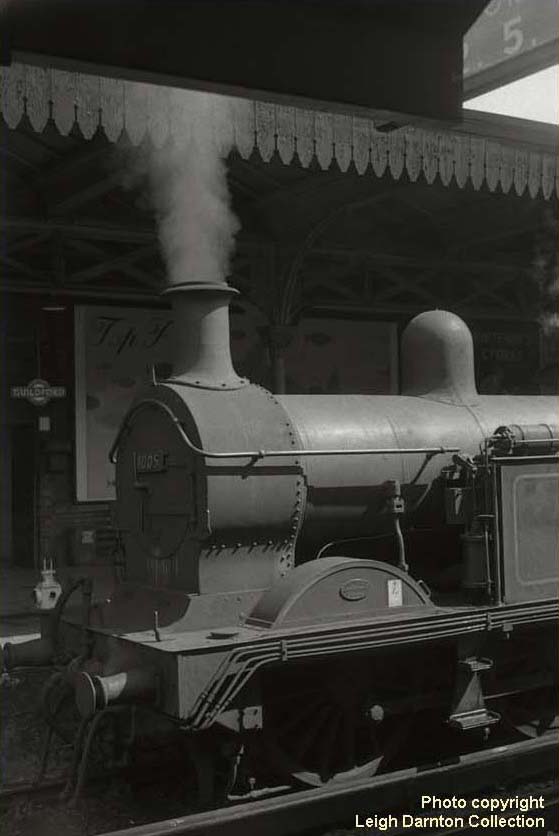
(Above) The final Leigh Darnton shot shows Wainwright designed (SECR) H Class 0-4-4T 31005 waiting for the signal at the end of platform 2 at Guildford to run light-engine into the chalk tunnel and then to the loco, circa 1958. Built at Ashford Works in 1907 her last shed was Three Bridges before withdrawal in 1964.
MEMORIES OF GUILDFORD STATION - 3
David Rose
Local historian David Rose has written several books on Guildford and its surrounding villages. He is also a main contributor to an on-line newspaper called 'The Guildford Dragon News' here. In addition to reporting everyday news stories and features, David also edits the newspaper's local history column called 'Through Time'. David writes...
'I am an avid collector of old artifacts relating to Guildford and my archive of vintage photos is a major part of the collection. Guildford's railway history has, of course, featured several times in my books and since 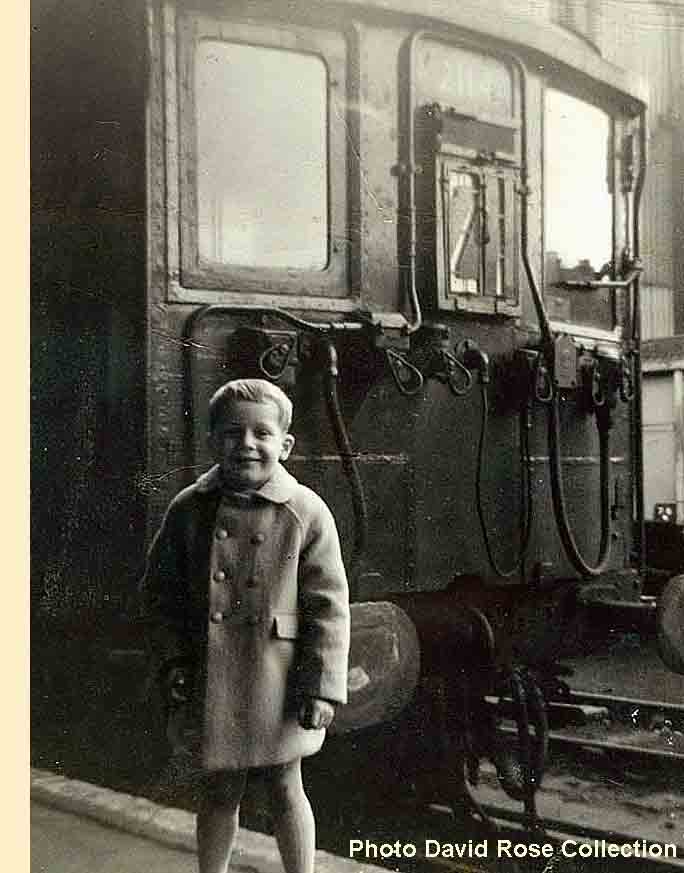 Geoff and I share a common interest in railways, sooner or later we were bound to meet up.
Geoff and I share a common interest in railways, sooner or later we were bound to meet up.
Having helped Geoff source one or two pictures for his webpage I am pleased to add a few memories of my own. Born in Guildford at the end of 1959, I was lucky that during my formative years my dad (knowing that BR steam was coming to an end) introduced me to those engines that were soon to disappear. I must have been about four years old when he first took me on regular trips to Guildford station to see 'the steamers' as he called them. I remember visiting the station in 1965 when the last train ran on the Horsham line and we made frequent trips to Woking to see the Bulleid Pacifics right up to 1967.
A popular spot to watch trains was Yorkie's Bridge spanning the lines just to the north of Guildford station, and I have vivid memories of Friday evenings during the summer when a very long goods train came through. From memory, an 'N' or 'U' hauled it. I also witnessed the former GWR 'Manors' and 'Grange' classes on the Reading-Redhill passenger trains. The bridge gave you a good view of the various activities in the goods yard, including wagons being loaded with scrap metal and the Acedes single-seater light-blue coloured 'invalid' cars lined up waiting to be loaded onto flat-bed wagons. Why they were here in Guildford I am not sure. I looked them up on the Internet and found out they were made in Essex. Perhaps they had been delivered to Guildford?
My dad knew various people who worked on the railways and I recall the day he managed to wangle a visit  to the loco shed. I guess that was in about 1966. Another visit he blagged was to the then new signal box. But the best treat of all was the time we were returning home from a visit to Woking and he had pre-arranged with a driver he knew to meet us there. We then had a ride in the cab of a 'Nelson' back Guildford. Very exciting indeed! I was about seven years old.
to the loco shed. I guess that was in about 1966. Another visit he blagged was to the then new signal box. But the best treat of all was the time we were returning home from a visit to Woking and he had pre-arranged with a driver he knew to meet us there. We then had a ride in the cab of a 'Nelson' back Guildford. Very exciting indeed! I was about seven years old.
Talking of 'electrics', I remember seeing the first of the newly painted blue stock passing through. There was another train spotter on Yorkie's Bridge who said - 'Seems like British Rail have bought a hell of a lot of blue paint from somewhere!'
So here are just a few railway pictures from my collection, which Geoff has kindly added the technical information. My thanks to Tim Winter, Vera Wilkinson, Pat Lavery and Malcolm Fincham who hold some of the originals; the rest are from my own collection...'
(Above Right) David Rose (aged four) is standing on platform 8 in front of 2BIL No 2114 which will form an Ascot service. The Headcode (21) is to Aldershot where the Driver will change ends and then work to Ascot with headcode (28). (Above Left) David with his Dad, Arthur Rose on platform 5 at Guildford station. The three-aspect colour light signal (WX82) is unusual as it's not placed at the end of the platform as were the others. The white diamond sign affixed to the signal post meant that the signal was track circuited and Rule 55 (Detention of Trains on a Running Line) was exempt unless detained at the signal for an unusually long time (ten minutes). Note the number of two-wheeled hand-barrows on platform.
(Below) A lovely picture postcard scene of Guildford Station circa 1910 showing horse drawn carriages and one of the first motor cars of the era. The bicycle propped against the tree probably belongs to the photographer.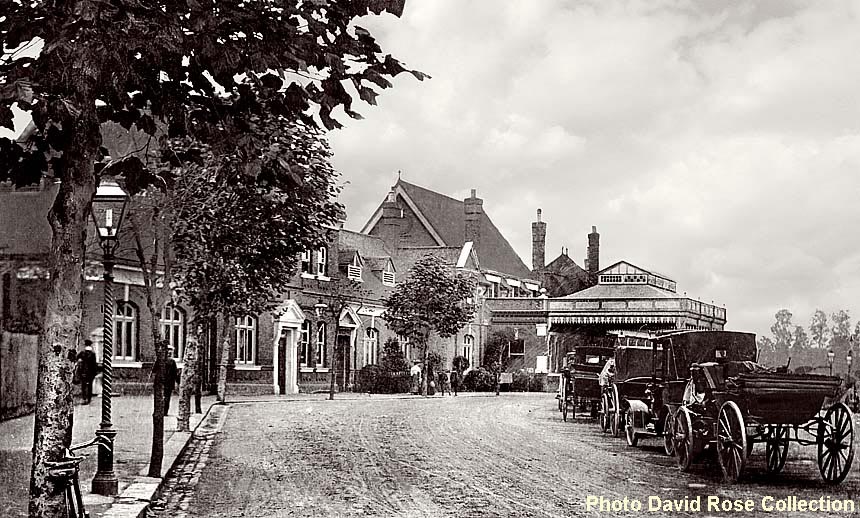
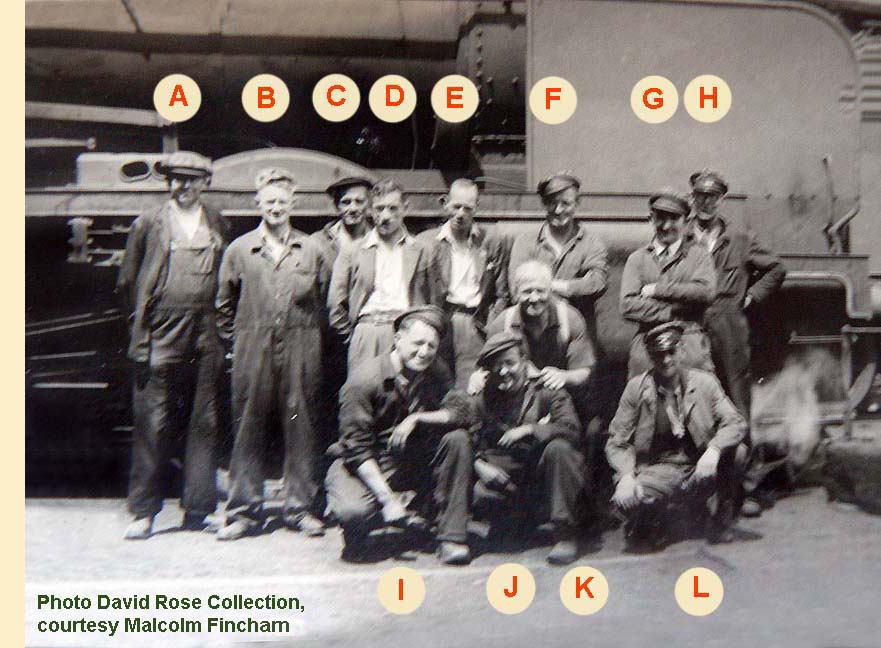 (Right) This photo of Guildford Fitters and Fitter's mates posing in front of a locomotive backdrop circa 1950-1955 is reproduced courtesy of Malcolm Fincham whose Grandfather Ambrose Smith, is amongst the men shown. I recognise one of the men, Ernie Pitman (H) on the extreme right back row, but I am appealing for help to identify the rest…if you know anyone in this photo I'd be pleased to hear from you. My email address is at the bottom of the page.
(Right) This photo of Guildford Fitters and Fitter's mates posing in front of a locomotive backdrop circa 1950-1955 is reproduced courtesy of Malcolm Fincham whose Grandfather Ambrose Smith, is amongst the men shown. I recognise one of the men, Ernie Pitman (H) on the extreme right back row, but I am appealing for help to identify the rest…if you know anyone in this photo I'd be pleased to hear from you. My email address is at the bottom of the page.
Dear Geoff, my name is Ken Ford, grandson of Ernie Pittman and son of Betty Pittman daughter of Ernie. I have been looking at the photograph of the fitters and mates, and my mum instantly recognised her father, Ernie. My mum worked in the Guildford mobile staff canteen situated at the end of platform 2, which was then an old railway carriage from 1949 to 1955. She recognises six faces in the picture but unfortunately cannot remember the names. The only names she can remember from those days (but they're not in the photo) are the surnames of Day, Night, Blackman and the nickname of Jycko. Ernie passed away in 1978 but mum is still very well at 79. Regards, Ken Ford.
(Below) On the evening of 19 August 1976, while the 17.54 electric passenger train from Waterloo to Portsmouth Harbour was crossing from the Down Main line to No. 2 Platform line at Guildford Station, an empty coaching stock train, which had previously formed the 17.34 electric passenger train from Waterloo to Guildford, was set back on a bell signal from the guard, from No. 4 Platform line in the London direction past a signal at Danger and collided side-on with the rear of the passenger train. The last two coaches of the passenger train and the leading coach of the empty train were derailed. One passenger, unfortunately, received severe spinal injuries but has now recovered and seven suffered minor injuries, six being treated in hospital and then released.
The collision occurred because of a lack of co-ordination between the Driver and Guard on what was a routine and simple shunting movement. Responsibility must rest with the Driver for failing to come to an understanding with the guard over how the movement was to he made and where the guard was to be positioned, for failing to repeat the buzzer signal which he had received and for failing to observe the aspect of position-light shunting Signal WX82 before moving his train. Guard Callaway must also take part of the blame for failing to come to an understanding with his driver as to how the movement was to be carried out, failing to get an acknowledgement to his buzzer signal and, when the movement had started without authority, for failing to take action to stop the train which, had he done so, would almost certainly have avoided the collision.
(Left) About 20 minutes to midnight on March 29, 1895, a train of empty carriages travelling from Petersfield to Guildford at about 30mph hit a bank of sand, bricks and other debris inside the 'sand' tunnel at St Catherine's, south of Guildford. The first two carriages, being mainly constructed of wood, were smashed 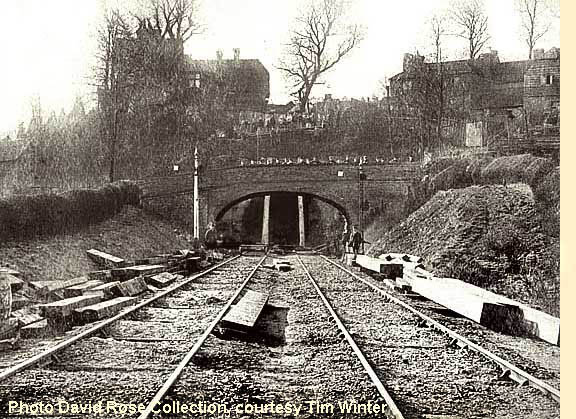 to pieces by the force of the impact. The driver and fireman were uninjured. The driver later told the Surrey Times newspaper: 'We ran into something and came to a sudden stop. We could hear the coaches smash up and my mate got off one side of the engine and I the other and went to the (guards) van, where we found the guard badly cut about. My mate went off and told the signalman, whilst I returned to the engine and put the fire out with wet ballast. The gas (used for lighting) from the coaches was escaping, so I got out of the tunnel as quickly as I could...'
to pieces by the force of the impact. The driver and fireman were uninjured. The driver later told the Surrey Times newspaper: 'We ran into something and came to a sudden stop. We could hear the coaches smash up and my mate got off one side of the engine and I the other and went to the (guards) van, where we found the guard badly cut about. My mate went off and told the signalman, whilst I returned to the engine and put the fire out with wet ballast. The gas (used for lighting) from the coaches was escaping, so I got out of the tunnel as quickly as I could...'
About an hour after the initial landslide another occurred which completely buried the engine. On the hill above a big hole had formed. Two horses perished as the land subsided and four carriages had fallen into the large hole of the tunnel below. A summerhouse also fell into the hole. While work began to dig out the fallen sand and debris a wooden platform was erected at the Peasmarsh end of the tunnel where trains from Portsmouth and Horsham had to terminate. Trains from Redhill were allowed as far as Shalford. At both places horse-drawn buses took passengers on as far as Guildford station. They returned with passengers who had alighted at Guildford, but who were travelling south or east. The cause of the collapse was initially thought to be due to a burst water main at a house above the tunnel. In fact, the burst had only occurred when the subsidence happened and the conclusion later reached was that the timbers used in the tunnel's construction had rotted resulting in an uneven stress being placed on its brick lining.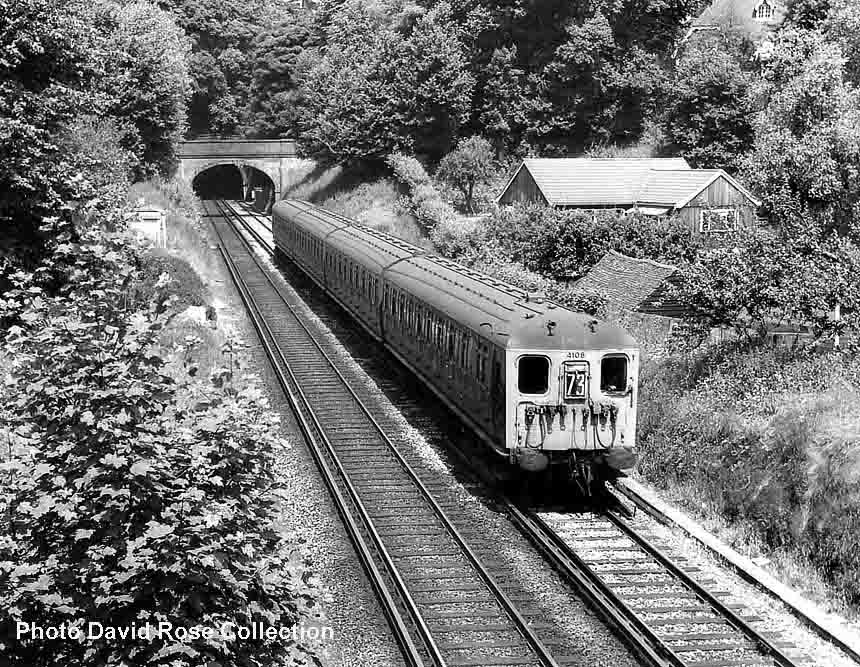
(Above) Viewed from Ferry Lane Bridge, a 4-car SUB No 4106 heads towards Farncombe with a stopping service to Portsmouth & Southsea. This type of unit first appeared in 1941 and was first put into service on the Victoria to Orpington line. Two motor brake second compartments sandwiched two trailer second compartment coaches, one of which had been designed as a composite. They were built with steel underframes and body panels, timber frames supporting the body panels and with canvass roofs. This generation of 4 Subs had domed cab fronts and in that respect were similar to the 2-Car HALS. Woe betide any second-class passenger wanting to use the toilet on this long journey as this type of stock didn't possess one! It also didn't have any first-class accommodation. 
(Above-Below) The Guildford-Horsham line was principally worked by Stroudley's ex-LSCBR D1 Class 0-4-2Ts and several were named after the stations on the route: No 231 Horsham; No. 268 Baynards; No 274 Guildford; No 275 Cranleigh; No 276 Rudgwick and No 277 Slinfold. Built at Brighton in December 1879 and later renumbered 2274, here is No 274 'Guildford' in her original form. She was withdrawn from service in 1950. A photo of sister engine No 231 'Horsham' is featured earlier in the Norman Hamshere Collection. (Below) V Class 'Schools' 30909 'St Paul's' - one of three 'Schools' class locomotives stabled at Guildford when I joined BR as an engine cleaner in 1961. In fact, it was the first locomotive that I helped to clean on my first day at work! Unfortunately, all three were withdrawn by the end of 1962 but at least I was fortunate to work on 'our' three (and others of this class) during my first year as an apprentice fireman. 
BR STEAM DAYS ON THE NORTH DOWNS LINE
Colour photographs from the Alfred James Temple Collection.
Shalford Jn - Shalford - Chilworth - Gomshall - Deepdene - Betchworth - Reigate - Redhill
The North Downs are a ridge of chalk hills that stretch from Farnham and Guildford in Surrey to the coastal white cliffs between Folkestone and Deal in the east. This ridge of hills are prefixed 'north' to distinguish them from a similar range of hills running roughly parallel to them but some 31 miles to the south. There are two distinct aspects of the North Downs, the gentle north facing slope and the steep south facing escarpment which gives way to the flat, broad clay land known as the Vale of Holmesdale. 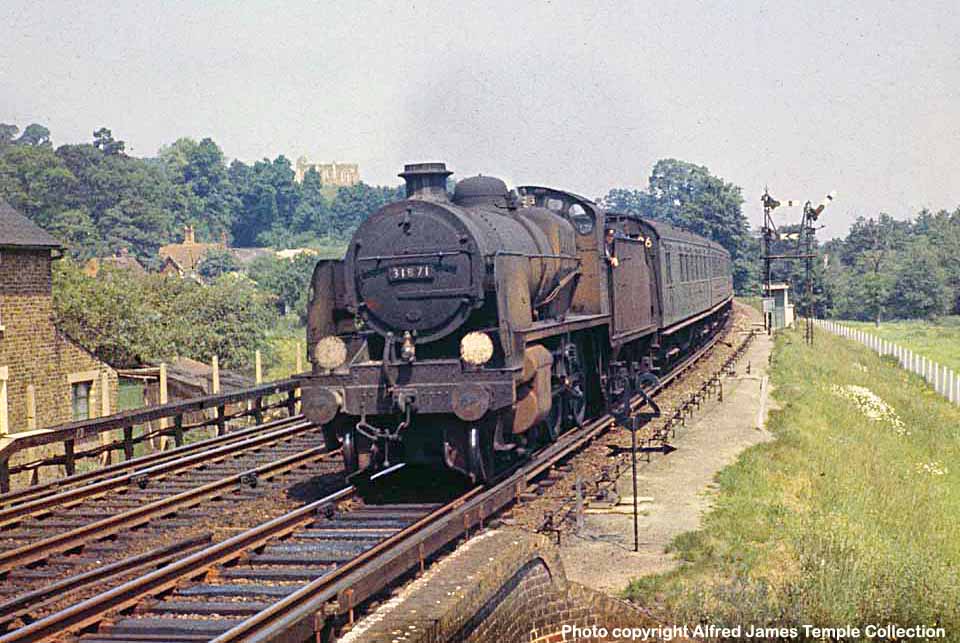
(Above-Below) The Driver of N Class 31871 has reduced speed to obey the 20mph permanent speed restriction as the train leaves the Guildford - Portsmouth Direct at Shalford Junction with a Reading to Redhill stopping passenger service. (Below) Class S15 30835 makes heavy work of a freight on the climb to Shalford Junction; note the ruins of the 13th Century St Catherine's Chapel can be seen above the trees in both photos. 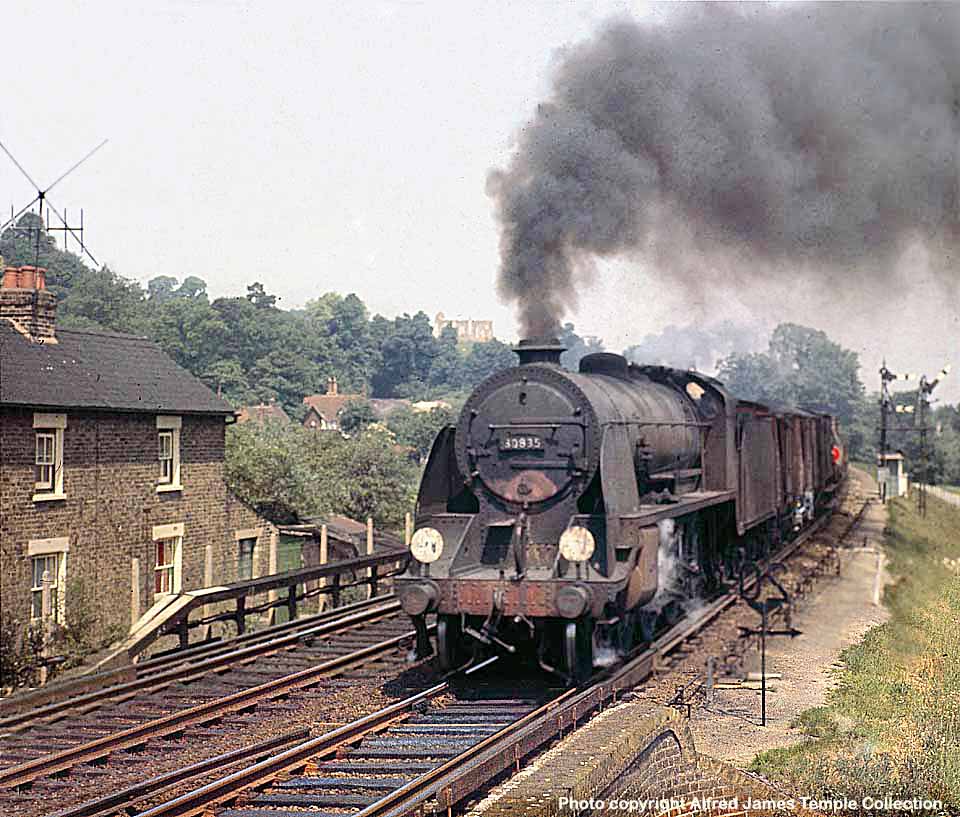
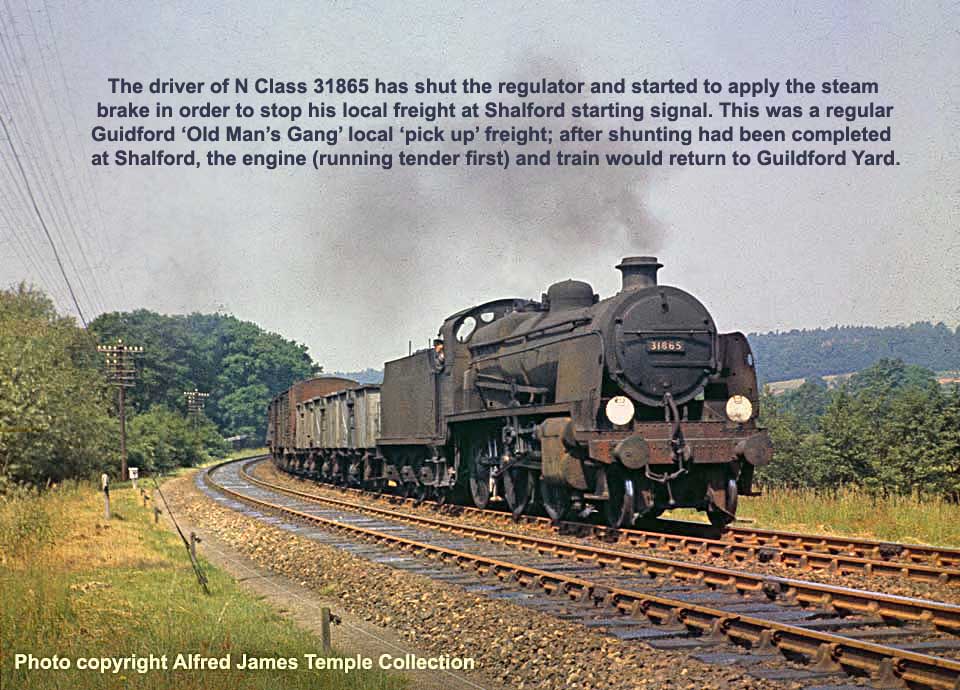
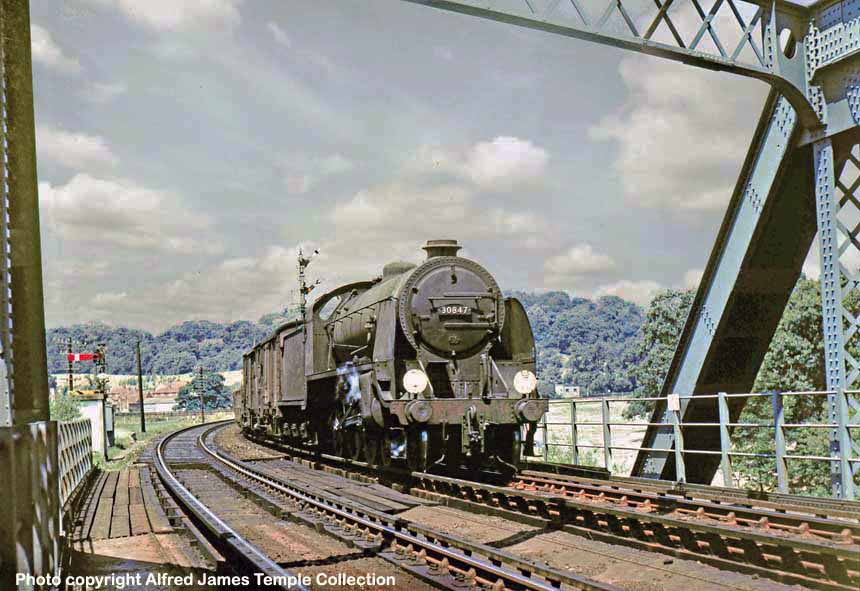
(Above-Below) S15 Class 30847 is about to pass over the Warren Truss Steel Bridge spanning the River Wey with a freight train from Guildford to Redhill. The locomotive has just passed Shalford Junction's advanced starting signal and the back of the upper quadrant distant signal for Shalford can also be seen in the clear position which gives the Driver a clear run for the uphill climb to Chilworth. (Below) Another view of the Warren Truss Steel Bridge over the River Wey at Shalford but this time featuring a stopping passenger service from Reading to Redhill approaching Shalford station. The U Class or N Class locomotives were used extensively for these services in the late 1950s early 1960s until the Diesel Electric Multiple Units (DEMUs) were introduced in 1965. 
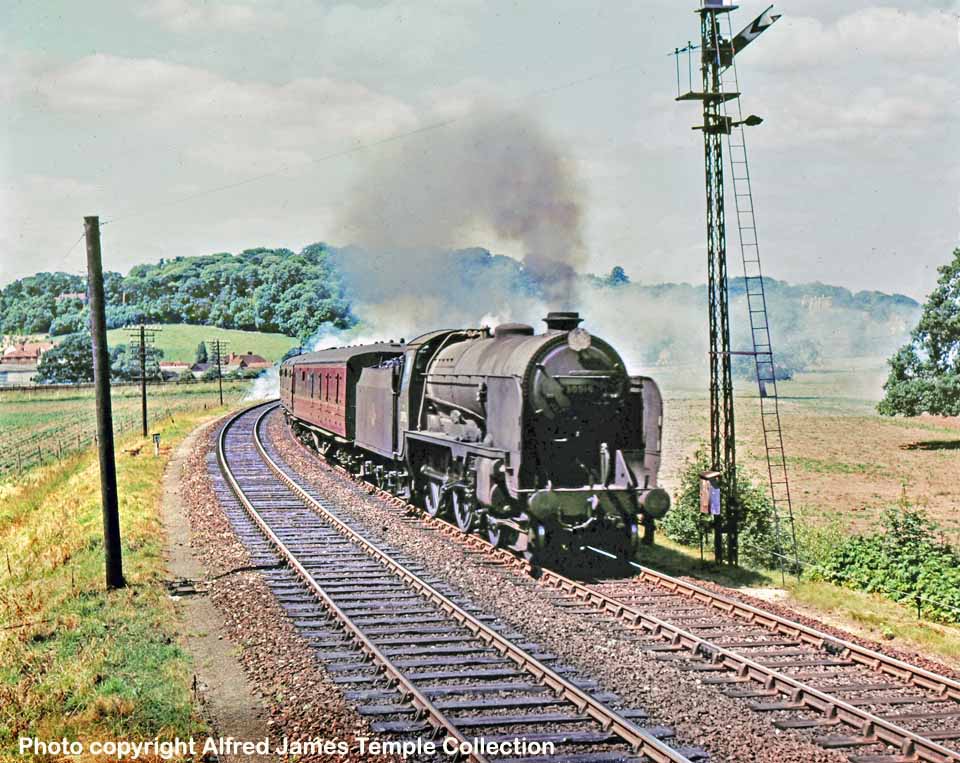
(Above) V Class 'Schools' 30914 'Eastbourne' heads towards Shalford from Guildford with 'The Continental' (affectionately known as The Conti). The eleven coach train would have started its journey that morning at Birkenhead travelling cross-country stopping at Chester (General), Wrexham, Ruabon, Gobowen, Shrewsbury, Wellington, Wolverhampton, Birmingham (Snow Hill), Leamington Spa, Banbury General, Oxford, Reading General, North Camp and Guildford. Once it left Guildford, its next stop would be Redhill where the train would divide into two portions; one for Brighton, Eatbourne, Bexhill Central, St Leonards West Marina, St Leonards Warrior Square and Hastings and the other for Tonbridge and Ashford (Kent) where the train would divide yet again with one portion for Shorncliff, Folkstone Central, Dover Priory, Martin Mill, Walmer, Deal and Sandwich - the other portion going to Canterbury West, Minster (Thanet) Ramsgate Dumpton Park, Broadstairs and Margate.
Guildford Station timings were 12.15pm Down Train) and 1.58pm Up Train). Quite a number of other cross-country trains ran on summer Saturdays which made interesting times for train spotters although the service was discontinued in 1964. Also note the lineside fire on the Down line probably caused by a passing locomotive.
(Below) U Class 31614 hauling a three-coach set comes to a stand at Chilworth station before setting off towards Gomshall with a Reading to Redhill stopping passenger service. On its way to Gomshall, it would pass a yew tree topiary shaped as a pheasant situated on the down line which commemorates a fatal accident that occurred around 1910 where a troop train became stuck. An assisting engine sent to help ran into the back of the train killing the Guard and a number of soldiers. The topiary known as 'Jesse's Seat' is still there today. 
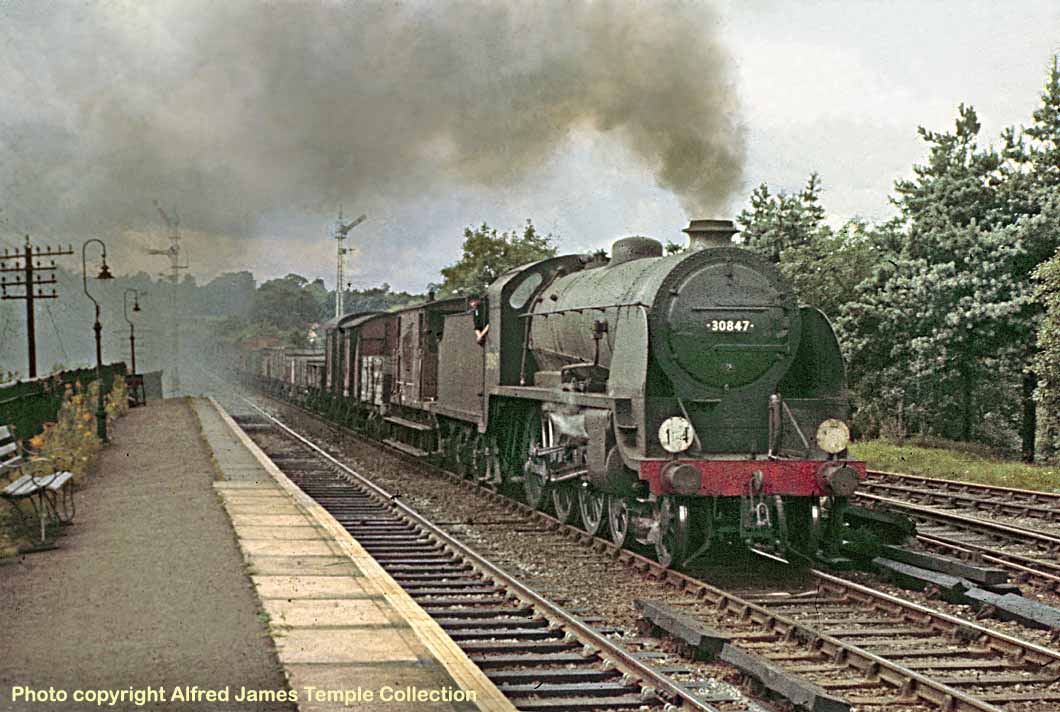
(Above) The Driver of S15 Class 30847 has opened the regulator to apply steam to the cylinders to stretch the couplings out on his loose-coupled freight train bound for Redhill Yard. The Guard riding in the brake van at the rear would have also applied his handbrake to prevent a sudden snatch in the couplings as it descends into Gomshall station and the incline to the top of Dorking Bank. In the meantime, the fireman seems to enjoying himself looking out of the cab. My regular Driver, Stan Harms, would have classed him as a 'Scenery Fireman!'
(Below) An absolute classic shot of Drummond M7 Class tank 30028 running into Gomshall station with a Redhill to Reading stopping passenger service circa 1954. Again, from my second book 'Further Ramblings of Railwaymen' Brian Davey recalls a rewarding tale: One morning while firing to Bill Hedgecock with an M7 Class locomotive, we worked a passenger train from Guildford to Redhill. On cleaning the fire at Redhill Loco prior to the return trip to Reading, I noticed that the stays in the firebox were leaking so badly, I had a job to save the fire. We went out to the station and coupled up to our train (a three-coach set) and off we went. We got as far as Dorking bank and eventually came to a halt short of steam. As we stood there trying to revive the fire, the local hunt (Surrey Union) were close by with their hounds. Once I'd managed to get enough steam, we proceeded on our way. The next day, our Shedmaster Mr Stovold called my Driver into his office and on the table was a £1 note. Apparently, the Master of the Hounds had sent it as a reward for us stopping the train for the hounds to go by in safety. Little did Mr Stovold know the real reason why we'd stopped. Bill and I shared the money, ten shillings each! 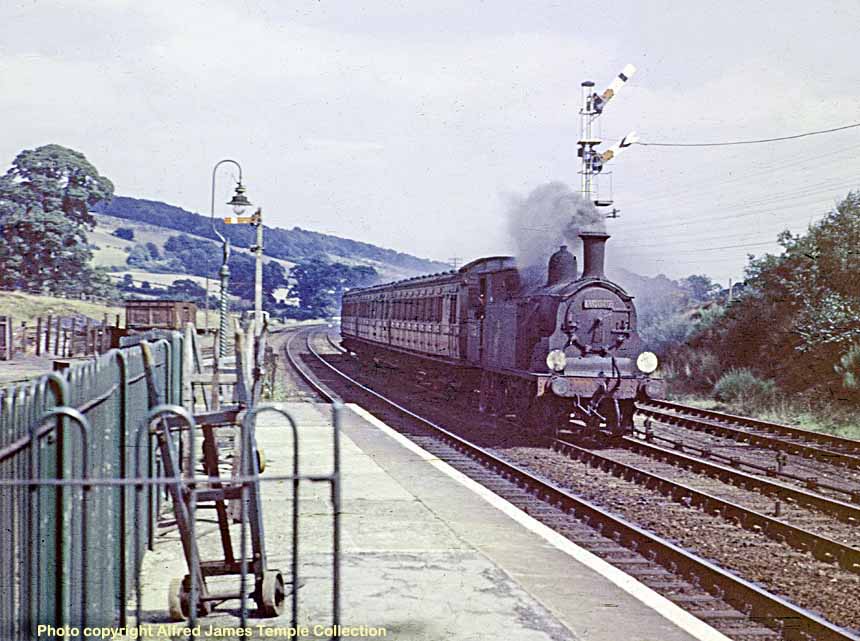

(Above-Below) Another fine shot of the 'Conti' this time headed by Class 4MT Standard 76062 as it thunders through Gomshall en-route to Redhill and the previously explained South Coast destinations. (Below) A heavy freight hauled by an unidentified U Class passes through Dorking Town station heading for the torturous climb to 'Welcome Bridge' at the summit of Dorking Bank and onwards towards Guildford and Reading. The bridge carrying White Down Lane was called 'Welcome Bridge' because a fireman on a heavy freight train up Dorking Bank was always welcome to see it! 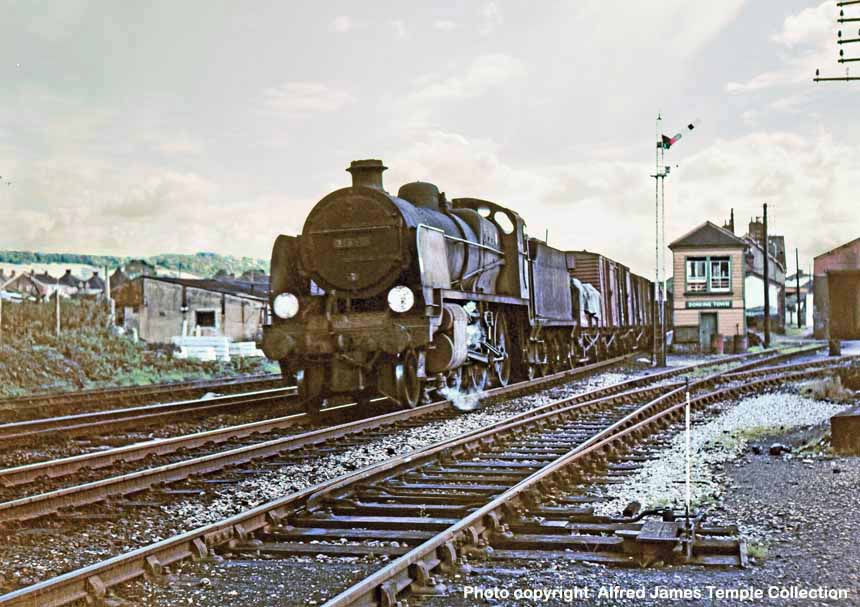
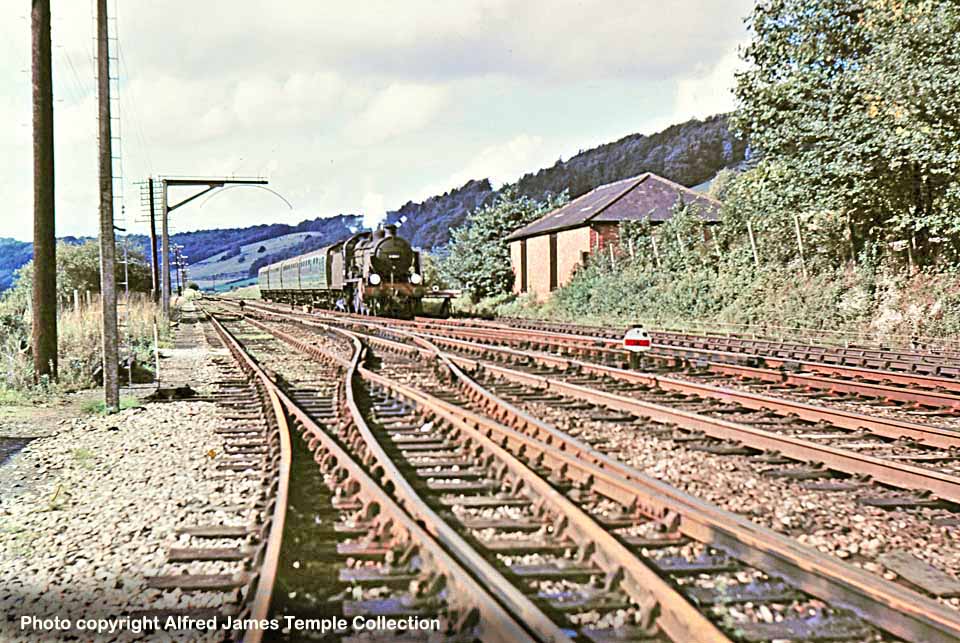
(Above-Below) Looking in the opposite direction, a stopping passenger service from Reading to Redhill runs down the bank to stop at Dorking Town station. The beautiful Surrey Hills of the North Downs can be seen in the background. (Below) Another shot from the same position shows a BR Standard Class 4MT tank with a similar service from Reading to Redhill approaching Dorking Town station. 

(Above-Below) With safety valve blowing, U Class 31638 pulls away from Dorking Town station with a Redhill to Reading stopping passenger service. Note the platelayer's trolley in the foreground of the goods yard. (Below) The Driver of N Class 31868 opens the regulator wider as his steed prepares to tackle the incline from Dorking Town station towards the summit at Welcome Bridge with a freight train bound for Guildford Yard or Reading Yard. Dorking Town station has a staggered platform and in this photograph is still adorned with gas-mantled lighting. Interestingly, a member of staff's chicken coop has been placed on the grass verge to the station and I suspect that the red Jaguar sports car in the background is owned by the photographer 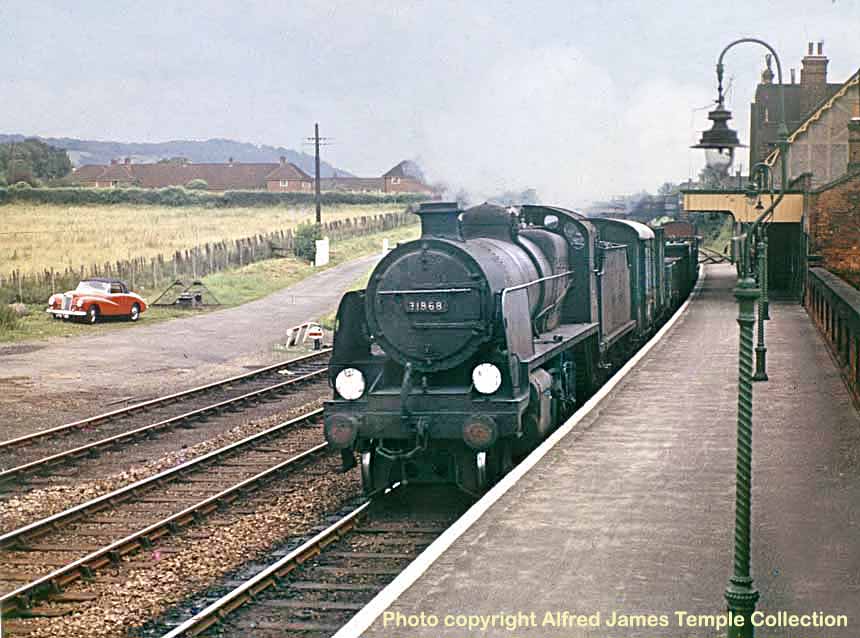
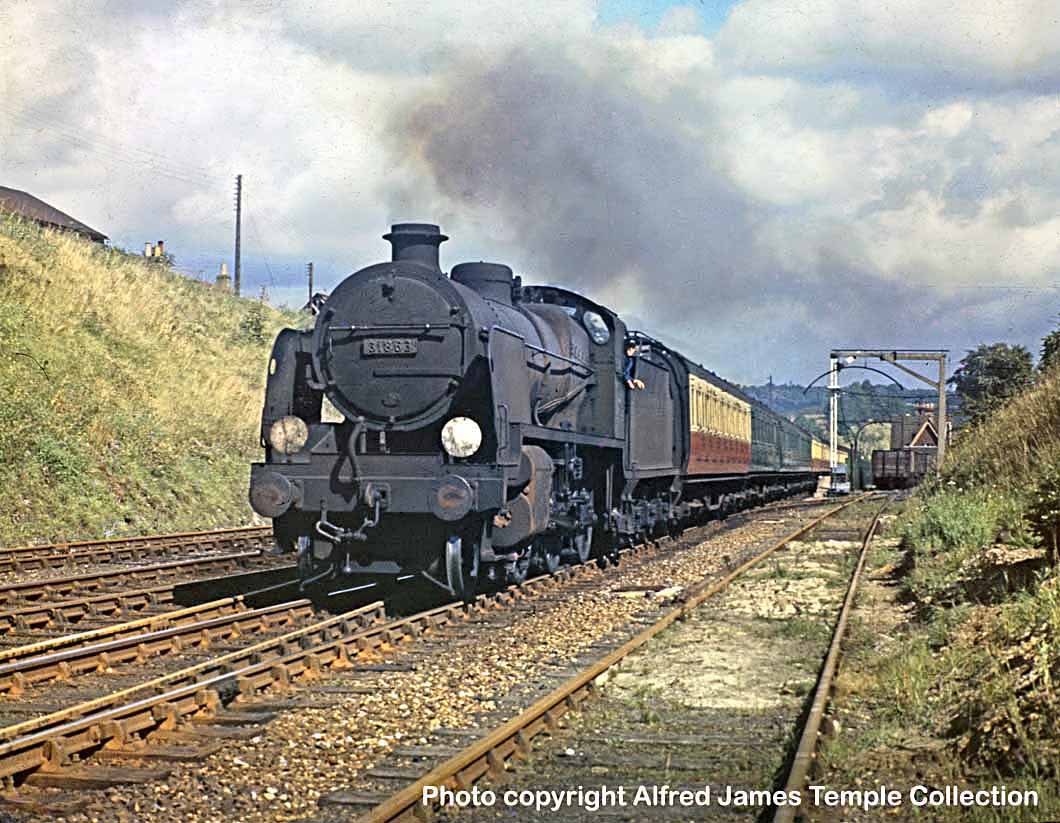
(Above-Below) The fireman of N Class 31863 looks towards the photographer as this heavy eleven-coach Saturday excursion passes through Betchworth station at speed. He won't have time to look out to admire the scenery for much longer especially from Dorking Town to the top of the incline at Welcome Bridge! (Below) U Class 31612 pulls out of Betchworth station with a Redhill to Reading stopping passenger service, its next stop being Deepdene. These services were normally made up of a three or four coach set sometimes with the occasional luggage van and the turns were worked either by Tonbridge, Redhill, Reading or Guildford crews. Note the loading gauge in the down siding. 
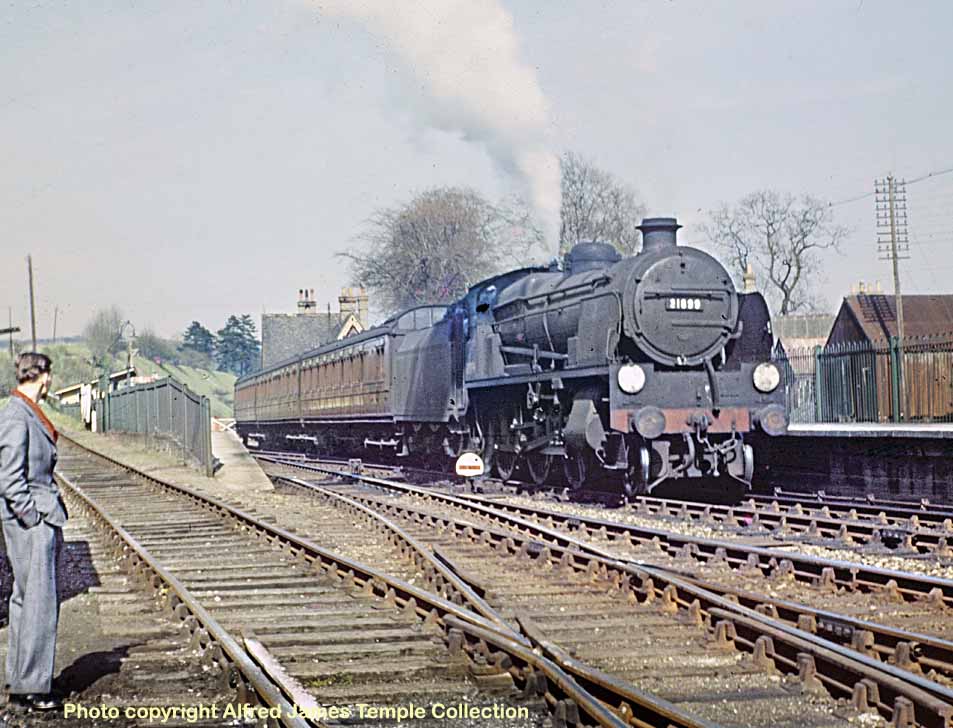
(Above-Below) With boiler pressure at 200psi and safety valve blowing, U1 Class 31899 prepares to leave Betchworth station with a Redhill to Reading stopping passenger service. The gent in the foreground seems to be wearing his 'demob' suit as he views the spectacle. (Below) Q1 Class 33009 runs light-engine through Betchworth station en-route to Guildford. I can remember being a sixteen-year-old fireman working with Driver Reg Beer taking a Q1 light-engine from Guildford to Three Bridges Loco via Redhill in 1962; the loco behaving like a Singer sewing machine as she had just been out-shopped from Eastleigh Works. 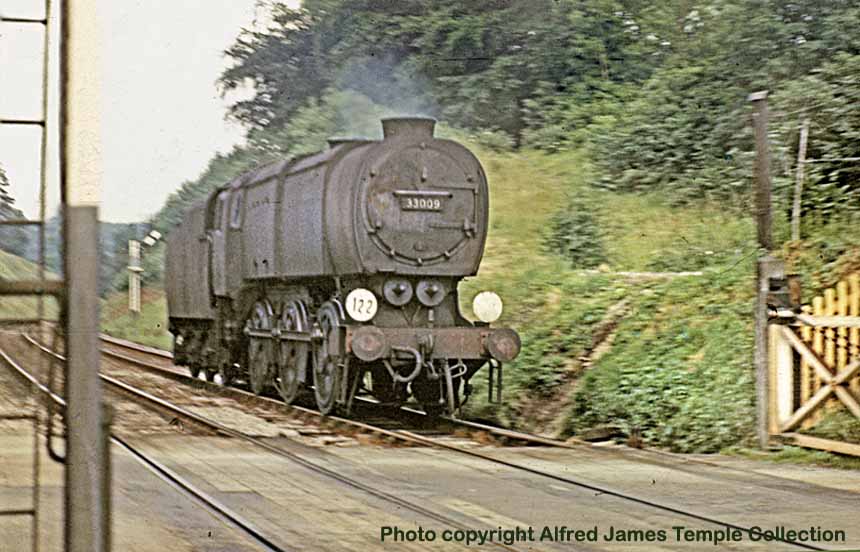
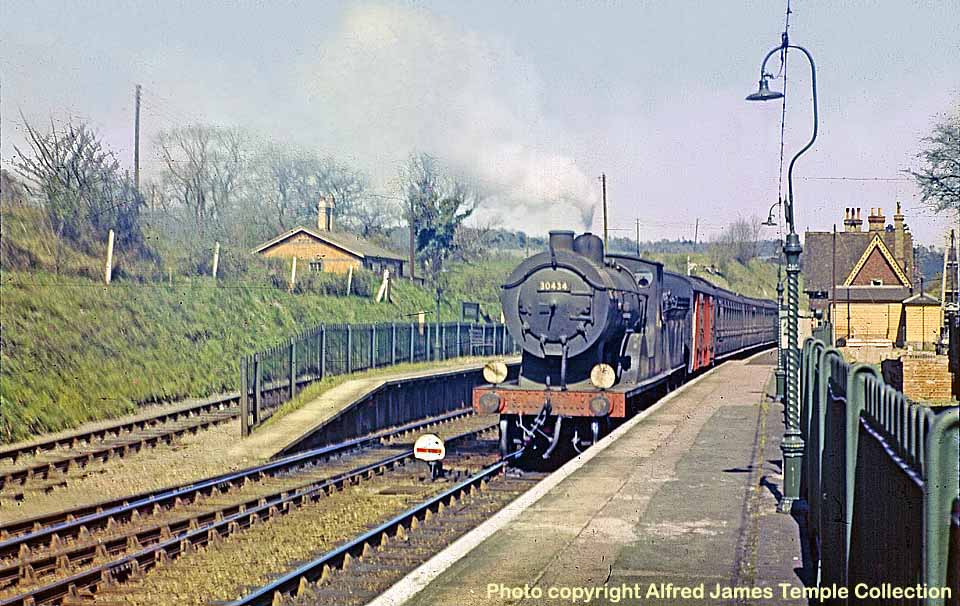
(Above) With safety valve blowing, L12 Class 4-4-0 30434 prepares to depart Betchworth station with a Redhill - Reading passenger circa 1954. Twenty of this class were built in 1904 and designed by Dugald Drummond. The class gained the nickname "Bulldogs" from their crews due to their 'butch' appearance. The L12s were initially rostered to Nine Elms, Bournemouth and Salisbury, where they worked the LSWR system on express passenger trains. It was at Salisbury that the class gained an infamous reputation, as number 421 was involved in the Salisbury high-speed derailment of 10th June 1906, resulting in 28 fatalities. The express was heading to London Waterloo from Plymouth, and failed to round a curve at the eastern end of Salisbury station, and subsequently derailed. The resultant inquiry into the incident ended the ruthless competition between the LSWR and GWR for Plymouth boat traffic. 30434 was the last of this class of loco to be withdrawn in February 1955 from Guildford shed (70C).
(Below) S15 Class 30836 heads through Betchworth station hauling a freight service from Guildford to Redhill accompanied by a 350hp diesel-electric shunter behind her tender. The 350hp shunter's gearing would have been de-meshed to allow it to run in a freight train as they were restricted to 20mph in their normal state. 
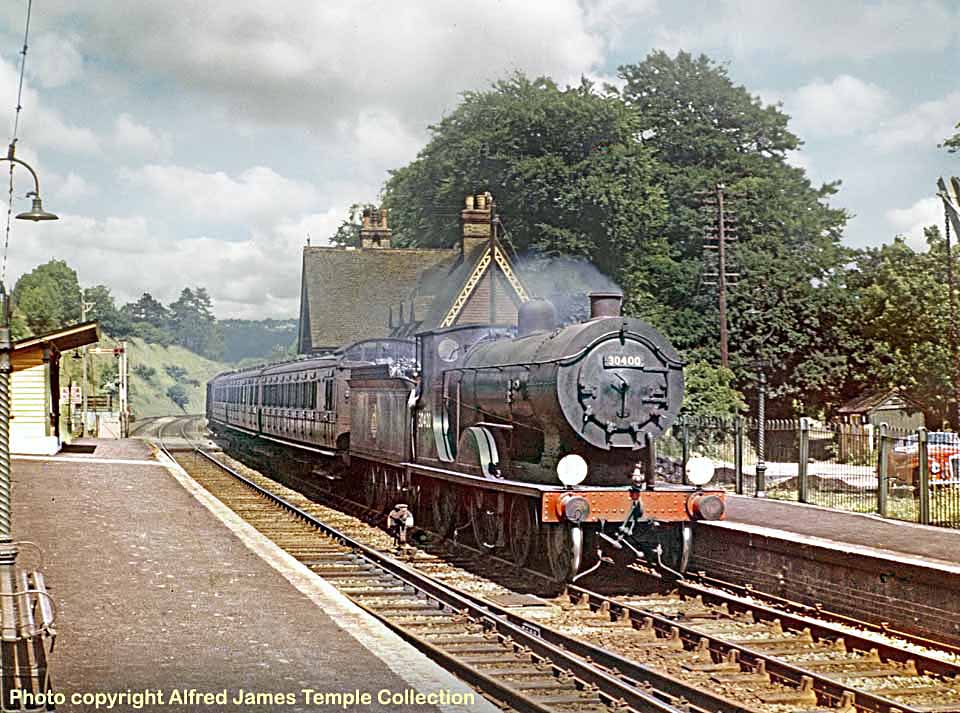
(Above-Below) Both photographs show Class S11 30400 about to depart Betchworth circa 1954. The fireman seems quite content looking out of the side. Similar to the L12 Class, ten of these 4-4-0 steam locomotives were designed for express passenger work by Dugald Drummond. Again, the last loco withdrawn from service was 30400, in February 1955 from Guildford shed (70C). The photograph above also includes the red Jaguar Sports Car which suggests that it did belong to the photographer! In my second book 'Further Ramblings of Railwaymen' Brian Davey confirms that he and his Driver Bill Hedgecock worked the 3.04pm from Redhill - Guildford with 30400 and this was the last time that she was used on a passenger service. 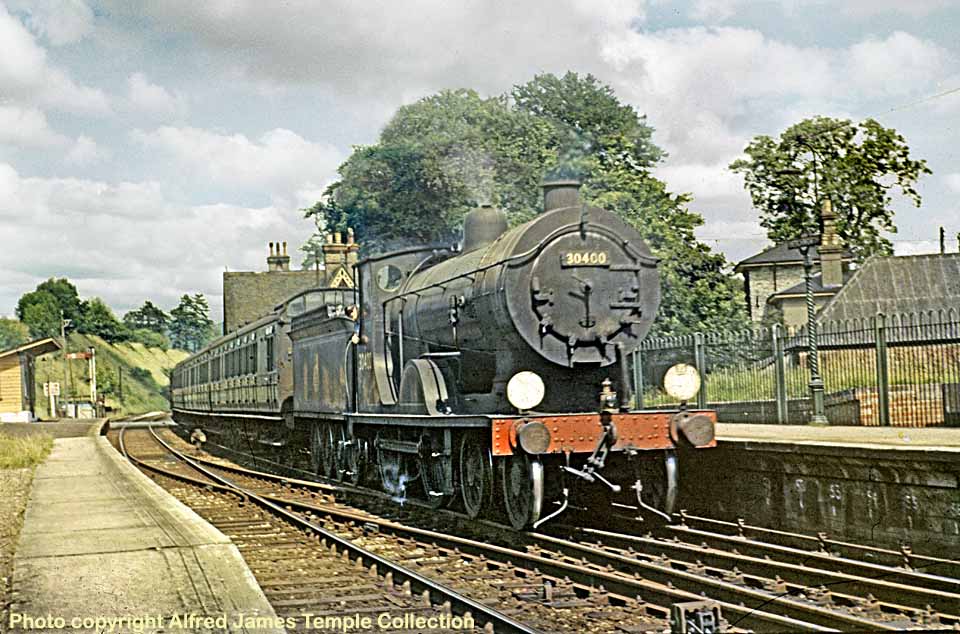
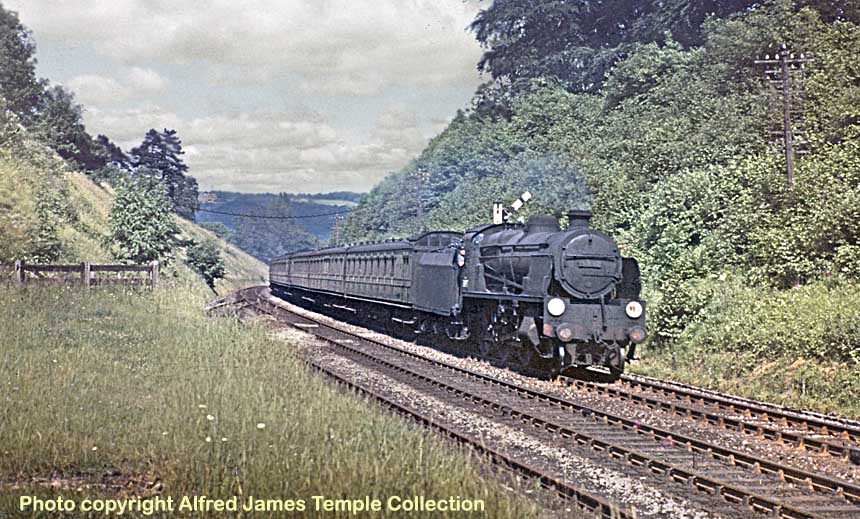
(Above-Below) An unidentified 3-cylindered N1 / U1 Class hauling a stopping passenger service passes the home signal for Betchworth station in preparation to stop at Betchworth station before heading for Guildford and its final destination Reading. Because of the tight curvature and therefore difficult signal sighting, a banner-repeater signal preceded the home signal to give an earlier indication to the Driver of the home signal's position should the distant signal have been passed at caution. (Below) Ex-GWR Class 4300 2-6-0 No. 5368 hurtles through Betchworth with a Saturday return South coast seaside excursion bound for Reading General station and further afield onto Western metals. Designed by Churchward and built at Swindon in 1920, these locomotives were powerful workhorses and quite capable of working heavy passenger trains over this route. 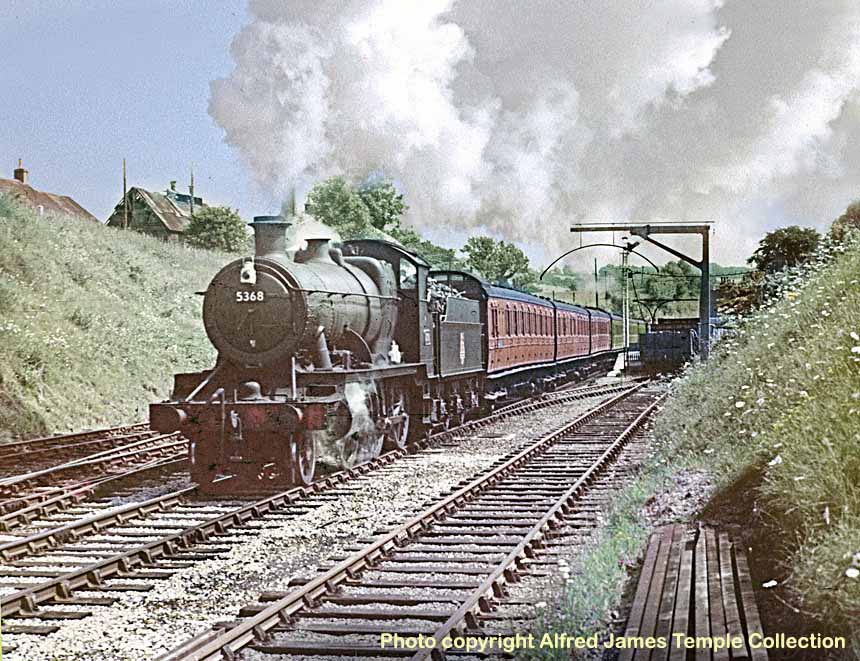
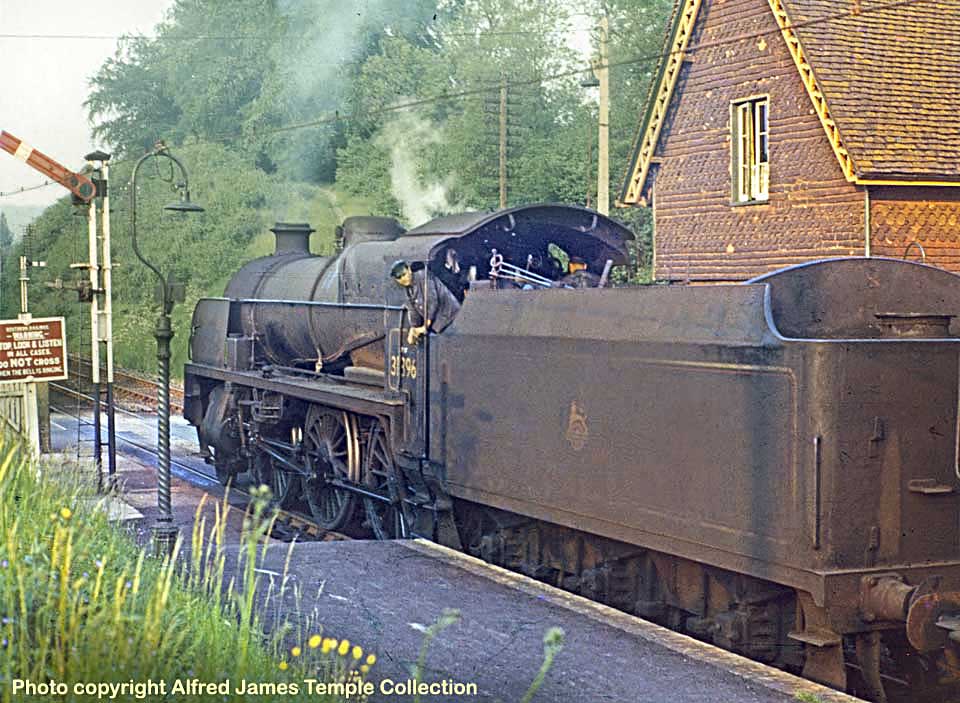
(Above-Below) With Betchworth's semaphore starting signal in the clear position, the fireman looks back for the Guard's green flag as U1 Class 31896 prepares to leave Betchworth station with a stopping passenger service from Reading to Redhill. These 3-cylinder locomotives were a development of Maunsell's U Class, and numbered 31891-31910; all were withdrawn by July 1963. (Below) V Class 'Schools' 30914 'Eastbourne' stands outside Redhill Shed looking the worse for wear and has probably been withdrawn from service which dates this photograph pre 31st July 1961. After Oliver Bulleid succeeded Maunsell as CME of the Southern Railway, he modified three engines of the class (this being one of them) with Lemaitre multiple-jet blast pipes. Three 'Schools' Class were based at Guildford Loco when I joined as an engine cleaner in 1961, 30903 'Chartehouse', 30906 'Sherborne' and 30909 'St Paul's' and all suffered a similar fate and being withdrawn the following year. 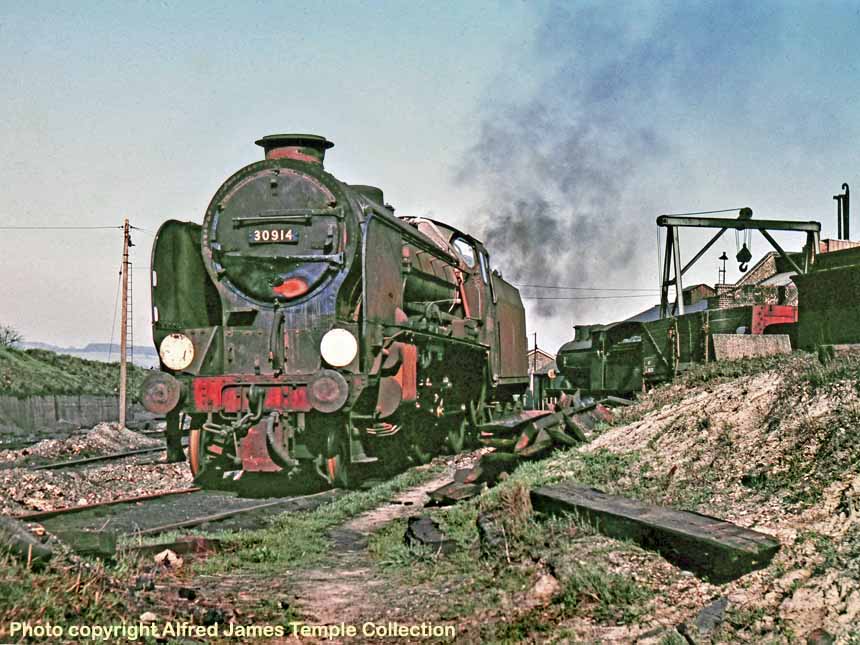

(Above-Below) V Class 'Schools' 30936 'Cranleigh' has just been turned on Redhill Loco's turntable before returning to the station to work a Redhill - Reading passenger service. Soon after it was built in 1935, the locomotive (then numbered 936) was put on display at Cranleigh station so that locals (especially boys at the school it was named after) could have a good look around it. (Below) BR Standard Class 4MT 80013 leaves Redhill with a Tonbridge stopping passenger service. The station stops will include, Nutfield, Godstone, Edenbridge, Penshurst, Leigh Halt and finally, Tonbridge. The service would then terminate and the train formation would return to Redhill and then make a Reading service via Guildford. 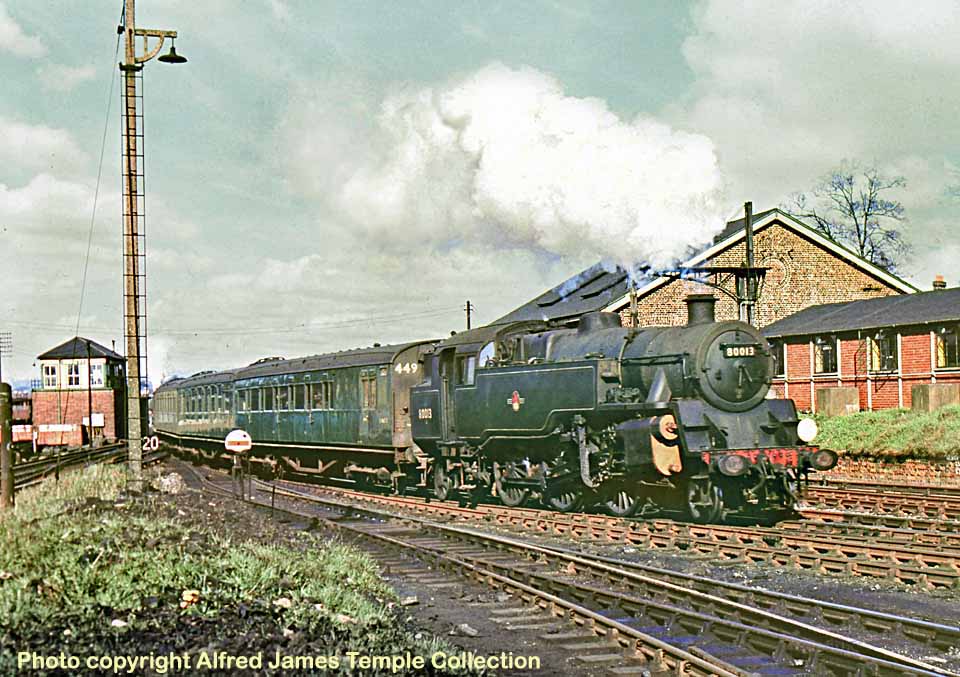
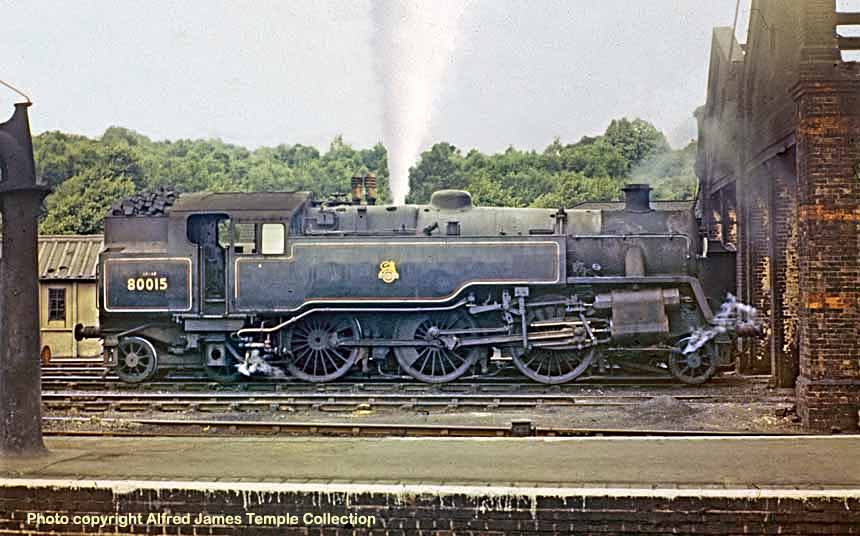
(Above-Below) BR Standard Class 4MT Tank 80015 blows off steam from her safety valve outside Tunbridge Wells West shed (75F). This type of locomotive featured extensively on the Reading to Redhill line towards the end of steam as some of the U and N Class were withdrawn from service. (Below) A young fireman takes no notice of the 'No Walking Along the Track' prohibition sign as he takes a short-cut alongside the reception line on his way to work at Redhill Loco. He's more interested in watching BR Standard Class 4MT 80016 working a stopping passenger service from Redhill to Tonbridge. 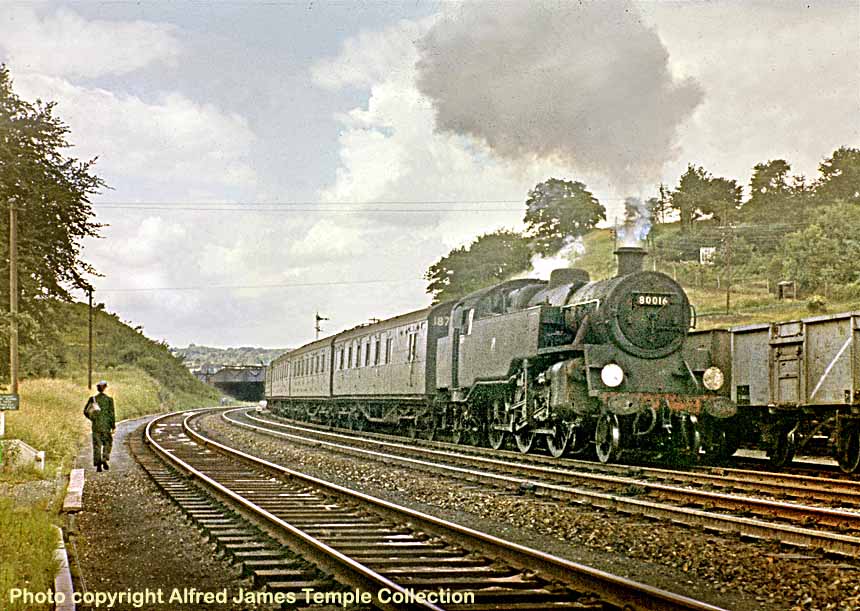
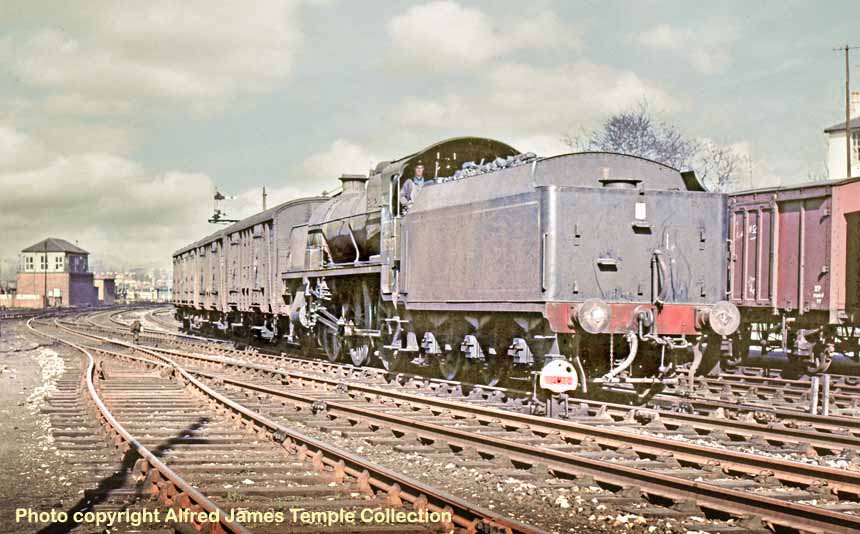
(Above) The fireman of U1 Class 31903 keeps a sharp look out as the loco shunts some vans at Redhill. The outgoing line from the Loco to Redhill station can be seen on the extreme left of the photograph. Redhill had two Signal boxes, Redhill 'B' Box being depicted. Redhill 'A' Box was situated at the London end of the station. 
(Above-Below) N Class 31407 takes charge of a freight train from Redhill to Tonbridge as the second of the Derby-built Pilot Scheme Type 2 diesel-electric locomotive D5001 awaits its turn in the Yard. D5001 officially entered service on the London Midland Region in October 1958, but in January 1959 the Southern Region requested a number of Type 2 locomotives for a short period pending the arrival of the BRCW Type 3s and the completion of the North Kent electrification scheme. The LMR obliged by sending fifteen new Class 24s to Hither Green (73C), including D5000 and D5001, which after arrival on the Southern Region were initially used for crew training in the Ashford-Ramsgate-Dover-Faversham area. By 1962 the SR's temporary shortage of power was over; the Kent Coast scheme was up and running and delivery of the new BRCW's Type 3s had commenced; this led to the borrowed LMR Type 2s being returned back to depots north of the Thames, with D5001 going to Willesden (1A) in August 1962. 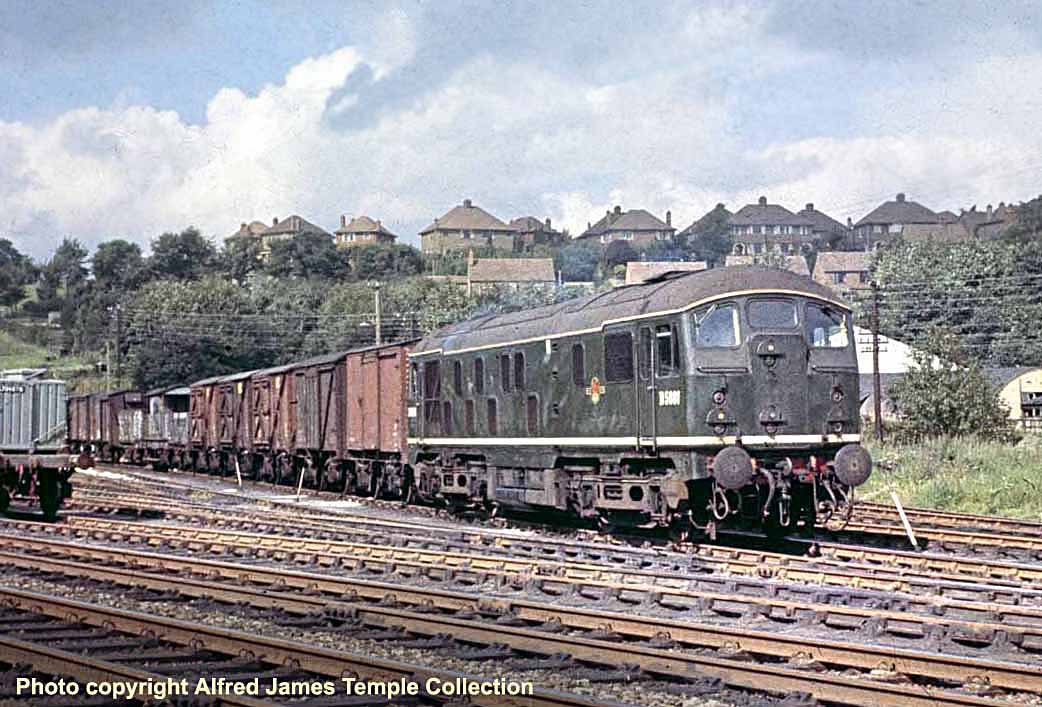
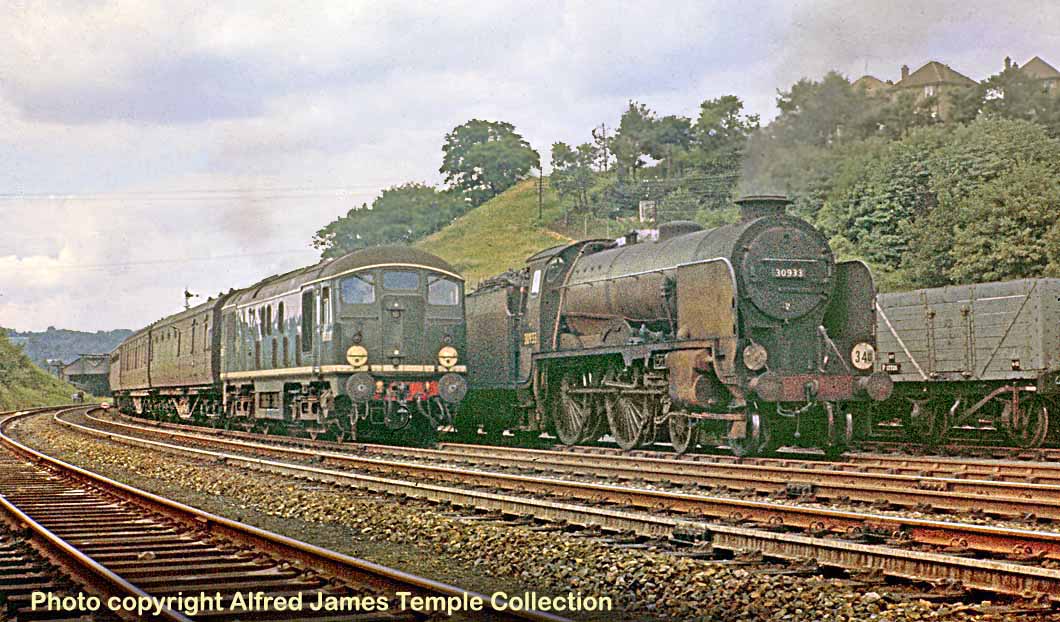
(Above) Type 2 Diesel-Electric D5010 heads a special excursion past Redhill Yard to the Kent Coast as V Class 'Schools' 30933 'King's Canterbury' waits her turn to work a freight train to Tonbridge.
A final selection of colour photographs from the Alfred James Temple Collection.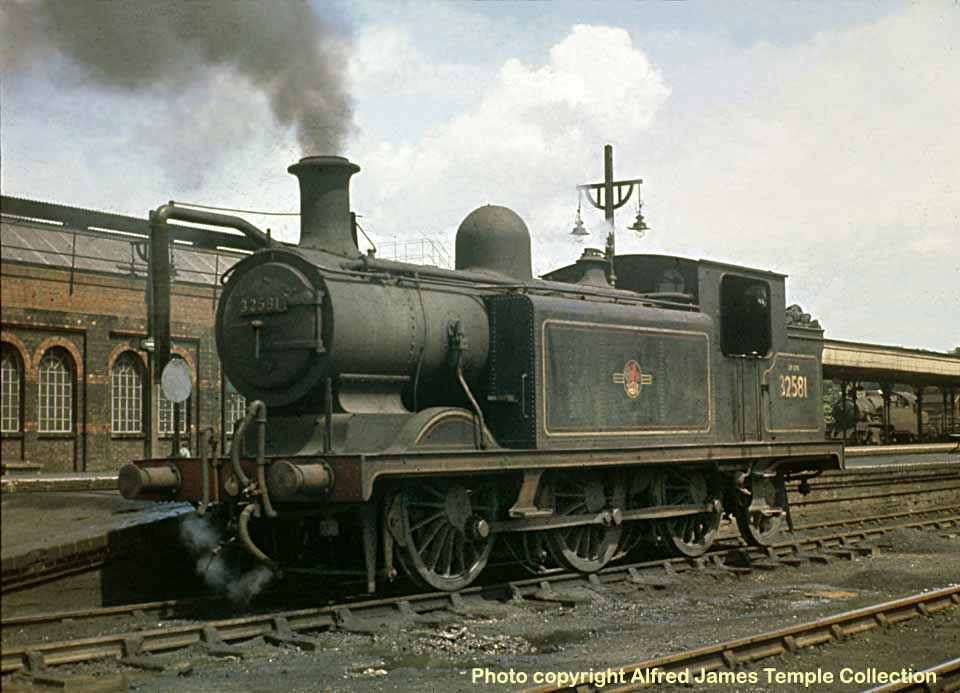
(Above) E4 Class 32581 is a class of 0-6-2T side tank steam locomotive designed by Robert Billinton and introduced in 1897. I've an idea that these locomotives were used to work trains over the Eridge branch - Can anyone enlighten me please?
Both the mystery photos above and below are now solved, thanks to Leon Coast, who writes - 'The E4 photo is at Tunbridge Wells West; these locos appeared on the Cuckoo line service from Eastbourne to Tunbridge Wells via Eridge on both passenger and goods. My thanks also to Bernie Oliver, who adds - 'This is a long-serving TWW engine carrying the left boiler headcode which is Three Bridges - TWW or return. The E4's were used on goods and some passenger turns throughout the Fifties and early Sixties.
(Below) The L class 4-4-0 tender locomotives were built for express passenger service on the South Eastern and Chatham Railway (SECR). Although designed by Harry Wainwright, they were built during the Maunsell era. Bernie Oliver writes - 'This is an arrival at Tunbridge Wells West Platform 3 with a train from Brighton for Tonbridge. No 31770 was a Tonbridge engine from 1952 to 1959; the date is probably before 1959 when 31770 was sent from Tonbridge to Nine Elms. Victoria train departing from platform 5 Tunbridge Wells West. Note the ancient crimson painted pull/push set in bay platform 1, probably a Three Bridges - TWW shuttle service. 
(Below) A double-headed passenger service prepares to leave Tunbridge Wells West station. Q Class 30533 is the pilot engine and an unidentified BR Standard Class 4MT tank is the train engine. I would love to hear from anyone with information regarding this train and its destination...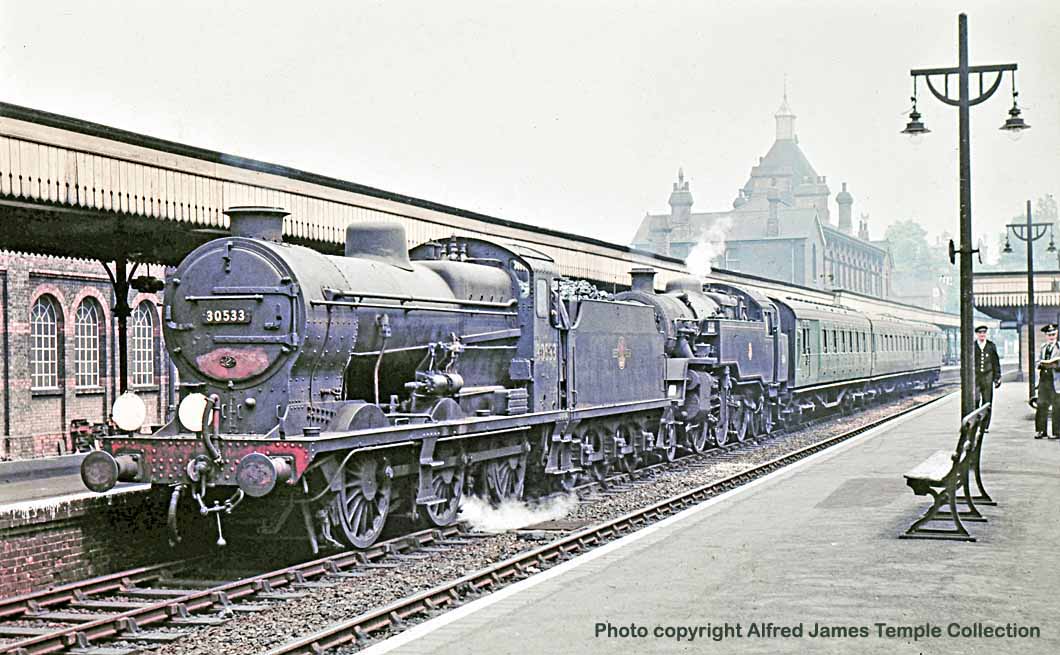
(Above) My thanks to LCGB member Andrew Foster, who writes: 'On Wednesday 12 November 2014 Geoff came to LCGB Dorking and gave a fascinating illustrated talk. One of the pictures from the Alfred Temple collection he showed was of a train standing at Tunbridge Wells West with 2 locos with 3, possibly corridor, coaches. He wasn't sure of the headcode on the lead engine and at the time I suggested it could be a service that would run via Eridge, Mayfield, Hailsham and Polegate.
I spoke to Geoff after the meeting and said that I travelled a lot on this line with my parents to visit relatives near Hailsham and Tunbridge Wells and was aware that the inner loco being a Standard 4MT could have been on a running in turn after manufacture at Brighton although a number were also kept at Eastbourne for this duty prior to closure in the early 1960's. Having done a bit of research since Wednesday I can proffer the following information. The leading loco 30533 is a Q class that entered service in July 1938 and was withdrawn in March 1963. I don't know where it was scrapped but it could have been Eastleigh. The headcode on the front is given in a list of standard codes as a possible empty stock move, however I was recently given a number of old Ian Allan ABCs and at the front of an April 1946 Southern edition there is a detailed list of headcodes under each of which are detailed a number of journeys one of which for the disc arrangement on the loco is Tunbridge Wells West and Eastbourne. It may have been done as a double  headed service to take the Q class loco down the line to avoid having to do a light engine move particularly as that route was mostly single track with token exchange. The picture is probably taken in the period between 1951 when the first Brighton built 4MTs became available and the early 1960s when some diesel traction was used on the route. Having had a look your website it has an incredible range of pictures. I must remember to use it when I want to research an area or period of time. I hope my comments are of use. Regards Andrew Foster...'
headed service to take the Q class loco down the line to avoid having to do a light engine move particularly as that route was mostly single track with token exchange. The picture is probably taken in the period between 1951 when the first Brighton built 4MTs became available and the early 1960s when some diesel traction was used on the route. Having had a look your website it has an incredible range of pictures. I must remember to use it when I want to research an area or period of time. I hope my comments are of use. Regards Andrew Foster...'
(Right) Cover of the Ian Allan ABC April 1946 Southern edition. Click HERE to visit Dave Rowland's 'Famous Ian Allan ABC Books'; a lovely website and beautifully illustrated, featuring the covers of every conceivable spotters' book published…the site is a veritable trip down memory lane to boyhood days.
(Below) BR Standard Class 4MT 75074 heads a passenger service from Tunbridge Wells West station to an unknown destination. Unfortunately, my route knowledge on the Central Division was somewhat limited - can anyone help please with the destination of this train with this headcode?
My thanks again to Andrew Foster for coming to the rescue with information gleaned from the Ian Allan ABC of Southern Locomotives dated April 1946 Southern Edition. He writes - 'The headcode shown in the ABC has among the list of routes 'Victoria, Oxted and Tunbridge Wells West via Hever'. Presumably the same headcode was used for the return journey as well…'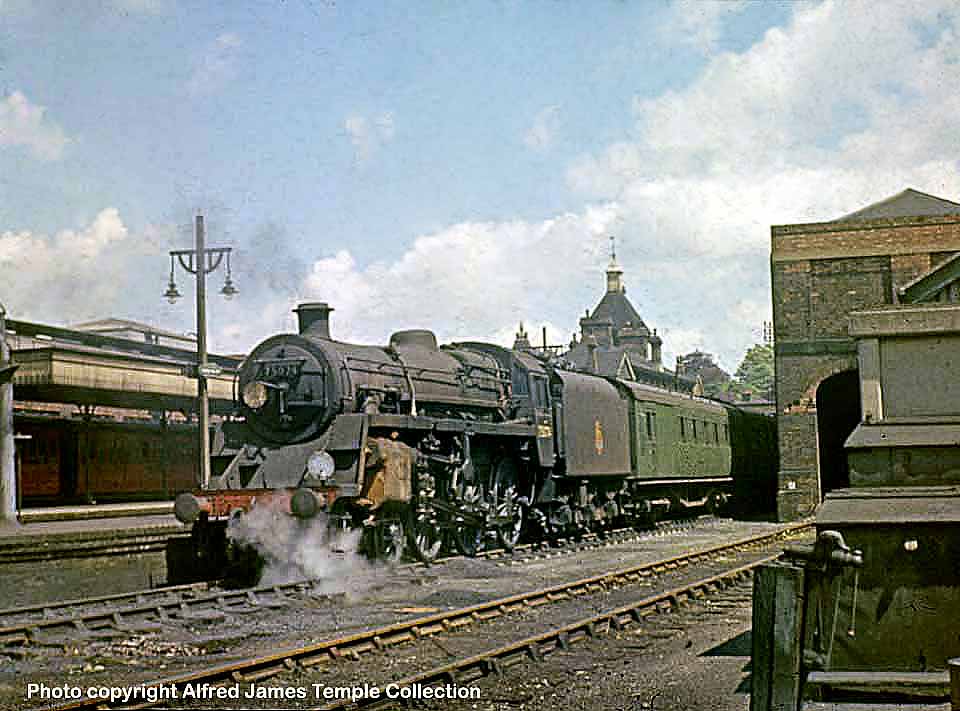
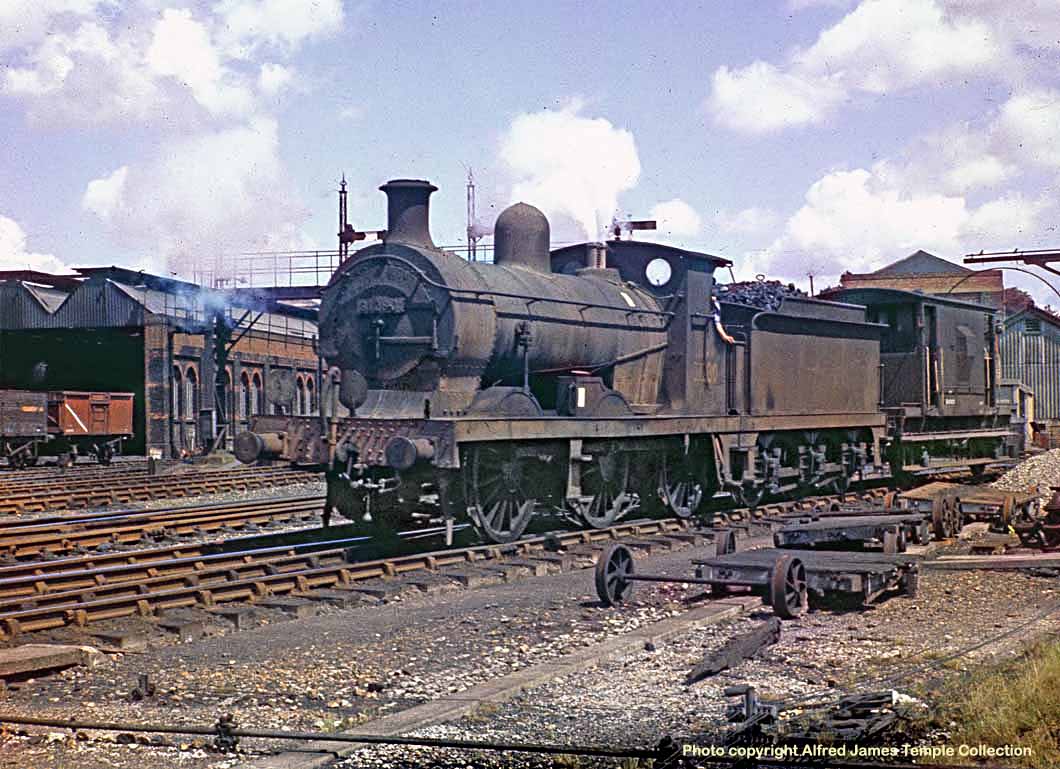
(Above) C Class 31280 stands outside Tunbridge Wells West shed with a solitary brake van in tow. Designed by Harry Wainwright and built at Ashford works in 1908, the C Class was designed for working freight duties but were sometimes used on passenger services. When new, they were painted in the Wainwright goods livery, not quite as ornate as his famous passenger locomotive livery, but a dark green with full and complex lining. They finished their days in plain BR black. 31280 was withdrawn from service on 31st December 1963 and cut up at Ashford works. My thanks to Bernie Oliver, who writes - 'This is another Cuckoo Line train. The engine is probably assembling a goods working for Polegate. Note that this is a post-1959 view as the wooden posted signal gantry was replaced with a steel structure in that year. Also TWW closed to goods at the end of 1961…'
(Below) Bernie Oliver writes - 'This picture looks like it was taken from Birchden junction signal box and the train is approaching Eridge on the main line from Oxted; the branch to the right leads to Groombridge and Tunbridge Wells West…' Thanks Bernie.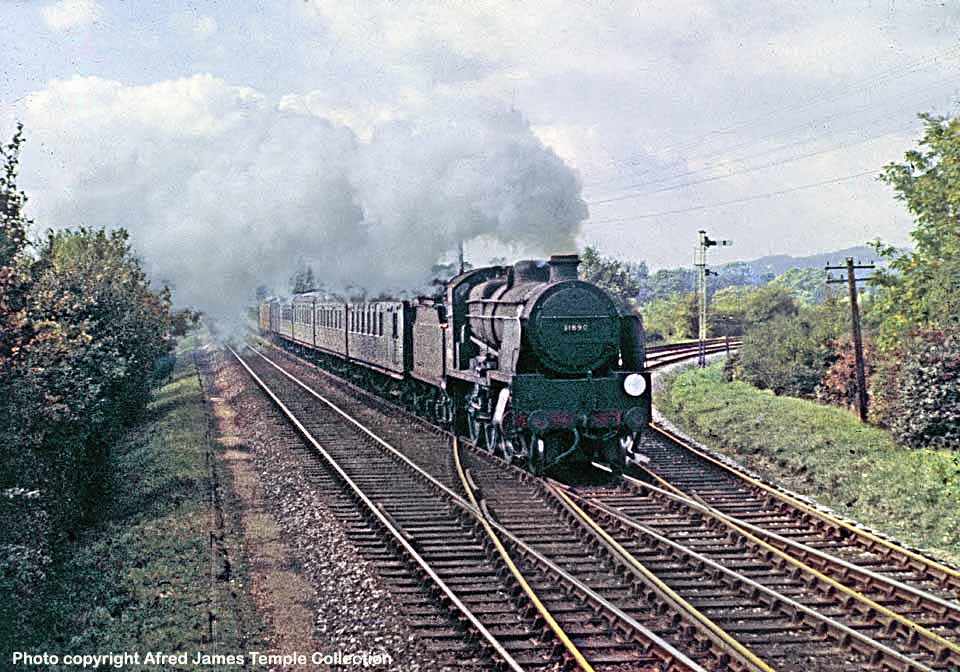

(Above) BR Standard 2-6-4T No 80014 at Tunbridge Wells West shed. (Below) We finish the page with this splendid shot of Eastleigh station as Rebuilt Merchant Navy Class 35027 'Port Line' charges towards London with the Up 'Bournemouth Belle' on 25th April 1962. For some reason, the locomotive is not carrying the 'Bournemouth Belle' headboard. A cautionary notice is displayed on the end of the platform which warns enginemen and others of the locomotive department not to walk along the railway from the station to the loco yard - something I admit to doing when needing to catch an earlier train home! Eastleigh Locomotive works can be seen to the left of the photograph.
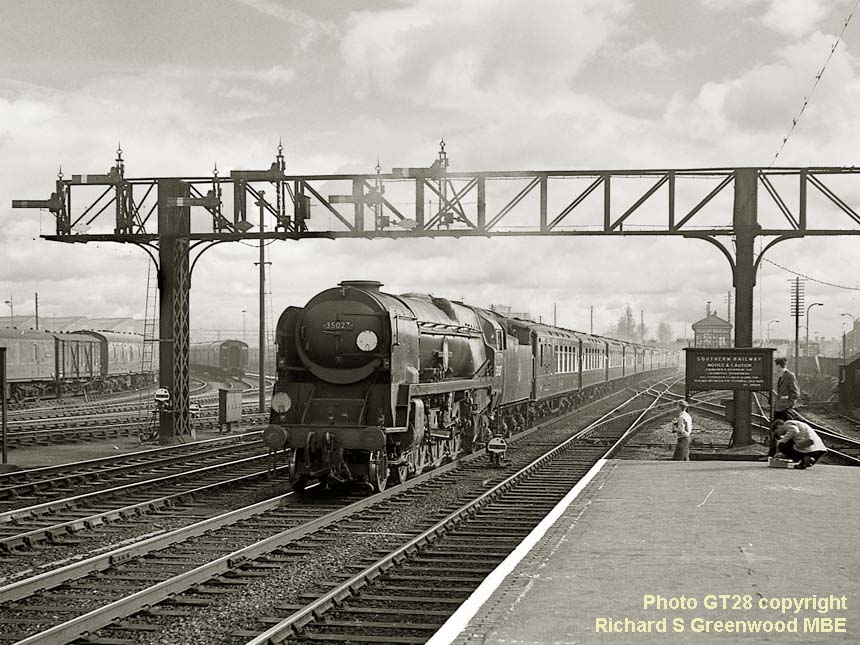
Geoff Burch's contact details can be found HERE.
Polite notice: All text and photographs are protected by copyright and reproduction is prohibited without the prior consent of the © owners. If you wish to discuss using the contents of this page the email address is below. Please note - this is not a 'clickable' mail-to link via Outlook Express. You will have to email manually.
dheycollection@ntlworld.com

